

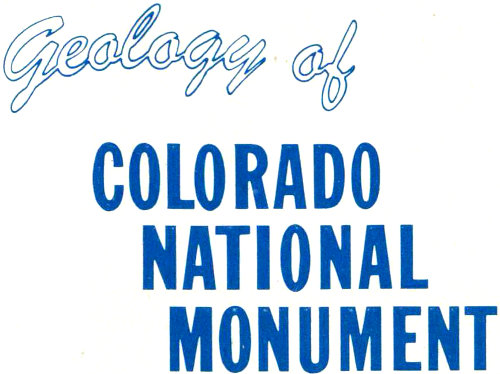
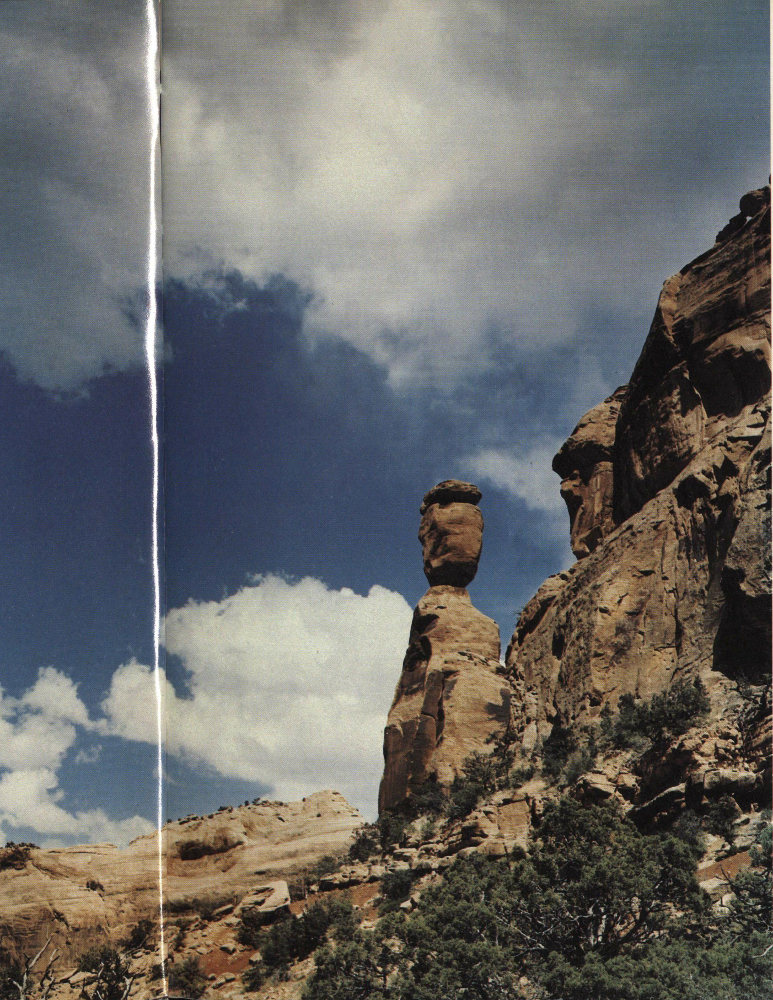
BALANCED ROCK, near head of Fruita Canyon. Spire and rock are Wingate Sandstone resting on red Chinle Formation; thin caprock is protective layer of resistant Kayenta Formation. (Frontispiece)
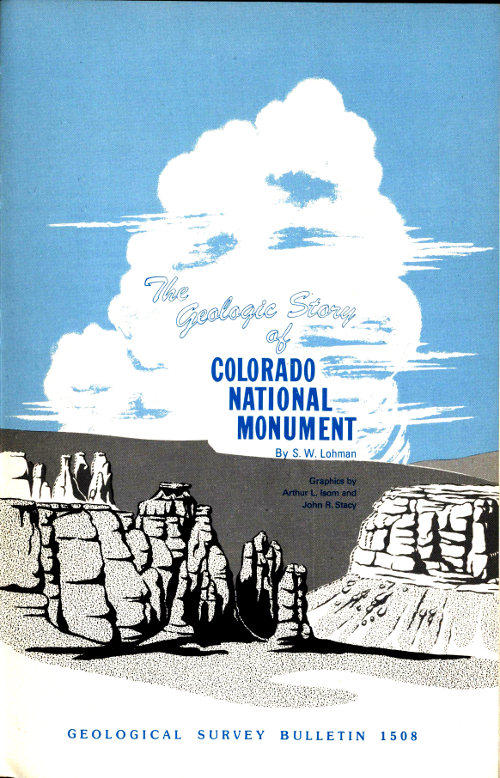
By S. W. Lohman
GEOLOGICAL SURVEY BULLETIN 1508
UNITED STATES DEPARTMENT OF THE INTERIOR
JAMES G. WATT, Secretary
GEOLOGICAL SURVEY
Doyle G. Frederick, Acting Director
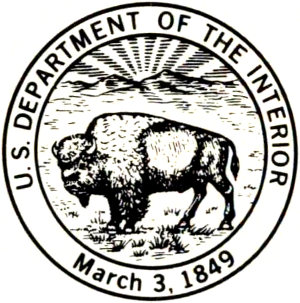
For sale by the Superintendent of Documents, U.S. Government Printing Office
Washington, D.C. 20402
From 1946 until about 1956 I carried out fieldwork intermittently on the geology and artesian water supply of the Grand Junction area, Colorado, the results of which have been published.[1] The area mapped geologically contains about 332 square miles in the west-central part of Mesa County and includes all of Colorado National Monument. During the fieldwork several successive custodians or superintendents and several park naturalists urged that upon completion of my professional paper I prepare a brief account of the geology of the Monument in terms understandable by laymen, and which could be sold at the Visitor Center. This I was happy to do and there resulted “The geologic story of Colorado National Monument,”[2] published by the Colorado and Black Canyon Natural History Association in cooperation with the National Park Service. This report contained colored sketches by John R. Stacy and a colored cover, but the photographs and many of the drawings were reproduced in black and white.
Later, after I had prepared popular style reports containing mostly color photographs on Canyonlands[3] and Arches[4] National Parks, officials of Colorado National Monument and I discussed the possibility of preparing a revised and enlarged edition of my 1965 report containing mainly color photographs, inasmuch as the supply of the black and white edition was nearing exhaustion, and later became out of print. At the meeting in the Monument on June 8, 1976, attended by Robert (Bob) E. Benton, Superintendent, A. J. (Jerry) Banta, Supervising Park Ranger, Margaret Short, Park Naturalist and Secretary of the Natural History Association, and me, it was agreed that: (1) A revised and enlarged edition containing mostly color photographs should be prepared for publication as a bulletin of the U.S. Geological Survey, and (2) that the XII Colorado and Black Canyon Natural History Association gave its permission for use of any or all of the copyrighted material in the first edition. The present report resulted.
The cover is a duotone of a 9- × 12-cm infrared photograph of Independence Monument taken by me. (See also fig. 6.) Most of the color photographs were taken by me on 4- × 5-inch or 9- × 12-cm tripod mounted cameras using lenses of several focal lengths, but I took some with 35-mm cameras. Some of the color photographs and all the black and white ones were taken by those credited in the captions, to whom grateful acknowledgment is made. The points from which most of the photographs were taken are shown in figure 26.

West side of Otto’s Monument

The story of how Colorado National Monument came into being is as colorful as the canyons and cliffs themselves. The fantastic canyon country had a magical attraction for John Otto[5] (fig. 1) who, in 1906, camped near the northeastern mouth of Monument Canyon and began building trails into the canyons and onto the mesas—the high tablelands that separate the deep canyons. He did this back-breaking work simply because he wanted to and so that others could share the beauty of this wild country.
In 1907 Otto got the Grand Junction Chamber of Commerce to petition Secretary of the Interior James A. Garfield to set aside the area as a National Monument. Otto’s dream came true on May 24, 1911, when President William Howard Taft signed the proclamation creating the Monument. On June 14, Otto climbed to the top of Independence Monument (fig. 6) where he placed the Stars and Stripes to celebrate Flag Day. For several years thereafter Otto placed the flag atop Independence Monument on July 4th to celebrate Independence Day.
Until about 1921 the only routes into the Monument proper were John Otto’s trails, but in that year the ranchers of Glade Park joined with Otto in building the steep, twisting Serpents Trail from No Thoroughfare Canyon to the mesa above—a much shorter route to Grand Junction. It had 54 switchbacks and climbed about 1,500 feet in 2½ miles. The Serpents Trail was included in the Monument in 1933 and was used until 1950 when an easier route was built up the west side of No 2 Thoroughfare Canyon and through a tunnel to the top of the mesa (figs. 3, 56). The Serpents Trail has been preserved as an interesting foot trail (fig. 55), which can be hiked downhill in an hour or so. A parking area near the foot of the trail allows one member of a group to drive ahead to await the others.
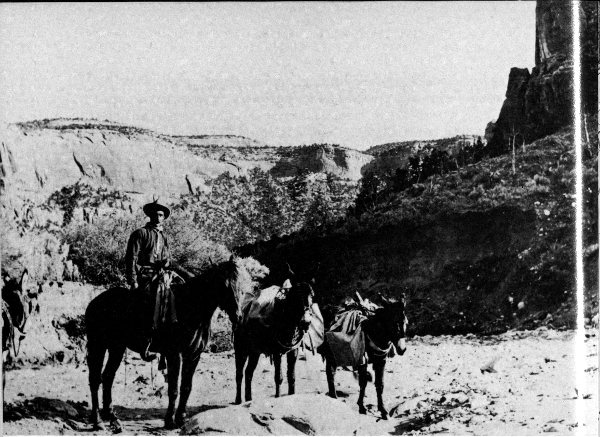
JOHN OTTO, fantastic father of Colorado National Monument, and his helpers. Photograph courtesy Grand Junction Chamber of Commerce. (Fig. 1)
In 1924 John Otto got the idea that the Monument should include a herd of big game, so he talked the Colorado Game and Fish Department into shipping six young elk, and he got the local Elks Lodge to pay the transportation costs. The elk were turned loose in Monument Canyon, but they found the sparse vegetation and scant water supply ill suited to their needs, so after a few years they found a way out over the rim and migrated about 20 miles south of the Monument to lush high country where they joined with native elk and multiplied to become the ancestors of the present fine herd on Piñon Mesa (shown in fig. 34D). Occasionally a few return to the Monument and may be seen mainly in Ute Canyon. Native mule deer are frequently seen in and near the Monument.
Far from being discouraged, Otto then hatched the idea to 3 start a buffalo[6] herd to be purchased by donations of buffalo nickels from school children and by contributions from the Odd Fellows and others. He finally raised enough money to get the patient Game and Fish Department to send him two cows and one bull. Unfortunately the bull died, so Otto talked the National Park Service into shipping him a bull from Yellowstone National Park. This time success crowned his efforts, and the small herd eventually multiplied to as many as 45 animals, but generally the herd has been kept at about 20-25 head ever since. You may spot some of them when you gaze down into Monument or Ute Canyons or when you drive past the northeastern boundary. Rarely, you may spot one in Red Canyon.
At the northeast corner of Fourth Street and Ute Avenue in Grand Junction is a most unusual object, which illustrates yet another peculiarity of John Otto—fantastic father of Colorado National Monument (fig. 2). Its history is best told by quoting from Al Look,[7] though its purpose still remains a mystery.
One day a horse drawn dray backed up to a vacant lot on Grand Junction’s Main Street [corner 6th] and unloaded a granite cube four feet square, carved on two sides. It weighed more than a ton and Otto supervised the setting.
One side [now facing west and not visible in fig. 2] showed a three foot circle containing a swastika with a five pointed star in each quarter. Above the emblem was carved “Rock of Ages” and below read “Cross of Ages.” The second side [now facing south, and shown in fig. 2] was beyond normal comprehension. Two large W’s on either side of a small swastika were over the letters or initials P.P., then four chain links with the letters T, H, L, J. inscribed, followed by the initials I.E. Below on the left was “1918,” over “Year 1”. On the right was “Old Count” and under it “New Count.” Between them stands the word ‘MARCH.’ Below this are abbreviations for the seven days of the week with the figure 1 under MON ending with a 6 under SAT. The bottom line [most of which is barely visible in the photograph] contained the figure 7 in a circle, a carpenter’s square, a small rectangle, probably representing a level, a plumb bob, a carpenter’s compass and a circle showing the western hemisphere. That is all. It made sense to John Otto because from somewhere he gathered considerable money to have this monument carved by the local gravestone merchant. It stood for several years to mystify pedestrians, and was finally moved beside the Redlands road to the [east entrance of] Colorado Monument where it is now hidden by weeds.[8]
It was still there in the 50’s when my family and I were startled to find it. We were afraid it might be lost forever so are glad it finally found a safe resting place on a concrete slab 4 at the museum. I shall greatly appreciate hearing from any reader who can decipher this enigma.
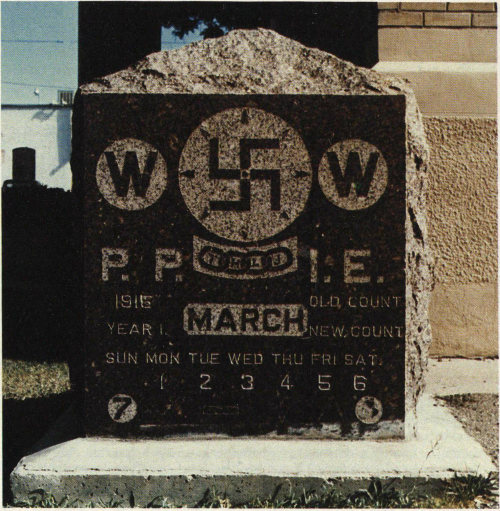
JOHN OTTO’S MONUMENT, at southwest corner of the Historical Museum and Institute of Western Colorado, at northeast corner of Fourth Street and Ute Avenue, Grand Junction. View looking north. Face is 4 feet square. (Fig. 2)
Otto’s rock is at the southwest corner of The Historical Museum and Institute of Western Colorado. The main attraction inside is a life-size skeleton of Allosaurus (fig. 23), whose bones are exact plastic replicas of real ones at the museum of Brigham Young University, at Provo, Utah. The painstaking casting of the “bones” and assembly of the self-supporting skeleton was done by Al T. Look, son of author Al Look listed under “References.” The museum also houses other items of interest from the Grand Junction area.
Construction of the scenic Rim Rock Drive through the Monument was begun by the National Park Service about 1931 using workers from the Civilian Conservation Corps, and the drive eventually was completed to join roads from Fruita and Grand Junction. The route from Fruita includes a winding 5 road up Fruita Canyon and through two tunnels to the mesa (figs. 3, 44, 45).
A modern Visitor Center, new housing facilities for park personnel, additions to the campgrounds, the Devils Kitchen Picnic Area near the East Entrance, several self-guiding nature trails, and additional overlooks and roadside exhibits were completed in 1964 as part of the Mission 66 program of the National Park Service.
The Monument originally included 13,749 acres, but boundary changes in 1933 and 1939 increased the total to 17,660 acres, and the inclusion of all of No Thoroughfare Canyon and other boundary adjustments in 1978 increased the size to about 20,457 acres, or about 32 square miles (see map, fig. 3).

John Otto, early explorers, and even the Ute Indians who once hunted in the area were by no means the first people to view the Monument, in fact they were “Johnnies-come-lately.” Considerable evidence indicates that prehistoric people inhabited the area thousands of years ago.
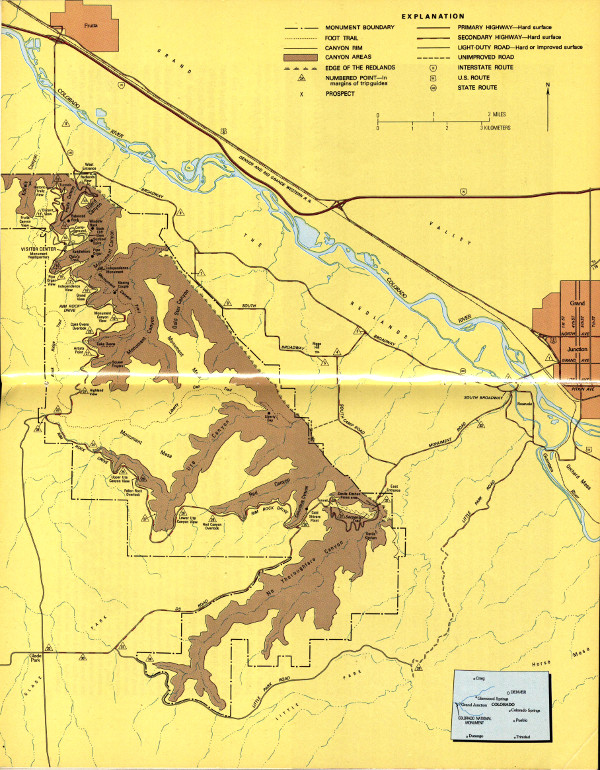
MAP OF COLORADO NATIONAL MONUMENT, showing location in
Colorado, boundaries, streams, highways and roads, principal trails, named
features, overlooks, and—in triangles—trip guides localities. The trip guides
numbers correspond to the numbers in the right margins of the section entitled
“Trips through and around the Monument.” Visitors are given pamphlets at the
two entrance stations and may purchase other reports and maps at the Visitor
Center. (Fig. 3)
High-resolution Map
Many years ago Al Look, of Grand Junction, discovered and excavated two caves in the part of No Thoroughfare Canyon formerly outside the Monument. He found stone projectile points, knives, awls, milling stones, parts of a sandal and coiled basket, reed matting, corn, corncobs, acorns, and animal bones, but no pottery—indicating that the people had not progressed beyond basket making. Similar artifacts were found in several other nearby places on the Uncompahgre Plateau. Archaeologists have named this old culture the Uncompahgre Complex, and date it back to a few thousand years before the time of Christ.[9] It should be pointed out that it is unlawful to remove artifacts, fossils, rocks, or minerals from a National Park or Monument.
In the summer of 1963 an archaeological survey of Colorado National Monument was carried out, under the terms of an agreement between the National Park Service and the University of Colorado, by Stroh and Ewing and their field assistants.[10] A total of 75 aboriginal sites were found of which 71 were within the Monument boundaries of that date, and 4 were closely adjacent. These comprised 41 open campsites, 24 rock shelters, 2 small caves, and 8 chipping stations. Artifacts recovered included 62 projectile points, 21 metates (grinding stones), 40 manos (hand stones), 111 whole or fragments of blades or scrapers, 6 choppers, several fragments of baskets, potsherds (bits of broken pottery) at two sites, 2 wood awls, several strands of yucca fibers, 3 corncobs, 6 kernels of corn, several bone fragments, storage cists at five sites, and petroglyphs at three locations.
Stroh and Ewing concluded that the majority of the sites appear to have been the campsites of a hunting and gathering people, and they speculated that there may have been aboriginal activity in the area from as long as several thousand years ago to relatively recent times.
The largest of the petroglyphs,[11] or rock drawings, are on a 9 fallen slab of Wingate Sandstone in No Thoroughfare Canyon, and are shown in figure 4. Archaeologist John Crouch (footnote 10), who kindly reexamined these petroglyphs in February 1980, told me that most of the figures appear to be Shoshonian (Ute), but that some may be of the Fremont culture[12] or even older.
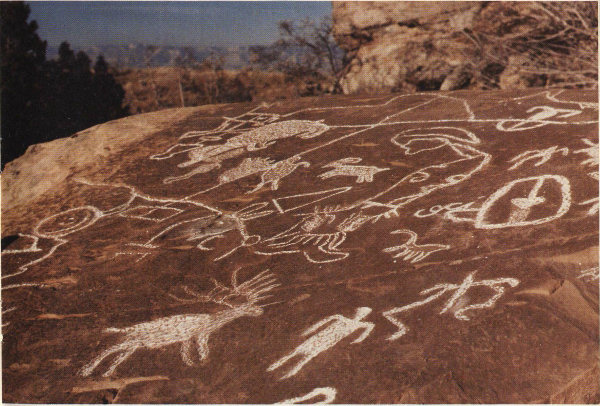
PETROGLYPHS, on fallen slab of Wingate Sandstone in No Thoroughfare Canyon. Figure of man at lower right is about 6 inches high. The fading designs were traced with chalk before photographing them. Photograph by T. R. Giles, U.S. Geological Survey. (Fig. 4)
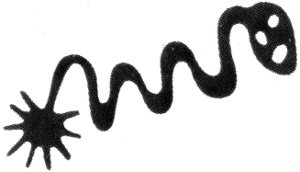
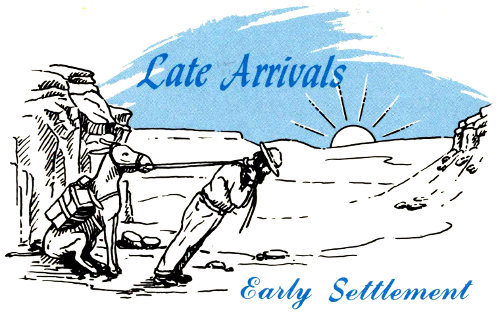
Prior to 1881 the Monument area was inhabited only by Ute Indians, but it was visited from time to time by a few fur trappers, explorers, and geologists. In 1776 an expedition led by Fathers Dominguez and Escalante passed northward across Grand Mesa, the high plateau just east of the area, which is pointed out in many of the photographs. A trading post was built by Joseph Roubidoux about 1838 just above the present site of Grand Junction. In 1853 Captain John W. Gunnison, seeking a new route for a transcontinental railroad, led an exploring party down what is now the Gunnison River Valley, past the confluence with the Grand River (now called the Colorado, p. 16), and on down the valley. Geologists and topographers of the Hayden Survey found only Ute Indians in the area in 1875 and 1876, and their field season of 1875 was abruptly cut short because of skirmishes with hostile Utes. After the Meeker (Colorado) Massacre of 1879, believed by many to have been caused mainly by the ignorance and shortsightedness of Meeker himself, treaties were signed forcing the Utes out of western Colorado onto reservations in eastern Utah, and the last of the Utes was reportedly out of the area by September 1881. The Grand Valley was immediately opened to settlement, and the first ranch was staked out on September 7, 1881. Nineteen days later George A. Crawford founded Grand Junction as a townsite and formed the Grand Junction Town Company the next month. The success of the new town was assured on November 21, 1882, when the narrow-gage line of 11 the Denver and Rio Grande Railroad (now Denver and Rio Grande Western Railroad) reached it via the Gunnison River valley. The town of Fruita was founded by William E. Pabor in 1883 and incorporated the following year.

Of the many early expeditions down the Colorado River, only one went past what is now Colorado National Monument—the ill-fated Brown-Stanton expedition. After the pioneering expeditions of 1869 and 1871 down the Green and Colorado Rivers by Major John Wesley Powell and his men, the many ensuing river expeditions started in Utah or Wyoming; but the first phase of the Brown-Stanton expedition started in Colorado—at Grand Junction. In 1889 Frank M. Brown organized a company for the construction of the proposed Denver, Colorado Canyon, and Pacific Railway, which was to carry coal from mines in Colorado over a “water-level” line through the mighty canyons of the Colorado River to the Gulf of California some 1,200 miles away, from which coal would be shipped to various ports in California. On March 26, 1889, president Brown, chief engineer F. C. Kendricks, and assistant engineer T. P. Rigney drove the first stake at Grand Junction for a survey of the new line. Then Brown left for the East to obtain financing, and the other two men plus some hired hands took off in a boat down the Grand River. After reaching the confluence, they towed the boat up the Green River to the town of Green River, Utah, thus becoming the first to make this trip upstream, albeit on foot and dragging their boats. Brown, who had returned from the East, his newly appointed chief engineer Robert Brewster Stanton, and 14 others in six ill-designed boats of cedar rather than oak, left 12 Green River, Utah, on May 25, 1889. Against the advice of Major Powell and others, they carried no life preservers. After many mishaps, Brown and two others were drowned near the head of Marble Canyon, and the ill-fated expedition temporarily ground to a halt. However, the indefatigable Stanton had new boats built of oak, and with a reorganized party of 12 left the mouth of the Dirty Devil River on November 25. After many additional mishaps the party finally reached the Gulf of California on April 26, 1890. In spite of Stanton’s heroic efforts, the railroad was never built, and the Grand Canyon was spared the huffing and puffing of locomotives.
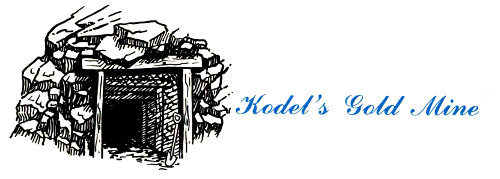
As shown in figures 3, 8, and 26, the first major canyon west of the West Entrance of the monument is called Kodels Canyon (pronounced \‘kōdǝls\). It was named after an early-day stonemason turned prospector, a hermit, who came to the Fruita area before 1900 and prospected for gold until at least 1930 in the canyon that now bears his name. He seemingly built a cabin or house near the mouth of the canyon, spent most of the rest of his life in a vain quest for gold in the canyon, barricaded his house against would-be intruders, and took potshots at anyone approaching his home for fear they were after his “gold.” Some thought him only half crazy, but when he took repeated shots at an Indian named Henry Kadig, he was adjudged wholly insane and sent to the mental hospital at Pueblo, Colorado, for several years. When he got out he sold the grazing rights in his canyon to the late Irving Beard of Fruita, and seemingly was not heard from again. According to various estimates, Kodel dug an adit between 18 and 150 feet into the dark Proterozoic rock in the side of the canyon (shown in fig. 3), then sunk a shaft somewhere between 30 and 50 feet deep. 13 He was always “on the verge of a big strike,” but there is no record of any actual production.
Later, a prospector from the midwest spent several summers digging in Devils Canyon, the next major canyon to the west, but he was equally unsuccessful. The unsuccessful attempts of Kodel and others is not surprising, for the two canyons are some 100 miles north of the Colorado mineral belt—a band extending roughly from Boulder to the western part of the San Juan Mountains, in which ore-bearing Upper Cretaceous or lower Tertiary rocks were intruded into all overlying rocks of whatever age.
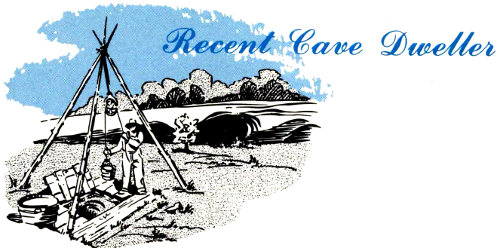
About 3 miles west of the Glade Park Store and Post Office are three large caves in a cliff of the Wingate Sandstone on the north wall of a canyon containing a tributary of Clark’s Wash. The middle cave, which formerly contained a small one-room framehouse and other improvements, was occupied for about 40 years prior to 1958 by Mrs. Laura Hazel Miller (fig. 5). A large cave just to the west (left) was used for storage, and another large cave just to the east formerly was fenced to shelter domestic animals. Mrs. Miller lived alone most of this time but had a dog for companionship the last few years she lived in the cave. When my wife and I visited her in the mid-fifties we had a very pleasant conversation with this very intelligent woman and could hardly believe she was 87 years old. She could not understand why anyone could live in crowded cities as she much preferred the peace and quiet of her cave. Once a week she walked the 6 miles round trip to and from the Glade Park Store and Post Office, bought what few necessities she needed, and telephoned her daughter in Grand Junction. Maybe she had something the rest of us have missed! She became sick in her nineties and moved to Grand Junction to live with her daughter. After she died, the property was sold, and I have since observed that vandals had burned her one room house and had destroyed most of the other improvements.
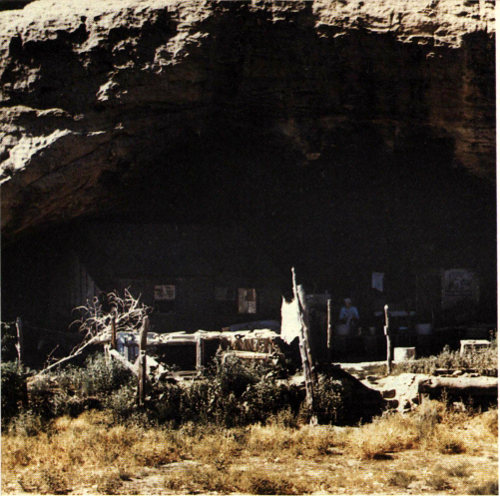
CAVE in Wingate Sandstone inhabited by Mrs. Laura Hazel Miller (visible between gate posts) until 1958. One-room house was entirely within cave, and smaller storehouses extended back of the house. Note blackening of cave roof by soot. (Fig. 5)
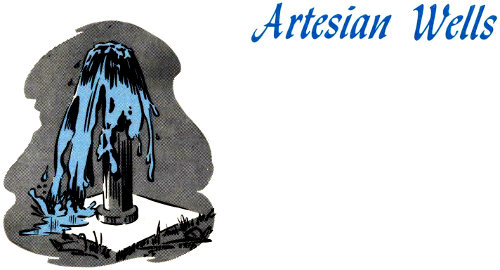
It may surprise you to learn that several sandstone formations supply water to artesian wells northeast of the Monument in The Redlands, Orchard Mesa, and the southwestern side of the Grand Valley, most of which are 500 to more than 1,000 feet deep. When first drilled and for some years later these wells flowed at the land surface, but eventually after too many wells had been drilled 15 too close together, each well reduced the output of neighboring wells until most wells ceased to flow naturally. This made it necessary for most well owners to install pumps, which further aggravated the problem by reducing the artesian head (the height to which the water rises above the formation from which it issues). This created a situation not unlike too many children sucking on straws in the same ice cream soda, and led to a detailed investigation by the U.S. Geological Survey and the Colorado Water Conservation Board,[16] outgrowths of which were the present report and its predecessors.
The water system of the Ute Conservancy District was virtually completed by late 1964 and began to supply water to rural residents of Grand Valley between the towns of Palisade and Mack through a vast network of pipelines. The water is obtained from surface sources on the north flank of Grand Mesa east of the valley and is brought to the valley via a pipeline down the valley of Plateau Creek. Use of the new water has reduced the draft on many of the artesian wells. The reduced draft has locally arrested the decline in the artesian head or has actually allowed some recovery in head.
In order of their importance and productivity the water-bearing sandstones are the Entrada, the Wingate, and local sandstone lenses in the lower part (Salt Wash Member) of the Morrison Formation (fig. 7). In a few places small flows or yields are obtained from wells that tap the Dakota Sandstone and underlying Burro Canyon Formation, but inasmuch as the Dakota contains some marine sandstones from which all the salt seemingly has not yet been flushed out, the water from most of these wells is brackish or salty.
As we will see on the trip “From Grand Junction through The Redlands to the West Entrance of the Monument,” pages 88-95, in and near the Monument these sandstones look bone dry, so how can they supply water to artesian wells? They are indeed dry in all the cliff exposures, but as will be noted later when the bending and breaking of the rocks are discussed (p. 64-71), erosion has exposed the upturned sandstones so that they may take in water from the many small streams that drain the Monument and adjacent areas for short periods after summer thundershowers or during spring thaws. The water moves slowly down the dipping sandstones and becomes trapped under pressure beneath overlying beds of siltstone or mudstone—materials that are nearly impervious.
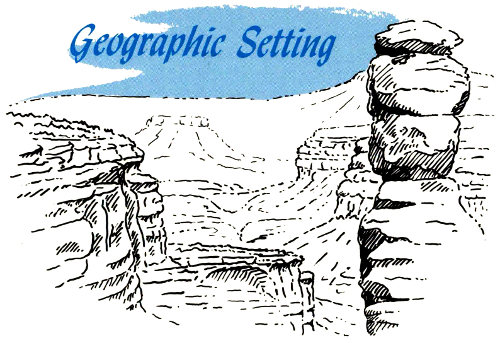
Geologists and geographers have divided the United States into many provinces, each of which has distinctive geologic and topographic characteristics that set it apart from the others. Colorado National Monument is in the northeastern part of the Canyon Lands section of the Colorado Plateau Province—a province that contains 15 national parks and monuments, about 3 times as many as any other province. This province, hereinafter referred to simply as the Colorado Plateau, or the Plateau, covers some 150,000 square miles and extends from Rifle, Colo., at the northeast to a little beyond Flagstaff, Ariz., at the southwest, and from Cedar City, Utah, at the west nearly to Albuquerque, N. Mex., at the southeast. This scenic province consists of high plateaus generally ranging in altitude from 4,500 feet to more than 7,000 feet, which are deeply and intricately dissected by literally thousands of canyons.
Colorado National Monument is drained entirely by the Colorado River, which flows to the northwest in the wide Grand Valley just a few miles from the northeastern border (fig. 3). The small streams that drain the Monument contain water only after summer thundershowers or after rapid snowmelt.
Why is the large valley of the Colorado River called the Grand Valley? The Colorado River northeast from its confluence with the Green River in the middle of Canyonlands National Park[17] formerly was called the Grand River, and the 17 Green and Grand joined at the confluence to form the Colorado River. The Grand River was renamed Colorado River by act of the Colorado State Legislature approved March 24, 1921, and approved by act of Congress July 25, 1921. But the old term still remains in names such as Grand County, Colo., the headwaters region; Grand Valley, a town 16 miles west of Rifle, Colo.; Grand Valley between Palisade and Mack, Colo.; Grand Mesa, an extensive plateau which towers more than a mile above the Grand and Gunnison River Valleys; Grand Junction, Colo., a city appropriately situated at the confluence of the Grand and Gunnison Rivers; and Grand County, Utah, which the river traverses after entering Utah.
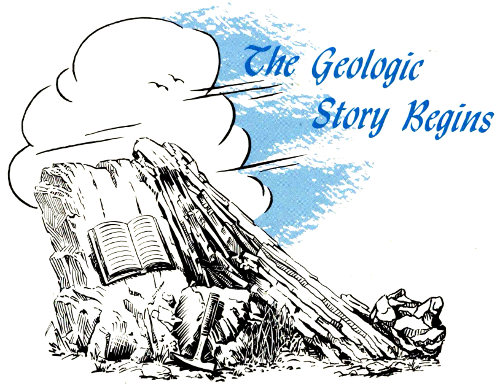
Colorado National Monument is a land of brightly colored cliff-walled canyons and towering monoliths—a majestic sample of mysterious canyonlands that stretch hundreds of miles to the west and south. Now a desert region more than a mile above the sea, it was not always so. More than a billion years ago the site of the Monument was deep beneath the sea. Later, lofty mountains were pushed up only to be obliterated eventually by the slow but relentless forces of erosion. Millions of years later the earth shook to the stride of 10-ton 18 dinosaurs—then the sea returned again and sharks swam over the region looking for food.
These are but a few samples of the interesting—even exciting—events in the long geologic history of the Monument. Many pages, indeed several whole chapters, of its history are missing and must be inferred from nearby regions where the story is more complete. Thus, the cliffs and canyons you are looking at did not get that way overnight. An understanding of the geologic processes and events that led to the scenic features of today should help you toward a clearer picture and greater appreciation of nature’s handiworks (fig. 6).
Geologists recognize rocks of three distinctly different modes of origin—sedimentary, igneous, and metamorphic, and there are many variations of each type. The sedimentary rocks of the Monument are composed of clay, silt, sand, and gravel carried and deposited by moving water; silt and fine sand transported by wind; and some limestone, composed mainly of the mineral calcium carbonate, which was precipitated from water solutions in freshwater lakes. In areas not far to the northeast and southwest are many sedimentary rocks of marine origin, that is, materials that were deposited in the ocean or shallow inland seas, but in the Monument marine sedimentary rocks occur only in parts of the Dakota Sandstone; however, the overlying marine Mancos Shale underlies the adjacent Grand Valley and forms the lower slopes of the Book Cliffs across the valley (fig. 25).
Igneous rocks were solidified from liquid molten rock intruded upward into any preexisting rocks along cracks, joints, and faults. Molten rock that reaches the land surface and forms volcanos or lava flows is called extrusive igneous rock. Joints are cracks or breaks in rocks along which no movement has taken place. Faults are cracks or joints along which one side has moved relative to the other. Different types of faults are shown in figure 28. Metamorphic rocks were formed from either of the other types by great heat and pressure at extreme depths in the Earth’s crust. Metamorphic rocks and some intrusive igneous rocks make up the hard, dark rock that floors all the deep canyons in and near the Monument. The nearest extrusive igneous rocks are the thick, dark lava flows that cap towering Grand Mesa to the east and Battlement Mesa to the northeast.
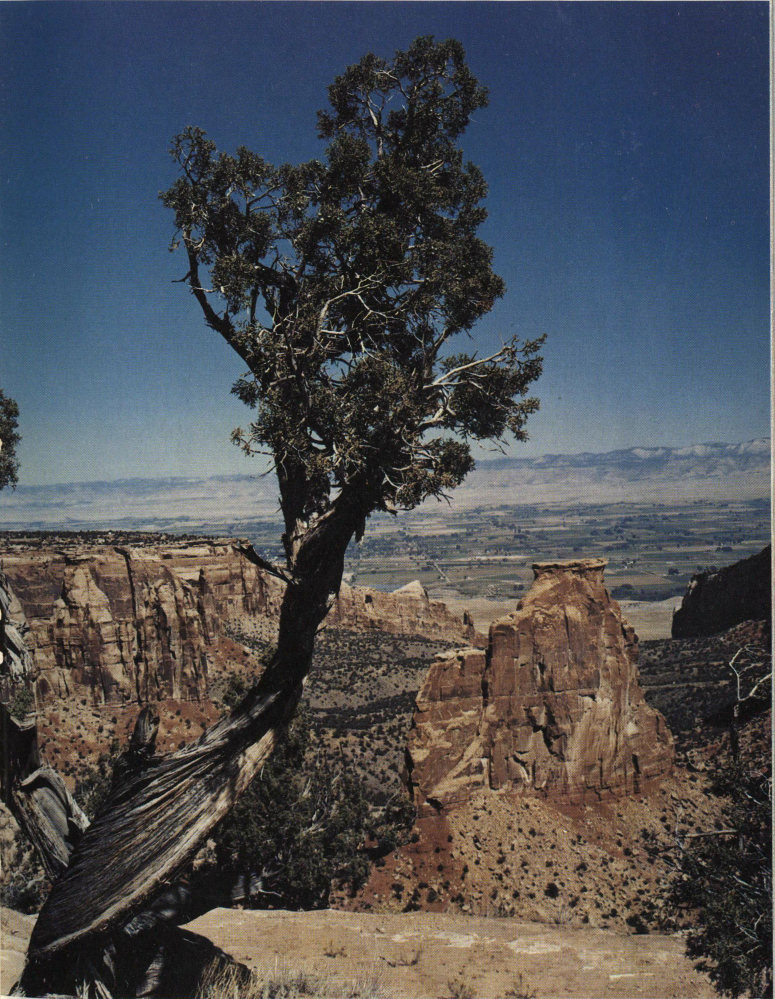
INDEPENDENCE MONUMENT, separating the two entrances of Monument Canyon. Looking north from Grand View; Colorado River, Grand Valley, and Book Cliffs in distance. Roan Cliffs are white cliffs at extreme distance on right skyline. Dark rock flooring canyon is Proterozoic metamorphic rock, red material in slope at base of cliffs is the Chinle Formation, vertical cliffs are Wingate Sandstone, thin protective caprock on top of cliffs is lower sandstone of the resistant Kayenta Formation. The top of Independence Monument is nearly 450 feet above the floor of the canyon. (Fig. 6)
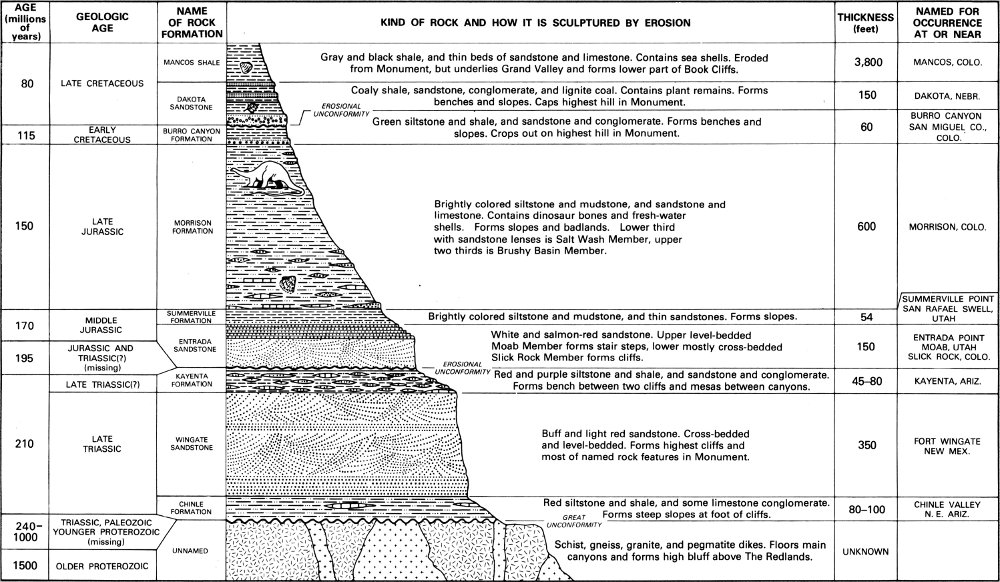
ROCK COLUMN OF COLORADO NATIONAL MONUMENT. 1 foot = 0.305 meter. (Fig. 7)
After the materials of the sedimentary rocks were deposited and covered by younger layers, they generally became saturated or partly saturated with ground water containing small amounts of dissolved minerals. Some of these minerals precipitated from solution and cemented the loose particles into rocks of varying hardness. Thus, most of the sandstones are partly cemented with the mineral calcite, composed of calcium carbonate (CaCO₃), but some are cemented also with silica (SiO₂) or hematite (Fe₂O₃).
Look almost anywhere in the Monument and you will see that the rocks are piled up in layers of different color, thickness, and hardness—much like a vast layer cake. In most of the Monument, these layers are flat or slope gently down to the northeast, but along the northeastern boundary they are sharply bent or broken as though the cake had been carelessly placed over the edge of a table and had sagged.
Let us consider these layers one by one, beginning with the oldest at the bottom, for each is a partial record of events long past. Layers of rock that can be easily recognized and distinguished from other layers are called formations and are named after a place where they are well exposed. For the name to be accepted for general usage it must be the first published description in a technical report of a particular sequence of rock layers. The places after which the formations of the Monument were named are given in the rock column (fig. 7), and the outcrops of the formations are shown on the geologic map (fig. 8). In the pages that follow, the geologic events that shaped the Monument we see today are discussed in chronological order, beginning with the oldest rocks that floor the deep canyons.
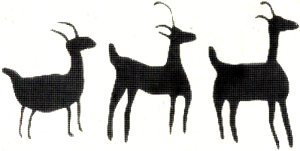

GEOLOGIC MAP of Colorado National Monument and vicinity,
simplified and greatly reduced from part of maps at scale 1:31,680 by Lohman
(1963, 1965a). For additional surficial deposits in the Grand Valley and Orchard
Mesa see Cashion (1973). (Fig. 8)
High-resolution Map
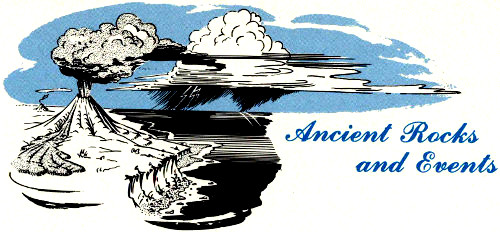
The dark rocks that floor all the large canyons of the Monument (fig. 6) and form the high bluffs along the northeastern boundary (figs. 37, 38, 40, 41) are of early Proterozoic[18] age—among the oldest known rocks of the Earth. Most were once sand and mud that spread out on the bottom of the sea and later hardened into sedimentary rocks (fig. 9-1). After thousands of feet of such rocks had accumulated, they were squeezed, bent, and lifted up by slow but mighty movements of the Earth’s crust to form high mountains perhaps like the Rockies. Heat and pressure that developed at great depth in the roots of these mountains changed the sediments into metamorphic rocks known as schist (finely banded) and gneiss (coarsely banded) (fig. 9-2). The rocks are about 1½ billion years old (fig. 7).
Later in Proterozoic time, about a billion years ago, molten material from below was forced upward along cracks or faults and cooled slowly to form thin seams or dikes and irregular bodies of granite (fig. 9-3). Dikes are called pegmatite when they contain large crystals of pink feldspar, white or clear quartz, black tourmaline, and large flakes of white mica. Small pegmatite dikes that pass through the older schist and gneiss may be seen along roadcuts in Fruita and No Thoroughfare Canyons.
BLOCK DIAGRAMS OF EARLY PROTEROZOIC EVENTS (after Edwin D. McKee). (Fig. 9)
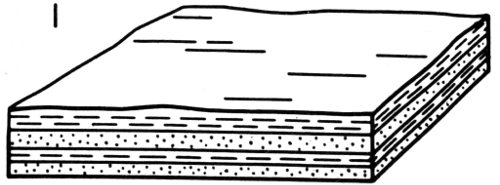
① Layers of sand, mud, and other sediment accumulated in the sea and later were hardened into sedimentary rocks.
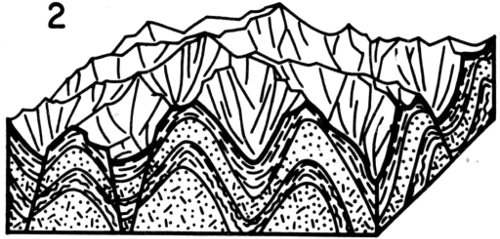
② The strata were compressed, bent, and uplifted into high mountains. Heat and pressure at great depth changed the sediments into banded schist and gneiss.
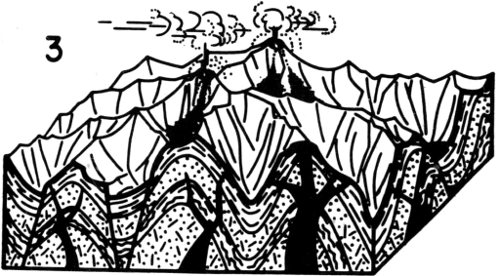
③ Molten rock flowed upward along cracks or faults. Upon cooling it formed lava at the surface and granite or pegmatite beneath.
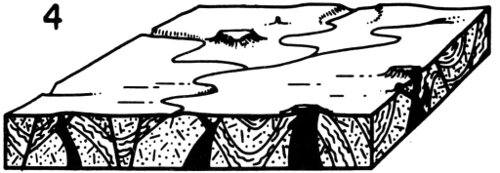
④ During eons of time the forces of erosion wore down the mountains to a nearly level plain.

If you look down into any of the large canyons in the Monument, you will notice a brick-red formation, the Chinle, which forms steep slopes at the foot of the high cliffs and lies upon the dark Proterozoic rocks along nearly straight lines of contact. Such a straight-line contact is particularly well shown about midway up the high bluffs along the northeastern boundary of the Monument (fig. 37). If the red layer and all overlying rocks were stripped away, these straight lines would be the exposed edges of a remarkably smooth, nearly flat erosion surface on the top of the dark Proterozoic rocks, as shown in the last diagram of figure 9. A vast amount of time passed between the carving of this surface and the deposition of the red Chinle, and no record of the events during this time is preserved in the Monument.
During the latter part of the Proterozoic Eon and parts of the long Paleozoic Era that followed, the dark rocks were submerged beneath the sea several times and received sediments now found in areas to the northeast and southwest. Beginning in the Pennsylvanian Period some 330 million years ago (fig. 61), a large upfold of the rocks, or anticline (fig. 27), known to geologists as the Uncompahgre Highland, rose high above sea level, probably reaching its highest level in Late Pennsylvanian or Permian time. This old highland formed an imposing chain of mountains in about the position of the present Uncompahgre Plateau.
After the old rocks were pushed up into these high mountains what became of them? From the moment the mountains began to rise, their rocks were buffeted by wind, pounded by rain, pried open by frost, scoured by debris-laden streams and, perhaps by glaciers, and the loosened rock particles were dissolved or carried to the sea. Most rocks are brittle enough to crack when bent by Earth forces. Such cracks, called joints, are easy targets for erosion. The freezing of water in joints tends to pry the rocks apart. The breakup of the rocks was hastened by the chemical attack on rock minerals by water charged with oxygen and carbon dioxide. When land plants became established in later geologic eras, soil acids formed 27 from decaying vegetation also assisted materially in breaking up the rocks.
These same erosion processes are going on today, but their effects are scarcely noticeable from year to year except in soft earth after storms or floods. During eons of time, however, the mountains were again worn down to a nearly level plain. Missing between the red Chinle and the dark rocks are many thousands of feet of rocks, some of which once covered this surface and still occur in other regions less affected by erosion. This gap in the rock record, which represents more than a billion years, is known to geologists as a great unconformity. Missing are part of the lower Proterozoic rocks, all the upper Proterozoic rocks, all those of the Paleozoic Era, and part of those of the Triassic Period of the Mesozoic Era. (See figs. 7 and 61.)
Traces of primitive life have been found in some Proterozoic rocks in the form of lime-secreting algae and casts of worms, but no fossils of more advanced types have been found because at that time the primitive animals seemingly had not yet developed shells or skeletons. The ensuing Paleozoic Era saw the appearance and great development of shellfish, fish, amphibians, reptiles, and primitive plants. Some of the rock layers of ages missing at the Monument may be seen as near as Glenwood Springs to the northeast and Gateway to the southwest.
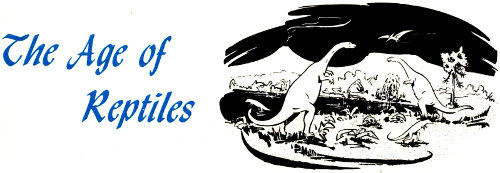
All the layers of sedimentary rocks preserved in the Monument above the dark Proterozoic ones were deposited by wind and water during the Mesozoic Era. This long era has been called the age of reptiles, for reptiles, including dinosaurs (meaning terrible lizards), were then the dominant land animals. The Mesozoic Era has been divided into three parts—the Triassic, Jurassic, and Cretaceous Periods. Rocks of each of these periods crop out in the Monument.

By late Triassic time the Monument was part of a nearly flat plain cut on the dark Proterozoic rocks, but there were hills or low mountains to the northeast. Streams from these hills dropped mud, silt, sand, and some gravel on this plain and into many small lakes that occupied the gentle depressions. Later, these deposits hardened mainly into red siltstone and sandstone, but thin beds of gravel were cemented to form conglomerate, and thin beds of limestone formed in some of the shallow lakes by the precipitation of the mineral calcium carbonate. These rocks, which comprise the Chinle (pronounced Chin-lee) Formation, are only 80 to 100 feet thick in the Monument but are as much as 700 feet thick near Moab, Utah, southwest of the Uncompahgre Plateau, where the entire formation is present. There, the Chinle rests on still older Triassic and Paleozoic rocks—all absent in the Monument for the reasons noted previously. In some parts of the Plateau, sandstone or conglomerate beds in the lower part of the Chinle yield uranium ore, but these beds were not deposited in or near the Monument.
The red color of the Chinle and some of the overlying rocks is caused by minute amounts of iron oxide—the same pigment used in rouge and red barn paint. Various oxides of iron, some including water, produce not only brick red but also pink, salmon, brown, buff, yellow, and even green or bluish green. This does not imply that the rocks could be considered as sources of iron ore, for the merest trace of iron, generally only 1 to 3 percent, is enough to produce even the darkest shades of red.
Because it is soft, the Chinle is easily eroded into steep slopes at the foot of high sandstone cliffs in all canyons of the Monument and on top of the high bluffs that face The Redlands. It also forms the broad base of Independence Monument. Rim Rock Drive crosses the Chinle three times in the lower part of Fruita Canyon and twice in No Thoroughfare Canyon.
Fossil reptile bones, petrified wood, and freshwater shells come from the Chinle in parts of Arizona and Utah. Reptiles probably roamed the Monument in Chinle time, but their remains have not been located.

Still later in the Triassic Period the Monument became part of a vast desert. Winds blowing from the northwest brought great quantities of fine sand and piled them up into large dunes like those in the Sahara or in Great Sand Dunes National Monument in Colorado. But like all deserts, it was not always dry—occasional rainstorms produced many small lakes and ponds. Some of the sand was washed into these lakes or ponds and settled in level layers. This huge sandpile eventually hardened into the buff and light-red sandstone that we now know as the Wingate. The shapes of the old dunes are indicated by the steep dips of sand layers, called crossbeds, which stand out in sharp contrast to the nearly level layers formed in the lakes and ponds (fig. 10).
The spectacular scenery of Colorado National Monument owes its existence largely to the 350-foot cliffs of the Wingate Sandstone (fig. 6) and to the desert climate, which allows us to see virtually every foot of the vividly colored rocks and has made possible the creation and preservation of such a wide variety of fantastic sculptures. A wetter climate would have produced a far different and smoother landscape in which most of the rocks and land forms would have been hidden by vegetation.
Eroded remnants of the Wingate form most of the named rock features of the Monument and are shown in many of the photographs. Independence Monument—a towering slab of sandstone that resembles a bridge pier (fig. 6)—is all that is left of a high narrow wall that once connected the point east of Independence View with the high mesa north of the slab and which once separated the two entrances of Monument Canyon. In a few thousand years this remnant, too, may be gone.
Vertical cliffs and shafts of the Wingate Sandstone endure only where the top of the formation is capped by beds of the next younger rock unit—the Kayenta Formation. The Kayenta is much more resistant to erosion than the Wingate, so even a few feet of the Kayenta, such as the cap on top of Independence Monument, protect the rock beneath. Once this cap has been eroded away, the underlying Wingate weathers into rounded domes, such as the Coke Ovens.
Cold Shivers Point (fig. 53)—a toadstool shaped cap of sandstone 30 of the Kayenta above a vertical cliff of the Wingate—is perhaps the most aptly titled feature of the Monument.

PETRIFIED SAND DUNES in Wingate Sandstone along old Serpents Trail. Looking north across The Redlands and Grand Valley to the Book Cliffs. Battlement Mesa on right skyline. (Fig. 10)
The Coke Ovens (fig. 11) and Squaw Fingers were formed partly because most of the caprock of Kayenta has been weathered away and also because the brittle rocks were cracked along an evenly spaced set of vertical joints. These joints trend northward between the two named features. More rapid weathering along these joints helped form the separate rounded domes or spires between them. Similarly, northwestward-trending vertical joints connect and helped shape Kissing Couple, Pipe Organ, and Sentinal Spire.

THE COKE OVENS, looking north from overlook beneath Artists Point. A set of north-south joints has allowed erosion of the Wingate Sandstone to proceed more rapidly along these zones of weakness and has helped create the four ovens shown. Weathering away of the protective caprock of the overlying Kayenta Formation has produced rounded tops on all but the left-hand shaft, which is still protected by the Kayenta. Note alcoves and arches in cliff of the Wingate beyond, the formation of the one on the right having been aided by removal of the underlying soft Chinle Formation. Bench covered by piñon and juniper above Wingate is resistant thin-bedded Kayenta Formation. Cliff above the bench is the Slick Rock Member of the Entrada Sandstone. The Coke Ovens were named from their resemblance to the beehive-shaped brick ovens formerly used to convert bituminous coal into coke for smelting iron. (Fig. 11)
Many of the cliff walls of the Wingate are vertical, some even overhang, yet in some places the slopes are gentle enough to hold talus and to be climbed (fig. 12). Why is this? The answer to this question is given in a later section on “Canyon Cutting.”
Arches or shallow caves weathered out of some cliff faces of the Wingate, particularly where the underlying Chinle Formation has been partly scoured away. Although there are no large caves within the Monument, there are three in a row along the road 3 miles west of the Glade Park Post Office. One of these was inhabited until 1958 (fig. 5).
Many of the cliff faces of the Wingate are darkened or blackened by desert varnish—a natural pigment of iron and manganese oxides, silica, and clay.[19]
Dinosaurs left their footprints in the sands of the Wingate in parts of the Colorado Plateau, but no tracks or fossils have yet been found in this formation in or near the Monument.
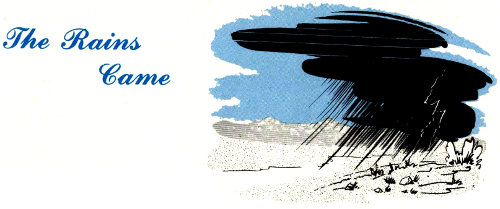
The arid climate of Wingate time was followed by a wet period, when streams from the northeast gradually covered the sand dunes with mud, sand, and some gravel. The sand and gravel of the stream channels were cemented into hard sandstone and conglomerate, and the mud of the flood plains hardened into red and purple siltstone and mudstone. The resulting Kayenta Formation makes up the bench between the two cliffs upon which the Visitor Center, campgrounds, and most of scenic Rim Rock Drive were built. Here, nature was kind, for this gently sloping bench was an ideal place to build the road from which to look down into the deep chasms. The Kayenta also caps the broad mesas between the canyons. It is about 350 feet thick in eastern Utah, only 45 to 80 feet thick in the Monument, and it is absent altogether not far east of the Monument. The reasons for the eastward thinning and ultimate disappearance of the Kayenta and some younger rocks are given in the next section.

RED CANYON, looking northeast toward Grand Junction from Red Canyon Overlook. Dark notch at the bottom of the northeast end of the canyon is known as the Gunsight. Linear feature in the Grand Valley beyond is the Denver and Rio Grande Western Railroad. Prominent point near middle of Book Cliffs is Mount Garfield (Fig. 25). Battlement and Grand Mesas form left and right skylines, respectively. Dark green bush in right foreground is Mormon Tea. (Fig. 12)
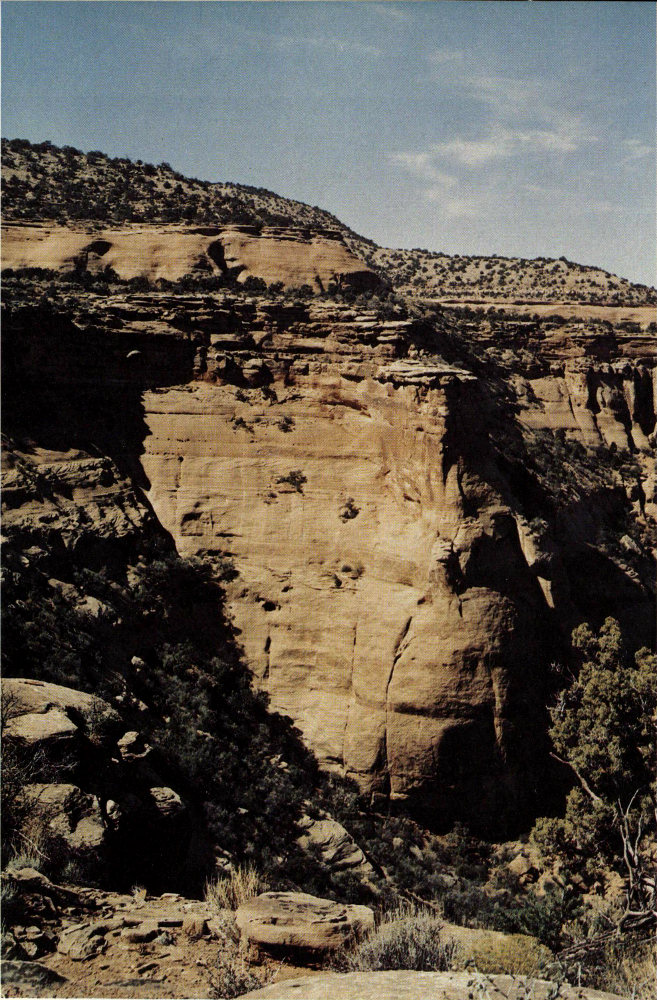
THIN BEDDED KAYENTA FORMATION protecting underlying cliff of softer Wingate Sandstone. Rim Rock Drive is on bench of the Kayenta close to thinner cliff of Entrada Sandstone in background. Looking northwest from a point northeast of Monument Canyon View. (Fig. 13)
As noted earlier, the sandstone beds and lenses of the Kayenta generally are coarser grained (some even contain small pebbles) and much harder than the underlying Wingate Sandstone—particularly the lower beds of the Kayenta, which serve as a protective capping, as shown in figure 13 and in many of the other photographs. Unlike the dominantly fine grained, well sorted, windblown sands of the Wingate, the coarser stream-laid sands of the Kayenta are angular and poorly sorted, so that small grains fill spaces between larger ones. Moreover, in addition to the calcite cement (which also holds together the sand grains in the Wingate and Entrada Sandstones), most of the sand grains and pebbles in the Kayenta are covered by interconnected “overgrowths” of silica (SiO₂), which make up about 10 percent of the rocks and serve as a nearly insoluble hard cement.[20]
The combination of the coarse and fine grains and interlocking silica “overgrowths” makes the Kayenta one of the most resistant rocks in the Colorado Plateau.
In distant views of weathered outcrops the Kayenta appears to consist mainly of thin beds or lenses of sandstone, which indeed it does, but in some fresh exposures, such as roadcuts, the highly lenticular red flood-plain deposits form striking features which may wedge out from 3 or 4 feet thick to a featheredge within horizontal distances of only a few feet (fig. 14).
The Kayenta has yielded fossil bones of dinosaurs and other reptiles in northeastern Arizona and freshwater shells in eastern Utah. As yet, however, no fossils have been reported from it in or near the Monument.

Following the wet interval when the Kayenta Formation was deposited over wide areas of the Colorado Plateau by streams, the Plateau once again became a vast desert, and this time the dry climate persisted from the Late Triassic into the Jurassic. The howling winds piled up enormous sand dunes, layer upon layer, to a total thickness of more than 2,200 feet at Zion National Park, and as much as 500 feet remains in eastern Utah and parts of southwestern Colorado. This immense sandpile eventually was cemented by calcite into the Navajo Sandstone.
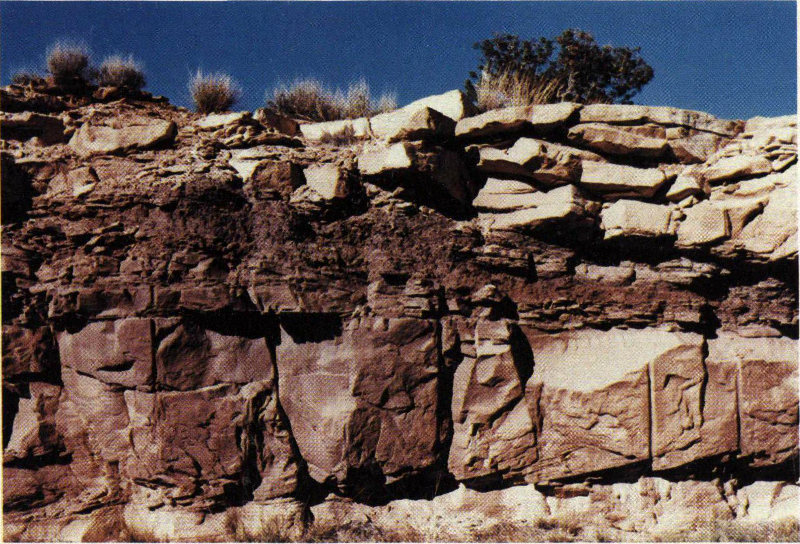
KAYENTA FORMATION, showing lenses of hard channel sandstones and wedge of red siltstone and mudstone. Along road cut of Rim Rock Drive near head of main stem of Ute Canyon. Vertical grooves remain from drill holes used in blasting roadcut. (Fig. 14)
Beautifully sculptured remains of the Navajo are featured attractions at Zion, Capitol Reef, and Arches National Parks, Rainbow Bridge, Navajo, and Dinosaur National Monuments; border many miles of beautiful Lake Powell; and form the eastern flank of the San Rafael Swell. For reasons to be explained, this sandstone thins to the northeast, and is absent entirely at about the Utah-Colorado State line, some 35 miles southwest of the Monument. Thus, in the Monument, the Navajo, most of the Kayenta, and the lower part of the Entrada Sandstone are missing at another gap in the rock record, as shown in figure 15.
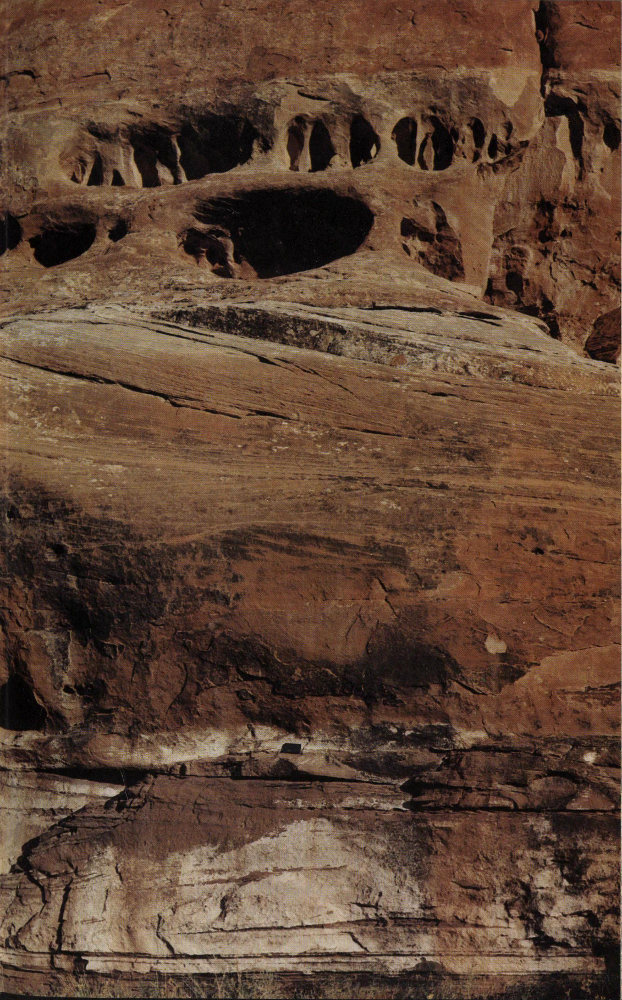
GAP IN THE ROCK RECORD, between Kayenta Formation below 3½- × 6-inch green notebook and Slick Rock Member of Entrada Sandstone above. The reasons for this gap are given in the text on page 38. That this is an erosional unconformity is clearly indicated by the uneven top of the Kayenta, particularly to the left of the notebook. Note solution pits and openings in the Entrada near top of photograph. (Fig. 15)
How is it possible that the Navajo Sandstone is more than 2,200 feet thick in Zion National Park, is several hundred feet thick in much of the Plateau in Utah and parts of southwestern Colorado, yet is absent entirely, together with a considerable thickness of younger rocks in and near Colorado National Monument? How much of the missing strata once were present in the Monument is not known, but it seems clear that at least part was present but was eroded away before the Entrada Sandstone was deposited. There is evidence[21] that following the deposition and consolidation of the Navajo Sandstone the Plateau and adjacent areas were uplifted, tilted gently westward, and eroded for a considerable period of time. Erosion naturally was most pronounced in the eastern areas, including the Monument, where the uplift was greatest. Thus, in the northeastern part of the Plateau all the Navajo and most of the Kayenta were eroded away, and erosion continued there while the lowest member of the Entrada, the Dewey Bridge Member, and the lower part of the overlying Slick Rock Member were being laid down in the Moab, Utah, area.[22] This old erosion surface is clearly visible in many places along the cliff wall on the southwest side of Rim Rock Drive between the Visitor Center and Kissing Couple.
The reduction in thickness of the Navajo Sandstone from southwest to northeast and absence of the Navajo and some younger rocks in and near the Monument are shown on an isometric (three dimensional) block diagram prepared by artist John R. Stacy and me, which is displayed in the Museum of the Visitor Center. This block diagram portrays the surface and subsurface rocks from Zion National Park, Utah, to Black Canyon of the Gunnison National Monument, Colo., via Capitol Reef National Park, the Henry Mountains, and Colorado National Monument. Throughout the Plateau and parts of adjacent areas, the erosion surface on top of the Navajo Sandstone is covered by scattered pebbles of chert—a hard variety of silica (SiO₂) derived from cherty beds of freshwater limestone in the Navajo.[23] Where the Navajo has been completely eroded away and the ancient erosion surface is on the Kayenta Formation, as in Colorado National Monument, scattered pebbles (some of which are chert) derived from the conglomerate lenses in the Kayenta are found locally on the old surface.[24]
Because of this gap in the rock record we will continue part of our story farther west, where the rock record is more nearly complete.

In Middle Jurassic time the land now called central Utah, which then was the eroded surface of the Navajo Sandstone, sank beneath an arm of a shallow sea that came in from the north, and most of the area remained beneath this sea until Late Jurassic time. Sediment carried into this sea and into bordering lagoons and estuaries later hardened into the sedimentary rocks of the Carmel Formation, Entrada Sandstone, and Curtis and Summerville Formations. The Carmel and Curtis contain abundant marine fossils of Middle Jurassic age, and in central Utah the intervening unfossiliferous Entrada also is believed to have been deposited in or near the sea, and the unfossiliferous Summerville Formation probably was deposited upon a tidal flat that was submerged part of the time.
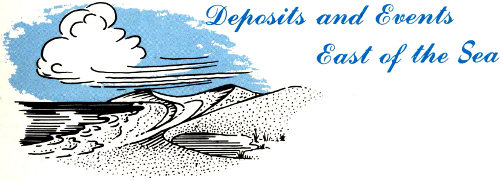
In eastern Utah, east of the ancient Jurassic sea, the Entrada Sandstone is entirely unfossiliferous, was partly water laid and partly wind blown, and has been divided into three distinctive parts, which in ascending order are the Dewey Bridge, Slick Rock, and Moab Members.[25] In and near the Colorado National Monument, the long period of erosion discussed in a preceding section probably continued well into the Jurassic, so only the upper part of the Slick Rock Member and the overlying Moab Member were deposited on the eroded surface of what little remained of the Kayenta Formation (fig. 14).
The Slick Rock Member was named from its occurrence at and near the mining town of Slick Rock, Colo., which originally was named after the appearance of the rock because it generally forms slick, smooth cliffs. It reminds one of the chicken and egg conundrum. The Slick Rock is composed mainly of sand dunes that were piled up on the eastern shore of the Jurassic sea by winds blowing from the northeast. Occasional rainy spells created lakes and ponds in which some of the sand was laid down in level beds. This pile of sand later hardened into the cliff-forming Slick Rock Member, which looks something like the Wingate but is generally only half as thick, weathers into less abrupt cliffs, is mostly salmon red, and is almost free of joints. The joints in the Wingate (fig. 11) probably resulted from the uplift and tilting of the Plateau before the long period of pre-Entrada erosion; whereas the land seems to have been more stable during Entrada time. The Slick Rock is cemented with calcium carbonate (CaCO₃), which is soluble even in weak acid, such as rain or snow water containing dissolved carbon dioxide. For this reason solution openings or pits occur in some of the cliff faces, the most striking of which are those shown near the top of figure 15.
The Slick Rock Member of the Entrada Sandstone forms a line of cliffs and isolated monoliths that are second in height and grandeur only to those of the Wingate. The Member is best displayed southwest of Rim Rock Drive between the Visitor Center and the Coke Ovens and along the western arm of Ute Canyon (fig. 16). It also forms the Saddlehorn just south of the camp and picnic grounds near the Visitor Center (fig. 50). Most of the smooth cliff faces show both the steeply dipping crossbeds of the old sand dunes and the flat-lying beds of the lake or pond deposits.

ENTRADA SANDSTONE, just above normally dry waterfall in west arm of Ute Canyon. Note smooth unjointed cliff of Slick Rock Member protected at left by overhanging basal bed of Moab Member, which forms about lower half of slope in distance. Upper part of distant slope is the Summerville Formation overlain by Salt Wash Member of the Morrison Formation. Note Slick Rock at left resting upon eroded crossbedded sandstone in Kayenta Formation, in which the canyon was cut. (Fig. 16)
The overlying Moab Member of the Entrada is a white level-bedded sandstone that generally weathers into stairsteps or ledges. One of the best exposures of the Moab Member is shown in figure 17, but good exposures also are seen along the west side of Rim Rock Drive just northeast of the Coke Ovens Overlook. In some places the Moab Member forms cliffs continuous with those of the underlying Slick Rock Member. It appears to consist of hardened beach or lagoon sand that was deposited along the eastern shore of the sea, which suggests that the sea extended farther east during Moab and Summerville times than it did during Dewey Bridge and Slick Rock times. Like the Slick Rock, the Moab also is cemented by calcium carbonate, but the lower sandstone ledges of the Moab Member are more resistant to erosion than the Slick Rock Member, so the Moab helps preserve the underlying cliffs. The top of the Moab Member forms patches of bare pavement east of the Monument, known as the “Slick Rim,” which may be observed from the Little Park Road.
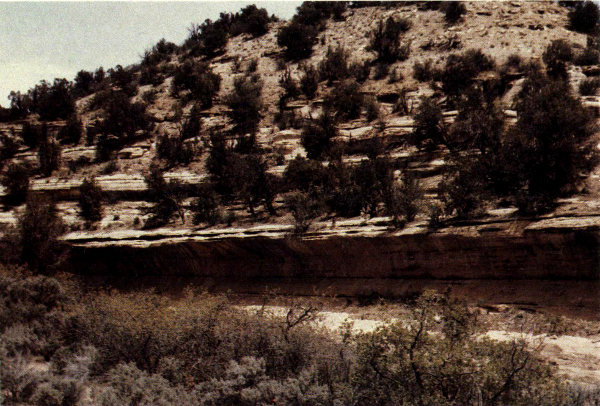
MOAB MEMBER OF ENTRADA SANDSTONE, showing typical steplike weathering. In west arm of Ute Canyon about a quarter mile above the view shown in figure 16. Moab Member caps and protects overhang of Slick Rock Member. Moab is overlain by unexposed slope of Summerville Formation and lower part of Morrison Formation. (Fig. 17)
Although the Slick Rock Member normally is salmon colored or pink, the upper half of an outcrop just north of the highest point on Rim Rock Drive at the head of main Ute Canyon has a distinctly mottled appearance, wherein much of the color has 43 been leached to white, but irregular splotches of color appear in the dominantly white upper part, and white splotches appear in the colored part, as shown in figure 18. By way of contrast, in an outcrop of the two members of the Entrada about 2 miles north of the Glade Park Store and Post Office (fig. 19), the entire Slick Rock Member is as white as the Moab Member, and the former is white for some distance to the east. Why is the salmon color entirely missing from the Slick Rock near Glade Park, partly missing in figure 18, but present virtually everywhere else in and near the Monument? The answers to this seeming mystery involve events that occurred long ago, so only the high points will be touched upon here.
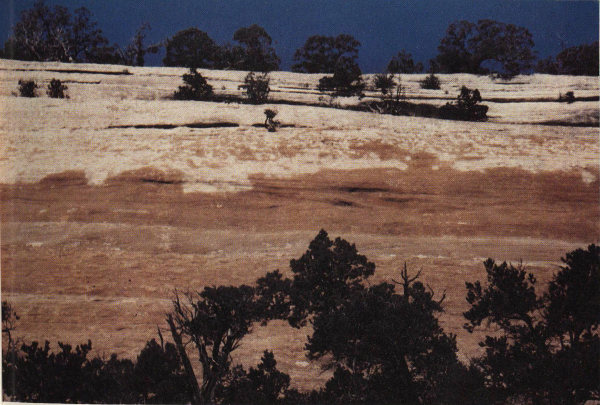
MOTTLED SALMON-AND-WHITE SLICK ROCK MEMBER, overlain by white level-bedded Moab Member, on west side of Rim Rock Drive about four-tenths of a mile north of head of main Ute Canyon. (Fig. 18)
It seems reasonable to suppose that the Slick Rock Member at both localities originally was salmon colored or pink, as it is everywhere else, but that later, the coloring agent, red ferric iron oxide (Fe₂O₃), was chemically reduced, or leached to ferrous iron oxide (FeO), by acidic ground water, and was carried away to the northeast by the slowly moving ground water. But as I have already pointed out, the cliff exposures of the sandstones are now bone dry, so what happened to the ground water and why was it acidic here and not elsewhere?
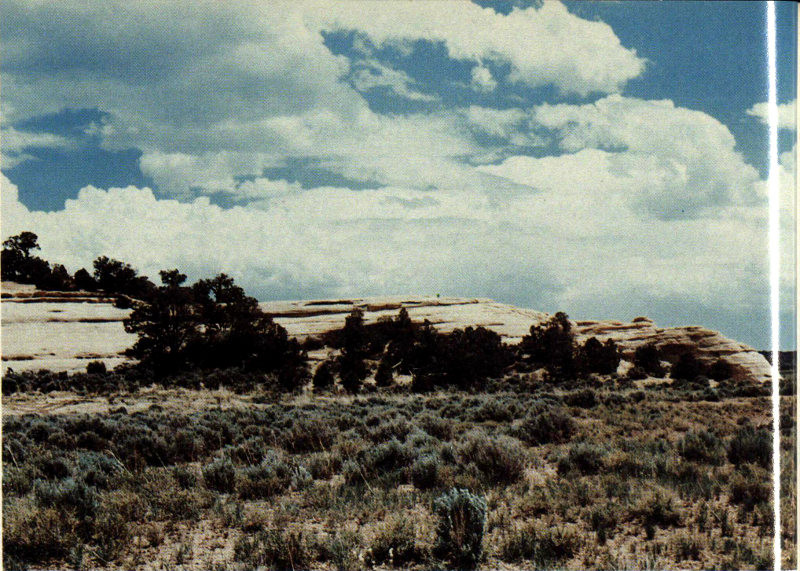
WHITE ENTRADA SANDSTONE, in outcrop just east of gravel road about 2 miles north of Glade Park Store and Post Office. Reasons for absence of salmon color in Slick Rock Member are given in text. (Fig. 19)
Before the cutting of the deep canyons of the Monument, which followed the last major uplifts of the region accompanied by bending and breaking of the rocks, the now dry sandstones were saturated with ground water that moved very slowly northeastward. Somewhere to the southwest the Entrada Sandstone seemingly took in water containing dissolved hydrogen sulfide gas (H₂S), changing the ground water to a weak acid. The H₂S could have been produced by a type of anaerobic bacteria that has the ability to reduce dissolved sulfates (SO₄⁻²) in water to the dissolved hydrogen sulfide gas, thereby obtaining needed oxygen.
The next questions you might logically ask are (1) if the above deductions have any merit, how do we know the acid water was caused by dissolved hydrogen sulfide,[26] (2) what is the source of the sulfate ions (SO₄⁻²) from which the H₂S was obtained, and (3) why is the color of the Slick Rock Member in figure 19 completely reduced to white whereas that in figure 18 is only partly reduced in the upper part?
Although the ground waters from artesian wells in the Grand Junction area contain small amounts of sulfate as do most ground waters, the amount needed for the results observed more likely came from solution of the common mineral gypsum (calcium sulfate containing some water, CaSO₄·2H₂O). The overlying Summerville and Morrison Formations contain some gypsum in many places in Utah, so it is not improbable that these formations contain gypsum locally in Colorado. If so, sulfate-bearing water could have percolated downward into the Entrada at some point southwest of Glade Park. But as this must have happened several million years ago, the clues as to just where this occurred have grown quite cold.
Seemingly, the color in the Slick Rock Member near and east of Glade Park was entirely removed by the process described, but the very slow moving ground water had time to leach only the upper part of the Slick Rock (the most permeable part) in Ute Canyon before the process was halted forever by the draining of water from these beds by canyon cutting.
Shortly before the Jurassic sea to the west dried up, silt, mud, and some sand were carried into either a shallow arm of the sea or a broad bay or lagoon near it, and later the silt, mud, and sand hardened to become the Summerville Formation. The Summerville is only 40 to 60 feet thick in the Monument but is much thicker in Utah.
The Summerville Formation is so soft that it weathers very rapidly and hence is exposed at only a few places. It is best displayed in the high roadcut at Artists Point and along the road to the south for the next mile (fig. 20), but it is also exposed in roadcuts along the west arm of Ute Canyon. Even the thinnest beds of the Summerville can be traced for hundreds of yards, and individual beds have a nearly constant thickness for such distances. This greatly facilitated the detailed measurement of a section of the Summerville[27] by my son Bill and me from Artists Point to the base of the overlying Morrison Formation about a mile south. Using a 6-foot folding steel rule we measured and described each thin bed from some key bed at about ground level to one at eye level, followed the upper key bed southward to ground level, then repeated the process until the entire 54 feet had been measured and described.
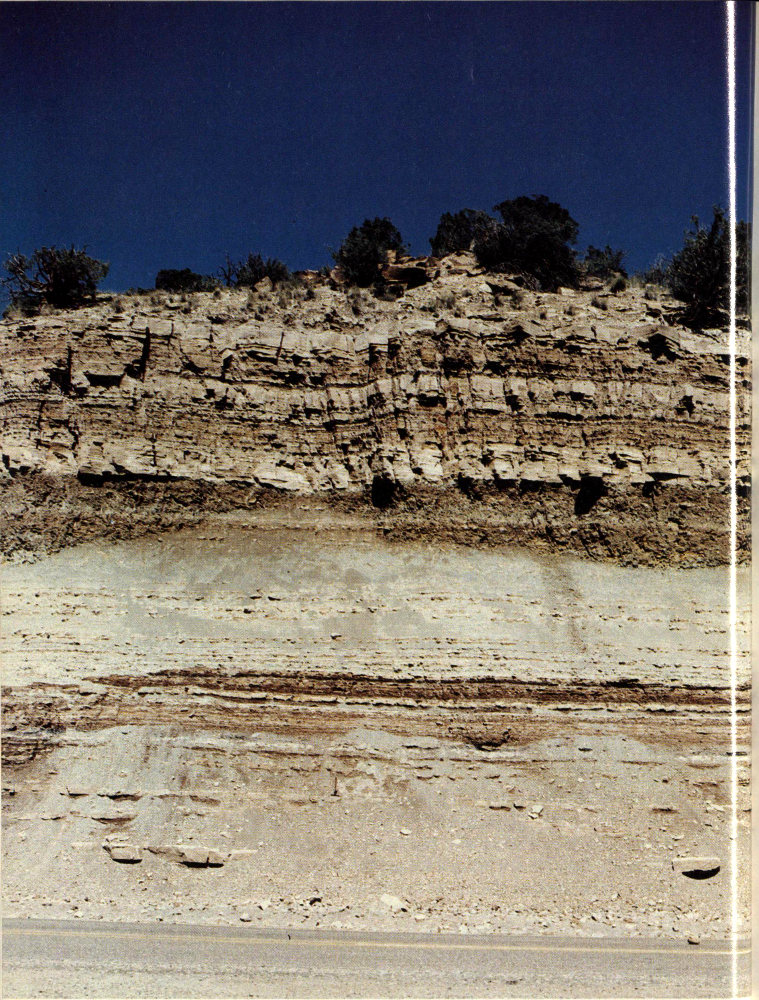
SUMMERVILLE FORMATION, at Artists Point (fig. 3). Base of formation rests upon Moab Member of Entrada just beneath the pavement. Note geologist’s pick resting upon lower ledge of sandstone just to the left of middle. Top of the Summerville here has been removed by erosion. (Fig. 20)
The Summerville at the type locality in the San Rafael Swell, Utah, is much thicker than in the Monument and contains many chocolate-brown beds; but the Summerville exhibits the same lateral continuity of even the thinnest beds. Thin sedimentary beds of such uniform thickness are thought to have accumulated in relatively quiet bodies of water. If you look at the undersides of some of the blocks of hard light-gray sandstone that have broken off, you may see corrugations like those on some metal barn roofs. These are ripplemarks produced by wave or current action while the sand was still loose, which indicates that the water was not always entirely quiet. Although much of the Summerville is red, you will see beds of many other colors including gray, blue gray, greenish gray, chocolate brown, and reddish brown.
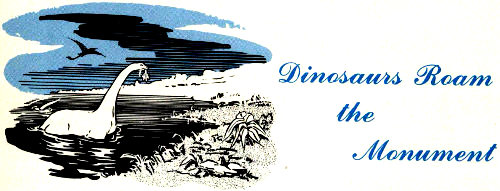
In Late Jurassic time the sea to the west eventually dried up, either because it was filled with sediments or because the land rose above sea level, or both. This brought about a change from the parallel bedding in the marginal marine environment of the Summerville to irregular stream-channel sandstones, flood-plain silts and muds, and freshwater lake deposits.
Streams from higher lands to the south brought in mud, silt, and sand that piled up hundreds of feet thick over thousands of square miles, including the Monument. These sediments were later compacted into the brightly colored siltstone, mudstone, sandstone, and limestone now known as the Morrison Formation. The colors are about the same as those of the Summerville. Algae and other microscopic organisms extracted calcium carbonate from the lake waters, and when they died this material settled on the lake bottoms to make limestone.
The soft siltstone and mudstone of the Morrison Formation weather rapidly into steep or fairly steep slopes, but the harder beds of sandstone, most of which are in the lower third of the formation, known as the Salt Wash Member, are sculptured into bold ledges or low cliffs. The generally softer upper two-thirds of the formation is called the Brushy Basin Member. The Morrison is best exposed in and southeast of The Redlands, where the bare rocks are carved into badlands like the famous ones of South Dakota. Both the Fruita Canyon and No Thoroughfare Canyon approaches to the Monument pass typical badlands in the Morrison. The entire 600 feet of this formation is best seen in the high bluff on the east side of the mouth of No Thoroughfare Canyon (fig. 21).

MORRISON FORMATION, on east side of mouth of No Thoroughfare Canyon. Forty feet of Summerville Formation at base is concealed by slope wash, but underlying white- and salmon-colored members of Entrada Sandstone are clearly exposed at lower left. Protective caprock at upper right is lowermost sandstone of Cretaceous Burro Canyon Formation. Upper two-thirds of Morrison is typical of the Brushy Basin Member; lower one-third is not typical of the Salt Wash Member, which generally contains more and thicker lenses of sandstone, some of which are just around the corner to the right. Mesa on left skyline is above Serpents Trail in the Monument. Looking west from Little Park Road. See also figures 55 and 60. (Fig. 21)
In parts of the Colorado Plateau southwest of the Uncompahgre Plateau, the sandstone lenses in the Salt Wash Member of the Morrison contain uranium and vanadium ore associated with carbonaceous matter, including coalified wood. No ores have been found in or near the Monument presumably because such carbonaceous matter, which helped precipitate the ores, is lacking on the northeastern side of the Uncompahgre Plateau.
Some of the beds of siltstone and mudstone in the Brushy Basin Member of the Morrison shown in figure 21 contain bentonite, a clay derived from the decomposition of volcanic ash, which indicates the presence of active volcanos in or near the Plateau at the time these beds were deposited. Bentonite swells when wetted, so it is widely used in well-drilling muds, sealing canals, etc. Some bentonitic material has been dug from the Brushy Basin along the Little Park Road just south of the point from which the photograph in figure 21 was taken and was used for sealing irrigation canals in the Grand Valley.
The Morrison is not well exposed in the Monument, as the formation is restricted to the higher parts where most of it is hidden by vegetation. The lower part is seen in roadcuts and outcropping ledges along a high stretch of Rim Rock Drive between Artists Point and the head of the west arm of Ute Canyon, where sandstone lenses in the Salt Wash Member are especially thick.
The climate during Morrison time was wet enough to 50 support abundant vegetation along the many lakes and streams—at least enough to feed the hungry dinosaurs and other reptiles that roamed the area. Many bones and parts of several skeletons of dinosaurs have been found in the Morrison at several places in The Redlands not far northeast and northwest of the Monument.
The most famous dinosaur locality near the Monument is Riggs Hill where, in 1900, the late Elmer S. Riggs of the Field Columbian Museum (now Field Museum of Natural History) dug out part of the first known skeleton of a huge Brachiosaurus (fig. 22). This discovery made quite a splash in the scientific world, for it was the first and only type of dinosaur found whose front legs were longer than its hind legs. The fossilized thigh bone (femur) alone is 6 feet 8 inches long and weighs 549 pounds; the arm bone (humerus), though incomplete, is even longer. The ribs are 9 feet long. A bronze plaque now marks the site of the excavation (fig. 39).
In 1901, Riggs removed all but the forepart of a skeleton of Apatosaurus from the southeast side of a large hill of the Morrison Formation just south of the old Fruita bridge. Riggs also found remains of Diplodocus, Camarasaurus, and Morosaurus, and, in 1937, Al Look, prominent writer and amateur paleontologist of Grand Junction, and Edwin L. Holt, an instructor in Mesa College at Grand Junction, found the closely associated remains of Allosaurus, Stegosaurus, and Brachiosaurus at the western end of Riggs Hill. Dinosaurs generally are thought of as huge creatures—many were huge indeed (fig. 23)—but they came in various sizes and some were quite small.
An interesting Late Jurassic vertebrate fossil locality in the Salt Wash Member of the Morrison Formation, about 3 miles northwest of the West Entrance of the Monument and about 3 miles southwest of Fruita, was discovered in June 1975 by George Callison, Associate Professor of Biology and Research Associate in Vertebrate Paleontology at the California State University at Long Beach. During the summers of 1975 and 1976 Dr. Callison and his assistants removed the closely associated skeletal remains of many small, primitive mammals and both small and large dinosaurs and other reptiles. Part of the results were presented in an unpublished manuscript.[28] During the summer of 1977 and later, additional mammalian fossils were removed by Callison and assistants and additional reptilian fossils were removed by Lance Erickson, paleontologist 51 of the Historical Museum and Institute of Western Colorado (fig. 2). Hopefully, the work will be continued with the aid of grants from several sources.
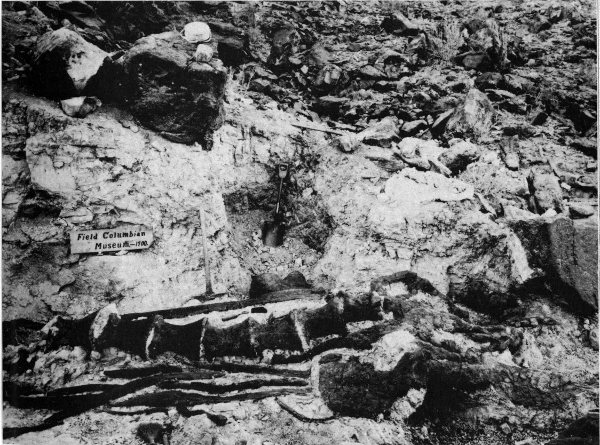
EXCAVATING TYPE SPECIMEN OF BRACHIOSAURUS ALTITHORAX RIGGS from south side of Riggs Hill. Photograph taken in 1900, reproduced by permission of the Field Museum of Natural History (Chicago). See also figure 39. (Fig. 22)
The locality, which covers parts of about 180 acres of public land administered by the Bureau of Land Management, has been fenced and posted to discourage vandalism, and has been designated the Fruita Paleontological Area.
In order to evaluate the importance of the locality and to make plans for its future development and protection, the Bureau of Land Management held the Fruita Paleontological Workshop on March 28-30, 1977, to which were invited several renowned vertebrate paleontologists and archaeologists together with interested local personnel of the Bureau, the National Park Service, and the Museum. All remarks and prepared speeches were taken down by a shorthand reporter and were reproduced for the attendees in the 83 page unpublished “The Fruita Paleontological Report.”

SKELETONS OF TYPICAL DINOSAURS OF MORRISON FORMATION.[29] A, Camptosaurus, a small dinosaur about 11 feet long; B, Apatosaurus, a gigantic dinosaur about 76 feet long; C, Allosaurus, a large carnivorous dinosaur about 30 feet long; and D, Stegosaurus, a large armored dinosaur about 24 feet long. (Fig. 23)
The close association of Late Jurassic mammalian and reptilian fossils, as found at the Fruita site, is of considerable interest and importance, but is by no means unique, for similar associations occur elsewhere in Colorado, and in Wyoming, Europe, and Africa. Of those in the United States, the quarry at Como Bluff, near Laramie, Wyo., is considered by most of the experts to be the most outstanding. Of the material unearthed at Fruita thus far, which includes bones of some of the large dinosaurs found earlier by Riggs, remains of some of the smaller dinosaurs and a complete skull of the moderately large flesh eater Ceratosaurus are considered the most important.
Freshwater clam and snail shells abound in some beds of the Morrison, particularly in limestones, and occur sparingly in other types of beds. The shells occur mainly in The Redlands, particularly about 1½ miles west of the Fruita bridge. Some of these shells that are filled with agate are sought by rockhounds.
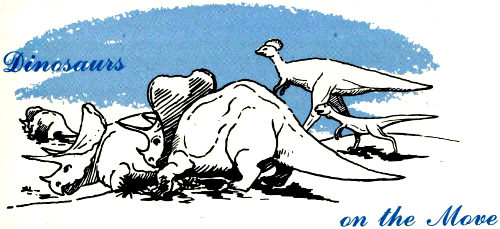
The wet climate of Late Jurassic time was followed by arid or semiarid climate in the Early Cretaceous. Streams continued to deposit gravel, sand, silt, and mud, but at a much slower rate. These deposits eventually hardened into the conglomerate, sandstone, and green shale or siltstone of the Burro Canyon Formation. This formation, together with part of the overlying Dakota Sandstone, caps Black Ridge, the highest part of the Monument (7,000 feet) about a mile west of the Coke Ovens. Several airway beacons on this high ridge may be seen for many miles. The Burro Canyon is best seen below the Monument on the west side of Monument Road along the lower part of No Thoroughfare Canyon, where it is about 60 feet thick (fig. 24).

BURRO CANYON FORMATION AND DAKOTA SANDSTONE, along west side of No Thoroughfare Canyon, about 2½ miles northeast of the Monument’s East Entrance. Basal sandstone above road and unexposed green shale (brown in photograph) comprise the Burro Canyon, here 58 feet thick. White band two-thirds the way up the slope is 40-foot basal conglomerate of the Dakota Sandstone, above which is 58 feet of carbonaceous shale, a 14-foot bed of sandstone, and 17 feet of sandy shale to the top of the hill. The top of the Dakota has been eroded away. (Fig. 24)
A few fossil plants and shells have come from the Burro Canyon Formation, but the seeming absence of dinosaur bones suggests that possibly these reptiles had to move to areas of greater precipitation, where food was more abundant. Some dinosaurs may have lived in the area at this time, but their bones either were not fossilized or they have not yet been found.

Deposition of the Burro Canyon Formation was brought to a close by another uplift of the Plateau, and of course the uplift was followed by another period of erosion, which continued 55 through the end of Early Cretaceous time. As noted in the caption for figure 24, seemingly all but 58 feet of the Burro Canyon was eroded away, but 120 feet remains along East Creek, only about 12 miles to the southeast, which suggests that the old erosion surface was a bit uneven. That this period of erosion was of considerable duration is suggested by the abundance of the white clay mineral, kaolinite, beneath and in the overlying white basal conglomerate of the Dakota Sandstone. This type of clay commonly results from prolonged weathering of many types of rocks and indicates that the period of pre-Dakota erosion was of long duration.
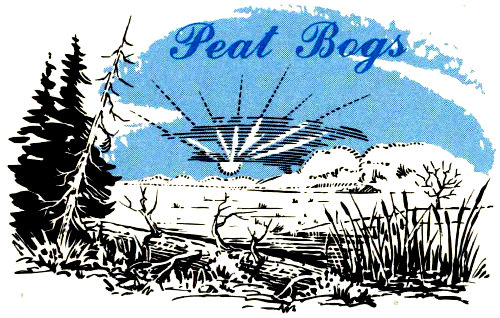
By the beginning of Late Cretaceous time the eroded surface of the Monument was part of a low plain near sea level, and the sea was gradually encroaching from the east or northeast. Gravel and sand carried in by streams combined with the white kaolinite on the surface to form the 40-foot basal conglomerate of the Dakota Sandstone (fig. 24).
As the land gradually subsided nearer to sea level, swamps which were formed along the coast supported considerable vegetation. As the trees and plants died and were covered by silt and mud, they gradually changed to peat which finally became compacted into coal and brown or black coaly shale containing plant remains. You can dig out some of this coal and perhaps find some plant remains near the top of the west canyon wall just below the highest sandstone bed in figure 24, which is outside the Monument.
For awhile the coast alternately sank slightly below and rose slightly above sea level. Beach sand covered the swamp deposits, then more swamp deposits covered the sand. Some of the sand contains seashells, such as oysters and clams.
Except on Black Ridge, the Dakota has been entirely eroded from the Monument, but it crops out with the underlying Burro Canyon in a series of low hills south of the Colorado River. The Dakota Sandstone is about 200 feet thick.

Still later in the Cretaceous Period the whole region sank beneath the sea and stayed there a long time. Silt and limy mud were piled layer upon layer on the sea floor and hardened into the gray and black Mancos Shale. Thin layers of sand were cemented into sandstone, and layers of calcium-carbonate mud became chalk or limestone. Seashells and bones of sharks and seagoing reptiles have been found in the Mancos in many places.
The Mancos and all younger rocks have been stripped off the Monument, but they may be seen one after the other as you travel northeastward. Thin remnants of the Mancos cap low hills just south of the Colorado River, and the entire 3,800 feet of the Mancos underlies the Grand Valley and Book Cliffs. The upper part is clearly exposed in the towering, barren Book Cliffs, where the soft shale is protected by a caprock of hard sandstone—the lowermost unit of the overlying Late Cretaceous Mesaverde Group (fig. 25).

Slow uplift of the Plateau, including the Monument region, caused the gradual retreat of the Mancos sea. Deposition of mud on the sea bottom gave way to deposition of beach sand, coal swamps, and then more beach sand and coal swamps. Finally, in Late Cretaceous time, the sea withdrew entirely, never again to return to the Colorado Plateau region.
Streams deposited sand, silt, and mud on the newly uplifted 57 coastal areas. All these deposits, including some high-grade bituminous coal that was formed in the swamps, we now know as the Mesaverde Group. The thick cliff-forming sandstones of this unit are beautifully displayed in DeBeque Canyon of the Colorado River between Palisade and DeBeque, just upstream from the Grand Valley. There are several active coal mines in the Mesaverde between Palisade and Cameo, and outcrops of coal may be seen on the east side of the road just south of Cameo. The electric generating station of the Public Service Company of Colorado at Cameo is conveniently situated over a coal mine and next to the Colorado River, which supplies cooling water.

MOUNT GARFIELD, a prominent point on the Book Cliffs bordering the northeastern side of the Grand Valley. Slopes are Mancos Shale; ledge about halfway upslope is the toe of an ancient landslide deposit of Mesaverde sandstone blocks marking the level of an ancestral Grand Valley; capping beds of sandstone at crest are basal beds of Mesaverde Group. (Fig. 25)

PHOTO INDEX MAP, showing localities where most of the photographs were taken. Arrows point to distant views. Numbers refer to figure numbers. (Fig. 26)
Photographs for four figures are not shown because
figures 5, 25 and 36 were taken outside the map
borders and figure 1 was taken at an undisclosed
locality in the monument
High-resolution Map
The remains of dinosaurs have been discovered in rocks of this age elsewhere, but near the Monument only their tracks have been found. Some of these, in coal mines along the Book Cliffs and near Cedaredge, are 38 inches across and their placement indicates an incredible stride of 16¼ feet! Had there been highways in Mesaverde time, this bipedal giant could have crossed them in two strides.
Both the Mancos and Mesaverde once covered the Monument area but were removed long ago by erosion.
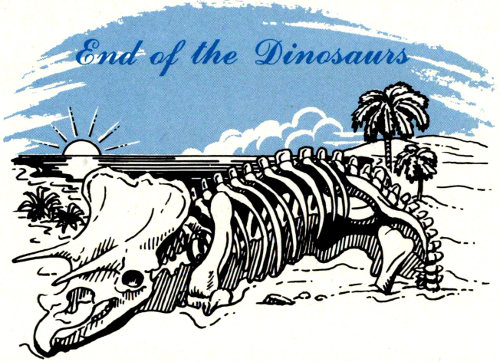
The end of the Cretaceous Period was also the end of the dinosaurs. Exactly why the “terrible lizards” died out after dominating the world for more than 150 million years is not known for sure, but many guesses have been made.
One likely idea is that widespread uplift and mountain building that began late in Cretaceous time, accompanied by changes in climate, may have greatly reduced the supply of soft edible plants. If so, it is easy to imagine how huge dinosaurs accustomed to a ton or more of lush plant food each day would soon starve to death.
Many dinosaurs were vegetarians. As they died out, the flesheaters, such as Tyrannosaurus, soon ran short of food also, and probably began to eat each other. Tyrannosaurus closely resembled the Jurassic Allosaurus shown in figure 23, except that Tyrannosaurus was much larger and more formidable—in fact it probably was the most terrible predator that ever roamed the surface of the Earth. The dinosaurs had become too highly specialized to their environment to adapt themselves to changes of this kind.
Another fascinating notion is that the growing population of 61 small primitive mammals devoured dinosaur eggs (which were left unattended like those of turtles and alligators) nearly as fast as mamma dinosaur could lay them. But whatever the reason, it is clear that some worldwide condition caused the gradual extinction of the ponderous over-specialized dinosaurs and allowed the rise to power of the next types of animals destined to rule the Earth—the brainier and more adaptable mammals.
At this time the rocks were gently bent into upfolds, called anticlines or arches, and downfolds, called synclines or basins (fig. 27). One upfold that began to take form was the Uncompahgre arch, the crest of which shapes Piñon Mesa just south of the Monument. But this gentle upfold was to grow larger and to have its flanks wrinkled and broken in the next geologic era—the Cenozoic.

The beginning of the Cenozoic Era 65 million years ago—give or take a few million years—marked the beginning of a long span of geologic time during which mammals became the ruling land animals. Remains of some small primitive mammals have been found in Mesozoic rocks (p. 50), but these tiny newcomers did not have a chance to flourish until the formidable dinosaurs died out.
The Cenozoic Era is divided into the long Tertiary Period—The Age of Mammals—and the short (about 2 million years) Quaternary Period—The Age of Man. The Tertiary in turn is divided into five epochs—the Paleocene, Eocene, Oligocene, Miocene, and Pliocene (fig. 61). Events during parts of the Tertiary Period had an important bearing upon the Monument even though no rocks of this period now occur in the area.

COMMON TYPES OF ROCK FOLDS. Top, anticline, or upfold; closed anticlines are called domes. Middle, syncline or downfold; closed synclines are called structural basins. Bottom, monocline, a common type on the Plateau in which the dip of the beds changes in amount but not in direction; axes may be mapped along trends of upper fold, middle flexure, or lower fold. Top and middle diagrams from Hansen (1969, p. 31, 108). (Fig. 27)
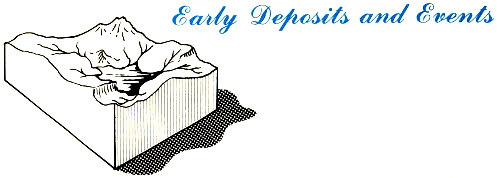
The broad inland basins that were formed late in the Cretaceous Period received sand, silt, and mud brought in by streams from the uplifted or folded areas. These materials became compacted into the Wasatch Formation—the red or pink rock from which Bryce Canyon National Park was sculptured. One such basin lay just northeast of the Monument. The Monument probably was covered by some of these stream deposits after the main basin was partly filled.
The mammals that roamed the area during the Paleocene Epoch were primitive, but more advanced forms appeared later, in Eocene time. Some of their fossil remains have been found in the Wasatch Formation in Plateau Creek Valley north of Grand Mesa and near Rifle, about 60 miles northeast of Grand Junction. The entire 5,000 feet of the Wasatch may be seen along U.S. Highway I-70 between the towns of DeBeque and Grand Valley, and much of it helps support towering Grand and Battlement Mesas.
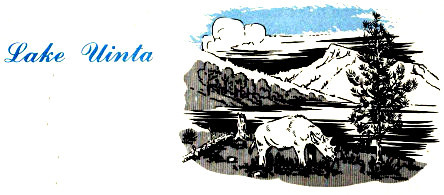
In Eocene time the northern part of the Colorado Plateau sagged downward and gradually filled with water until it became a huge lake, now known as Lake Uinta. The waters in it teemed with plants and animals, particularly micro-organisms such as algae, whose remains, coated with calcium carbonate, settled to the bottom along with the sand, silt, and mud washed into the lake by streams. These sediments compacted into the remarkable Green River Formation which contains, among many rock types, large deposits of rich oil shale.
The light-colored Green River Formation, which is about 3,800 feet thick, may be seen from U.S. Highway I-70 in the 64 upper part of the towering Roan Cliffs on the northwest side of the Colorado River between DeBeque and Rifle. It also underlies the volcanic caprock of Grand and Battlement Mesas. John R. Donnell, of the U.S. Geological Survey, estimated that the oil shale in the Piceance Creek Basin, northwest of the Colorado River alone, contains more than one trillion barrels of oil. The Monument was at or near the south shore of this lake, and may have been covered with a few hundred feet of the Green River Formation.

Lakes, like mountains, are temporary things. Even as lakes are forming, sediment begins to fill them until ultimately they are obliterated. So it was with Lake Uinta. Sometime after this lake dried up, the Earth’s crust again became restless. The gentle folds that were formed late in the Cretaceous were lifted higher and bent more sharply, and the flanks of some folds were wrinkled and broken (figs. 27, 28). The sharply bent or broken rocks along the northeastern border of the Monument are thought to have been deformed mainly at this time, but in part both earlier and later. That pronounced folding of the rocks followed the deposition of the Eocene Green River Formation is clearly shown along the Grand Hogback monocline between the towns of Rifle and Meeker, Colorado, where the once flat lying beds of the Green River and Wasatch Formations now stand vertical.
The folds and faults along the northeastern border of the Monument, which are shown on the geologic map (fig. 8), are discussed briefly here—more details are given later in “Trips through and around the Monument.” The folded and faulted northeastern border of the Monument, which is shown in figure 29 and in several ensuing photographs, is believed to have resulted from renewed uplift of the area southwest of the folds and faults, including the Monument. The Redlands fault (figs. 8, 29, 37, 38, 40, 41) generally is a normal fault but locally is a reverse fault, as discussed on page 92 and as shown in figure 40 and in the cross section of figure 8. This fault has a 65 maximum vertical displacement of 700 or 800 feet, but dies out in scissors fashion at each end. Beyond the end of the Redlands fault in the upper right of figure 29 may be seen another unbroken monocline. A close-up view of the northwestern end of this fold in shown in figure 30.

COMMON TYPES OF FAULTS. Top, normal, or gravity, fault which generally results from tension in and lengthening of a segment of the Earth’s crust, which allows the lower block to subside. However, some normal faults, particularly some that are vertical or nearly so, may result from uplift of the upper block. Low-angle reverse faults generally are called overthrust faults or simply overthrusts. In both the normal and reverse faults note amount of displacement and repetition of strata. Displacement of such faults may range from a few inches to many thousands of feet, and in overthrusts may reach many miles. From Hansen (1969, p. 116). (Fig. 28)
If we proceed about a quarter of a mile northeast of the point from which figure 30 was taken, walk about 50 feet north, and look to the northwest, we see quite a different structure, for here the gentle lower fold of the Lizard Canyon monocline has become the east end of the Kodels Canyon fault (fig. 31).
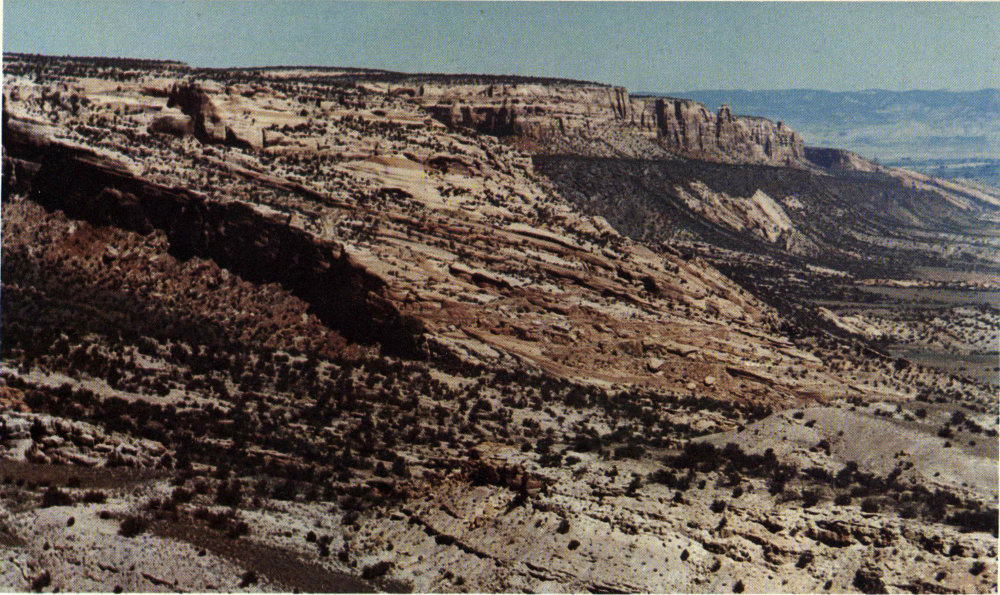
LADDER CREEK MONOCLINE AND REDLANDS FAULT, telephoto view looking northwest from point near Little Park Road east of the Monument. No Thoroughfare Canyon in foreground, which is bordered on the left by northeastward-dipping beds of Wingate Sandstone at northwest end of Ladder Creek monocline. The old Serpents Trail, the lower part of which is barely visible, ascends this dipping block of rock. The dark Proterozoic rocks form the flat-topped bluff to the right and are exposed by the Redlands fault which lies just above the sharply upturned remnants of the Wingate Sandstone. (Fig. 29)

LIZARD CANYON MONOCLINE, looking southeastward across mouth of Lizard Canyon from southeasternmost loop of Rim Rock Drive just before it ascends Fruita Canyon. Note gentle lower bend at lower left and sharper upper one at upper right. Lower bend changes to Kodels Canyon fault in Fruita Canyon behind camera station. Grand Mesa forms left skyline. (Fig. 30)
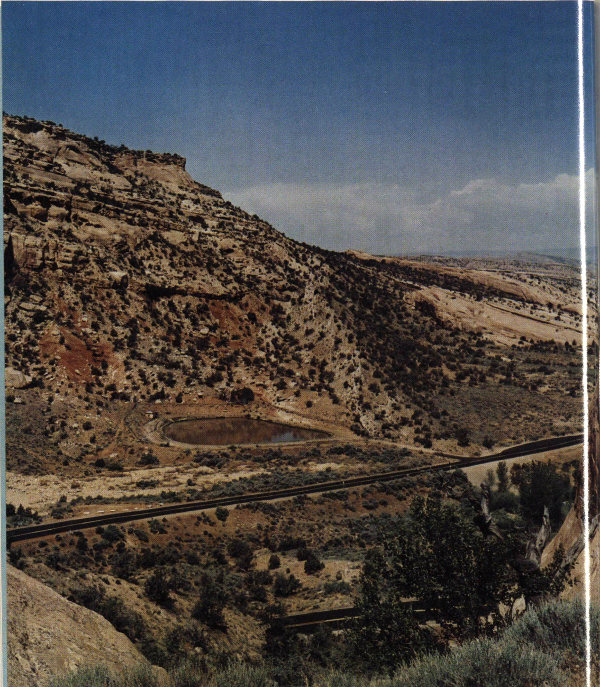
KODELS CANYON FAULT, looking northwest across mouth of Fruita Canyon from point on Rim Rock Drive just described in text. Here, along a normal fault dipping steeply northeastward, the 350-foot cliff of Wingate Sandstone at upper left has been sheared and squeezed into only a few feet of broken rock overlain by a steep slope of the Kayenta Formation covered by piñon and juniper. The thinner cliff at right is the Entrada Sandstone which belongs high atop the cliffs at left. Book Cliffs form distant skyline at right. (Fig. 31)
If you doubt that figure 31 shows a fault, a glance at figure 32 in the next major canyon eight-tenths of a mile to the northwest should convince you. Here, on the northwest side of Kodels Canyon, the Wingate was not thinned but was rent completely asunder by the vertical Kodels Canyon fault (fig. 32). Kodels Canyon is not readily accessible to visitors.
The Lizard Canyon monocline, Kodels Canyon fault, and other structures are clearly shown in the stereoscopic pair of aerial photographs in figure 33.
Another structural feature within the Monument is the Glade Park fault (fig. 8), which lies mainly south of the Monument but just cuts across the south end of No Thoroughfare Canyon in the latest addition to the Monument. It is well shown both from the air and the ground in figures 58 and 59. It is unique among all the major faults in the area in that the rocks south of the fault subsided with respect to those on the north side.

KODELS CANYON FAULT, looking northwestward across canyon of same name. Base of Wingate cliff on left is just about opposite the top of the Wingate on right. Here, nature was kind to the geologist, for the vertical displacement (rise of left side with respect to right side) is virtually the thickness of the Wingate Sandstone—about 350 feet. The Wingate on the right is lighter colored than that on the left seemingly because rockfalls removed desert-varnish-coated rocks and exposed the true color of the sandstone. (Fig. 32)
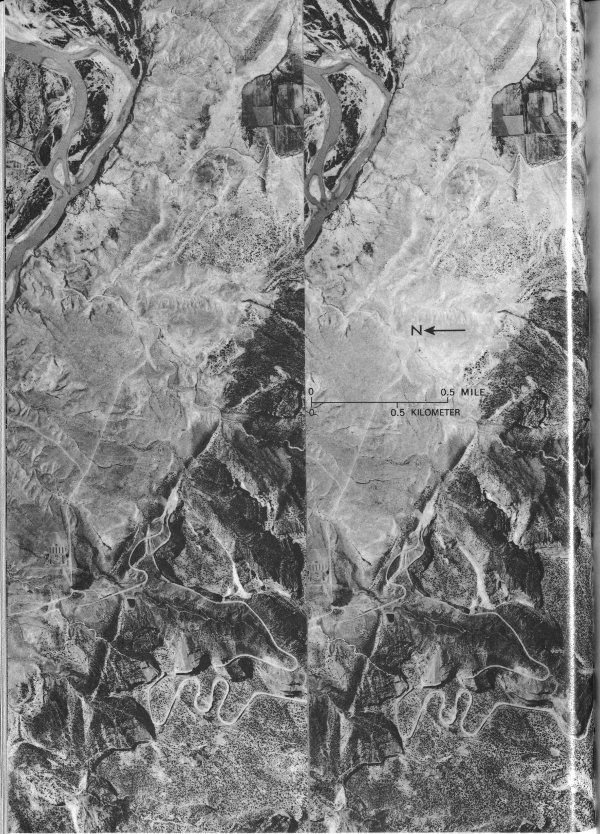
GEOLOGIC STRUCTURES AT FRUITA ENTRANCE TO COLORADO NATIONAL MONUMENT. The stereoscopic pair of aerial photographs may be viewed without optical aids by those accustomed to this procedure, or by use of a simple double-lens stereoscope, such as the folding ones used by the armed forces during and after World War II. Geologic details may be identified by comparing photographs with the geologic map, figure 8. If viewer is unable to see stereoscopic pairs in three dimensions, looking at either photograph alone will convey a good idea of the geologic structure. The monocline near top of the photographs may be seen on the right-hand side of the highway in figure 43. Photographs taken in 1937 by U.S. Soil Conservation Service, hence, alinement of then unpaved Colorado Highway 340 differs from the paved present highway. (Fig. 33)
At this point in our story it might be well to point out that the folding and faulting of the rocks just described occurred when thousands of feet of younger rocks covered the area. Additional folding and faulting, drainage changes, and gradual removal of the overlying rocks occurred during the remainder of the Tertiary and Quaternary Periods, as will be discussed further.
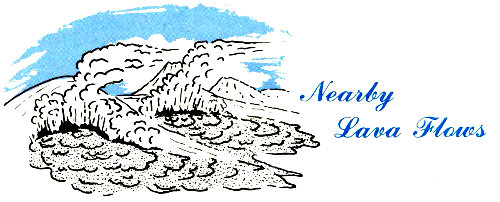
Grand and Battlement Mesas, respectively east and northeast of the Monument, are capped by several resistant thick flows of dark basaltic lava. The molten rock welled up through fissures at the east end of Grand Mesa and flowed westward and northwestward over the eroded surface of Eocene rocks. Radiometric dating of a sample of the basalt indicated an age of 9½ million years plus or minus half a million years, placing the event in the Miocene Epoch of the Tertiary Period (fig. 61).
A small remnant of the lava on the crest of the Roan Cliffs just southwest of the present town of Grand Valley indicates that the flows crossed this part of the ancestral Colorado River Valley and may have pushed the young stream westward.
The lava flows are about 800 feet thick on the eastern part of Grand Mesa but are only about 200 feet thick above the western rim of the mesa. As the ancestral Gunnison River is believed to be pre-Miocene in age, it is not known whether or not the lava flows crossed the old river valley and reached as far west as the Monument.
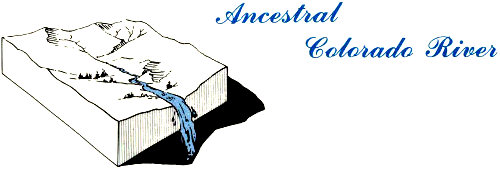
During most of the Pliocene Epoch the ancestral Colorado River did not flow past what is now Grand Junction; instead, it joined with the ancestral Gunnison River about 10 miles southeast of the present city, and the combined streams flowed southwestward across the slowly rising Uncompahgre arch through what was later to be called Unaweep Canyon (fig. 36). Southwest of the canyon, near the site of the present town of Gateway, the ancestral Colorado River was joined by the combined flows of the ancestral San Miguel River and the previously diverted ancestral Dolores River, then it flowed northwestward to what is now the mainstem of the Colorado River.
I have attempted to show my ideas of this ancient drainage system as it may have existed in middle to late Pliocene time in figure 34. But the stage was set for more spectacular drainage changes to follow.
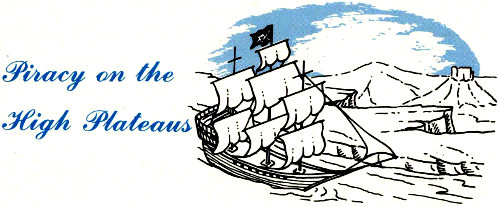
Rivers, like people, do not always choose their courses wisely. After a few million years of downcutting through the soft sedimentary rocks, mainly what is now called the Mancos Shale, the ancestral Colorado and Gunnison Rivers found themselves cutting through the hard Proterozoic rocks in a deep gorge athwart the slowly rising Uncompahgre arch, which greatly slowed the downcutting power of the combined streams. Note in figure 34A that while the mighty ancestral 73 Colorado and Gunnison Rivers were in this frustrating predicament, a young upstart tributary began cutting northward from what is now the mouth of the Dolores River (fig. 34D). Although the combined main rivers could lower their channel only very slowly because of the hard rock in Unaweep Canyon, the tributary was able to cut downward and headward quite rapidly through the soft Mancos Shale. It eventually cut around the northwestward dipping Uncompahgre arch and headed southeastward toward the ancestral Colorado River near the present site of Palisade.
Then occurred an act of piracy that put to shame the mightiest exploits of Blackbeard and Captain Kidd. In latest Pliocene or earliest Pleistocene time additional uplift of the Uncompahgre arch, an unusually large flood, or both, caused the ancestral Colorado River to overflow its banks and spill across a low shale divide into the headwaters of the tributary. Some ponding may have preceded the spillover. With this enormously increased supply of water, the tributary cut down rapidly through the soft shale and captured the entire flow of the Colorado River, but the ancestral Gunnison River still flowed through Unaweep Canyon, as shown in figure 34B. Stream capture of this type is appropriately called “piracy.”
But the piracy had not ended. Note in figure 34B that the “new” river sent out several tributaries, one of which headed for and, with the aid of yet additional and greater uplift, soon captured the ancestral Gunnison River, as shown in figure 34C. This second act of piracy left Unaweep Canyon really “high and dry” except for small streams that carried off what little water the canyon received from local rain and snow. While these piracies were taking place, the Book Cliffs and the edge of Grand Mesa gradually retreated away from the valley because of erosion, and more of the Uncompahgre arch was uncovered.
The rising Uncompahgre arch, whose renewed uplifts in latest Pliocene or earliest Pleistocene times played such an important role in the ultimate abandonment of ancestral Unaweep Canyon, was asymmetric in that the crest was not in the middle but was near the southwest side. Although sharp, locally faulted monoclines are found on both sides of the arch, including the part within the Monument, in general, the northeastern flank has a rather gentle northeastward dip; whereas, the southwestern flank of the arch also is bordered by normal faults of considerable vertical displacement.[31] Thus, after abandonment, the minor drainage in Unaweep Canyon continued to flow northeastward from a new divide near the southwestern border, and ancestral West Creek began cutting northeastward toward the new divide. The drainage pattern depicted in figure 34C differs slightly from my earlier interpretation and results from additional fieldwork.[32]
PROBABLE DRAINAGE PATTERNS AND LAND FORMS NEAR THE MONUMENT AT FOUR SUCCESSIVE STAGES OF DEVELOPMENT. Solid drainage lines taken from the Moab and Grand Junction, Utah-Colorado, topographic maps of the Army Map Service; dashed drainage lines are my own ideas. A, just prior to piracy of ancestral Colorado River; B, after piracy of ancestral Colorado River and just prior to piracy of ancestral Gunnison River; C, abandonment of Unaweep Canyon after renewed uplift of Uncompahgre arch and piracy of ancestral Gunnison River; and D, present drainage pattern after additional uplift and piracy of East Creek. Modified from Lohman (1961, 1965a, 1965b). (Fig. 34)

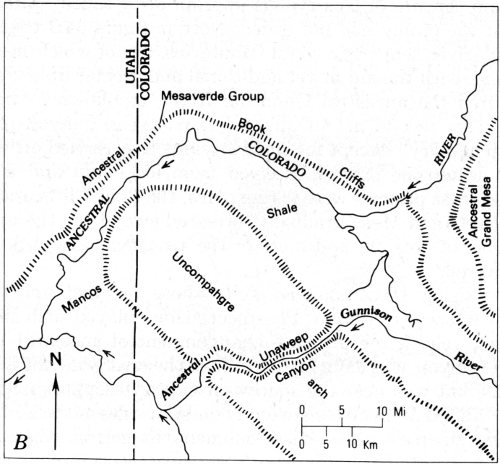
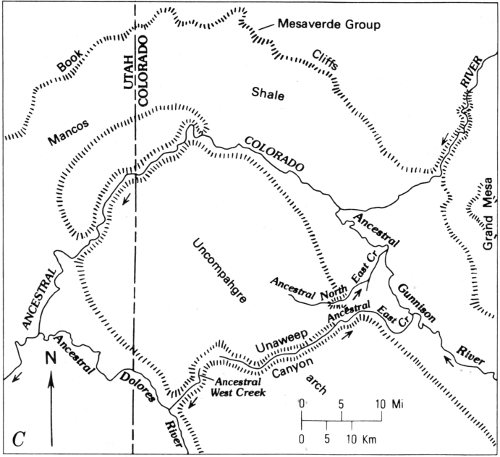
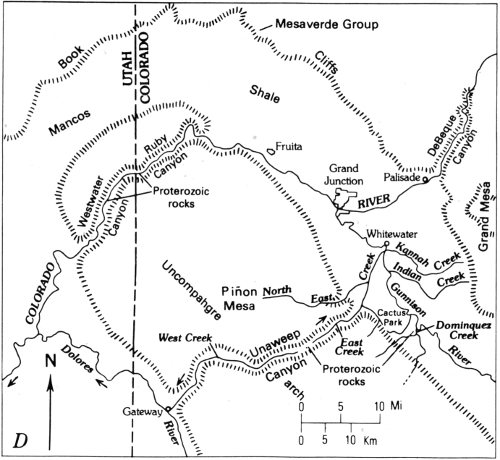
At the time of abandonment, ancestral Unaweep Canyon was a V-shaped canyon resembling Glenwood Canyon just upstream from the city of Glenwood Springs, Colorado. The reasons for its change in shape and appearance to the beautiful U-shaped canyon we find today and the profound effect the abandonment of Unaweep Canyon had on the deepening of the Grand Valley and the canyons of the Monument will be brought out in the section “Canyon Cutting.”

Like the dinosaurs before them, a few of the Tertiary mammals were so long on brawn and short on brains that they evolved into grotesque monsters and overspecialized themselves into early extinction. Fortunately, however, most of the mammals evolved more slowly and moderately into the forms we find today.
One group—the anthropoid primates—began to think, so they developed their brains rather than their brawn, particularly the Tertiary ancestors of man. Few remains of these ancestors have been found in Tertiary rocks, but many more have been discovered in rocks of the next geologic period—the Quaternary. Thus, this period may properly be regarded as the age of man, for man then began to dominate the Earth for better or for worse.
The Quaternary—latest and shortest of the geologic periods—is divided into the Pleistocene and Holocene (recent) Epochs (fig. 61).
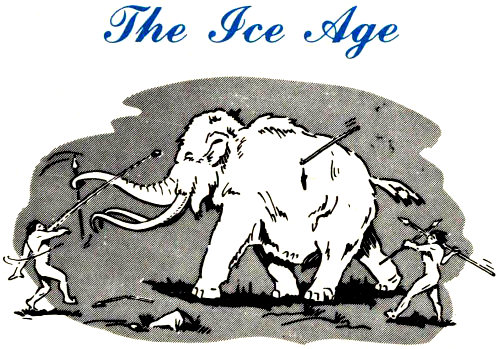
During the Pleistocene Epoch, all continents of the Northern Hemisphere and some of the Southern Hemisphere were partly covered at least four times by huge glaciers. Each glacial advance in Europe and North America was ended by a warmer interval during which the glaciers melted and retreated northward; then, vegetation and soil had time to become re-established. Thus, the Pleistocene has properly been called the ice age.
None of the continental glaciers reached the Monument or the Uncompahgre Plateau, or arch, but small alpine glaciers grew in the high Rocky Mountains to the east, sculpturing sharp-crested peaks and ridges and forming beautiful valleys and lakes. Many of the beautiful lakes on Grand Mesa were formed by glaciation, but some near the edges were formed by landslides.
The increased streamflow from the greater precipitation and from melting alpine glaciers in the Rockies, particularly during times of glacial retreat, helped the Colorado River cut through the rocks faster, thus assisting in the formation of Colorado National Monument as we see it today. The river carried thousands of cubic miles of sediment to the Gulf of California, including a lot of rock that once covered the Monument, and the river is still actively at work on this immense earthmoving project.
If the ancestral Colorado River carried sediment at about the same rate as the present river since the building of Hoover Dam, it may have carried about 3 cubic miles of sediment each century. Now most of the rock debris is being dumped into Lake Powell—the new reservoir behind Glen Canyon Dam. When this, Lake Mead, and other reservoirs ultimately become filled with sediment, the Gulf of California will again be the burial ground.
But other events during the Pleistocene also played a role in shaping the area. The Uncompahgre arch was again uplifted and deformed in the Pleistocene soon after the abandonment of Unaweep Canyon. This caused added tilting of the strata and more bending and breaking along some of the folds and faults in the Monument.

East Creek, which drains the northeastern half of Unaweep Canyon, was forced to change its course during the Pleistocene Epoch by another act of piracy. After capture of the Gunnison River by the newly routed Colorado River, East Creek joined the Gunnison by way of Cactus Park. Then, a tributary of North East Creek headed southward and captured East Creek, as shown in figure 34D.

When the Colorado River was diverted into its new course through the Grand Valley past the Monument, the stream channel seems to have been only about 600 to 800 feet higher than it is today, but the present divide in Unaweep Canyon is now about 2,500 feet higher than the channel. The difference of 1,700 to 1,900 feet was caused by the additional uplift of the Uncompahgre arch during the Pleistocene.
Thus, the Grand Valley and its tributary canyons, such as those of Colorado National Monument, were cut since the abandonment of Unaweep Canyon, probably mainly during the Quaternary Period. This suggests that the cutting of the 79 Monument’s canyons began only about 2 million years ago, but that much of the canyon cutting occurred only a few hundred thousand years ago. Indeed, the canyons are still slowly being deepened, lengthened, and widened.
As you stand on any of the lookout points and gaze down into the canyons of the Monument, you may well wonder how such immense chasms could have been cut by such puny streams that are dry most of the time. The streams flow only for short periods after heavy thundershowers or after rapid melting of snow. If you are lucky enough to see them flow, you will notice that the water is red or brown because of the suspended mud, silt, and sand. If the flow is large, you may see or hear pebbles and cobbles rolling along the bed. Accordingly, the streams and their cutting tools are slowly deepening the channels. But, you may ask, how does this account for such wide, broad-bottomed, cliff-walled canyons? Such streams act mainly as storm sewers to carry off the rock debris formed by other types of erosion.
When cutting first began, the Monument’s canyons were narrow, steep, and V-shaped. When the top of the hard, dark Proterozoic rocks was reached, however, downcutting slowed just as it had earlier in Unaweep Canyon. While the streams were thus hung up, other erosional processes caused the cliff walls to recede away from the streams, forming broad, flat-bottomed, U-shaped canyons.
Recession of the cliffs away from the middle of the canyons probably was caused partly by undercutting of the soft Chinle Formation by wind and in places by streams. This allowed slabs of the overlying Wingate Sandstone and younger rocks to break off and fall into the canyons—eventually to break up and to be carted off as sand and mud by streams.
But other processes are probably the ones chiefly responsible for the present shape and width of the canyons. The summer sun heats the cliff faces until they are hot to the touch, but in the present desert climate of the Monument the rocks cool rapidly after sundown. Oftentimes the hot cliff faces are chilled rapidly by summer thundershowers. Repeated heating, cooling, wetting, and drying causes expansion and contraction of the rocks so that thin layers break off and fall. This process goes on slowly even in winter on sun-facing cliffs, but it does not occur on the cliffs that face away from the winter sun.
Even more important, perhaps, is the alternate freezing at night and thawing by day on sun-facing cliff faces during the winter. Water in cracks near the cliff faces alternately freezes 80 and melts, gradually prying off slabs of rock. Canyon walls that are shaded from the sun most of the winter, however, stay cold or frozen much of the winter; hence, they are not subject to repeated heating and cooling or freezing and thawing. Thus, you will notice that because of talus accumulation many such canyon walls are sloping rather than vertical.
To illustrate the above conjectures concerning the cutting and shaping of the canyons, let us consider several canyons that trend in different directions. We have seen in figure 12 that the left side of northeastward trending Red Canyon is a nearly vertical cliff that faces the sun most of the winter; whereas, the right side, which is shaded most of the winter, slopes gently enough to be climbed at many places. The sides of Ute Canyon, which trends more nearly northward (fig. 52), slope about equally, as would be expected. However, the west arm of the Canyon, which trends slightly southeastward, has sides whose slopes differ markedly (fig. 35).
This brings us to the remarkable transformation of the original V-shape of Unaweep Canyon to the beautiful U-shape of the present canyon, which is shown in figure 36. The abandonment of Unaweep Canyon discussed earlier removed the gigantic storm sewer that for millions of years carried off the products of vigorous erosion of the canyon walls by the processes just described. Rock materials that now fall from the cliffs of the inner gorge in hard Proterozoic rocks and that fall from the overlying softer sedimentary rocks simply pile up at the foot of the cliffs to form a canyon equally as U-shaped as those cut by glaciers in the high mountains. Indeed, Unaweep Canyon has been mistaken for a glacial canyon by many, including some geologists.
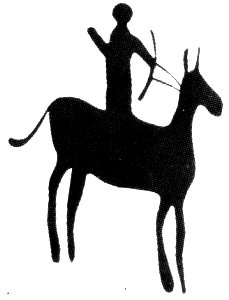
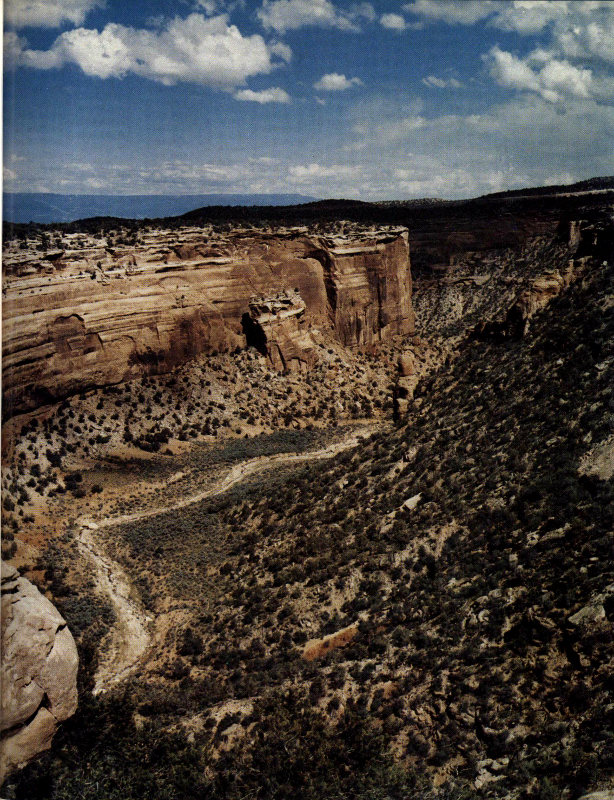
FALLEN ROCK, in west arm of Ute Canyon below waterfall, from Fallen Rock Overlook. Note that the sun-facing left side of canyon, containing the fallen block of Wingate Sandstone, is a vertical cliff; whereas, the shaded right side can be readily climbed. The right side contains a trail near the middle of the picture, but it is hidden by vegetation. (Fig. 35)
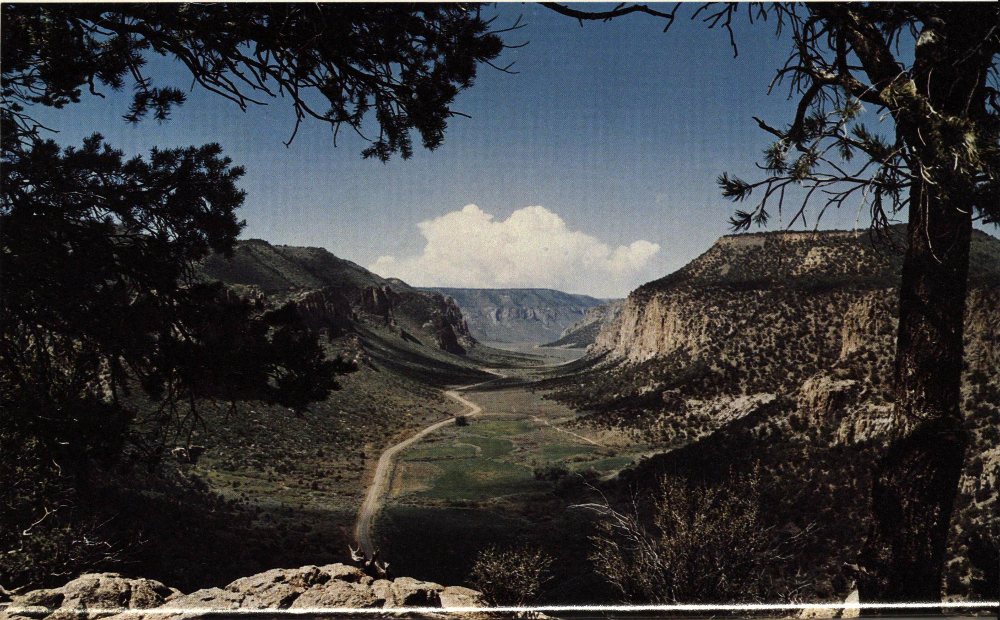
UNAWEEP CANYON, looking southwest from rim of inner gorge cut in hard Proterozoic rocks, just to the right side of first cattle guard on Divide Road, near middle of sec. 16, T. 14S., R. 100 W., about 5 miles northeast of drainage divide shown in figure 34D. Drainage divide is just around the corner to the right of the most distant part of the canyon visible. Slope above vertical cliff on right consists of Chinle Formation, Wingate Sandstone, and flat crest of Entrada Sandstone (Kayenta Formation is absent). Paved road in canyon is Colorado Highway 141. (Fig. 36)

This ends the brief geologic story of Colorado National Monument, except for a peek into the future, a description of trips through and around the Monument, and a comparison with other Parks and Monuments on the Plateau. The temporary nature of lakes, rivers, and even mountains has been discussed—the Monument of today and the new course of the Colorado River are no exceptions.
The Colorado River did not solve its problems by abandoning its hard-rock course in Unaweep Canyon in favor of a soft-rock course through Ruby and Westwater Canyons—it just postponed them. The river has again cut down into its old nemesis—the hard Proterozoic rock—in Ruby Canyon just within the Colorado border, in Westwater Canyon in Utah, and the Gunnison River has reached the hard rock at its confluence with Dominguez Creek, not far above Whitewater, as shown in figure 34D. Thus, once again hard rock is slowing down old man river, and will slow him down for a long time to come. Someday, Westwater and Ruby Canyons will be deep gorges like Unaweep Canyon. Then it is quite possible that another young tributary may sneak around the Uncompahgre arch some miles northwest of these canyons and pirate the river into a new soft-rock course.
By this time, the Monument will have changed appearance considerably. Some of the canyons will have come together by eating away the ramparts that separated them—just as the two entrances of Monument Canyon have already done. But as 84 the lower canyons thus eliminate themselves, the headwaters will bite deeper into Piñon Mesa, so perhaps the Monument will simply creep slowly southwestward. However, renewed uplift, more volcanos, changes in climate, or other events could alter the picture.
Still, if the geologic clock ran as fast as the ones we use, the picture of the Monument we see today would be on the screen only a small fraction of a split second. But the geologic clock ticks on, slowly but surely, and, someday, the Holocene Epoch in which we live will become just another brief chapter in the long geologic history of the Earth.
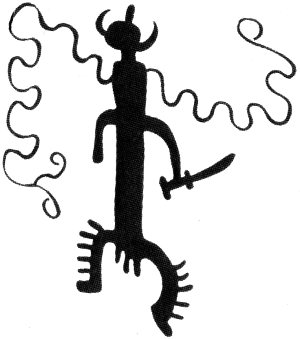
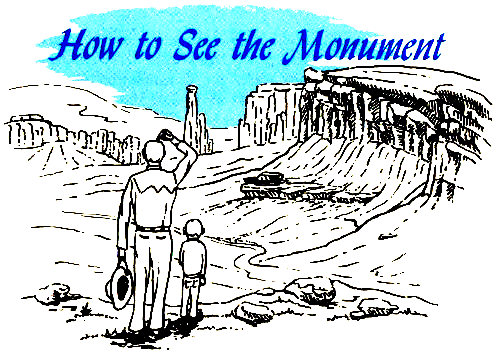
How to see the monument depends in large part on how long you can stay, but it depends also upon the direction you are travelling to or through Grand Junction and Fruita, and on the mode of transportation. Moreover, the Monument has four entrances—two main entrances from Fruita (West Entrance) and Grand Junction (East Entrance), and two subordinate entrances from the Glade Park area to the southwest.
Though by no means as well known as our large National Parks, Colorado National Monument is more readily accessible than many. It is on two transcontinental highways (U.S. 6 and 50), is the western terminus of U.S. 24, and is on nearly completed Interstate 70, one of the most scenic transcontinental Interstate Highways. Highway I-70 supersedes many stretches of U.S. 6, 24, and 50, but the latter are still used in parts of the Grand Valley and elsewhere. The Monument also is on the main line of the Denver and Rio Grande Western Railroad, which still maintains limited passenger service between Denver and Salt Lake City, but this service may eventually be terminated. Grand Junction’s Walker Field is served by several airlines, and both Grand Junction and Fruita are served by busses.
Many people driving through the Grand Valley for the first time are unaware of the Monument’s existence unless they happen to see it on a roadmap or see road signs pointing toward it, but unfortunately the signs are unevenly and poorly distributed. People entering Grand Junction from the east on U.S. 6 and 24 or from the southeast on U.S. 50 are apt to see one or more of the signs—particularly when crossing Grand 86 Avenue on First or Fifth Streets. If they are heading westward and can devote at least half a day, they may drive to the East Entrance, follow Rim Rock Drive for 22 miles northwestward through the Monument, stop at some or most of the scenic overlooks and the Visitor Center, leave via the West Entrance, and proceed northwestward on U.S. 6 and 50 or better yet on I-70. However, as will be described below, longer stops are much more rewarding. Those driving eastward on I-70 may see the sign at the Fruita interchange pointing southward toward the Monument—and may take the above described quickie trip in reverse. Those heading northwestward on I-70, however, may not be aware of the Monument until they see the sign at the Fruita interchange; then, they may not have or take time to double back southeastward through the Monument. If they do drive southeastward through the Monument, however, they can return to Fruita following a very scenic northwesterly route through The Redlands on Broadway (Colo. Highway 340) and South Broadway, or they may take a paved shortcut from near the East Entrance to South Broadway via South Camp Road (p. 118). Drinking water and sanitary restrooms are available in the headquarters area in the campgrounds and picnic grounds and Visitor Center, and in the Devils Kitchen Picnic Area. Food is not available in the Monument, so those planning to remain all day should bring lunches.
I have conducted many groups through the Monument, always choosing to travel northwestward from Grand Junction through The Redlands, just northeast of the Monument, to the West Entrance, then returning southeastward through the Monument.[33] On most days, taking the trip in these directions affords good lighting for photographing most of the scenic features. This and other routes are described in the next section and are plainly labeled so that the visitor may start with any trip he or she chooses. Regardless of how long you stay or which routes you follow, it is advisable to be well supplied with color film.
Some of the view points and overlooks have displays or signs to help interpret the scenic features, and more of these aids are added from time to time.
There are three maps in this report (figs. 3, 8, 26); these maps will be helpful to anyone touring the Monument. Figure 3 shows streams, highways and roads, principal trails, named features, overlooks, and trip-guide locations; figure 8 is a geologic map; and figure 26 shows localities where most of the photographs were taken. In addition, topographic maps of the Monument and adjacent areas by the U.S. Geological Survey, scale 1:24,000, are available from several sources and are a considerable aid to visitors. In addition to cultural and drainage features, such maps show the exact shape of the land by means of contour lines, which are level lines that go in and out of canyons, around ridges, and so forth. A special map of the Colorado National Monument quadrangle is available also in a shaded relief edition, which gives a three dimensional effect by proper shading of canyons and ridges. Both types of maps are for sale at the Visitor Center, and these and adjacent quadrangles, such as the Grand Junction, Fruita, Glade Park, and Island Mesa, are sold at several engineering and stationery stores in Grand Junction and at the U.S. Geological Survey’s Map Distribution Office, Building 41, Federal Center, Denver, Colorado, 80225. The latter office and the Visitor Center also sell copies of my “Geologic Map of the Grand Junction area, Colorado,” published in 1963 as Miscellaneous Investigations Map I-404.
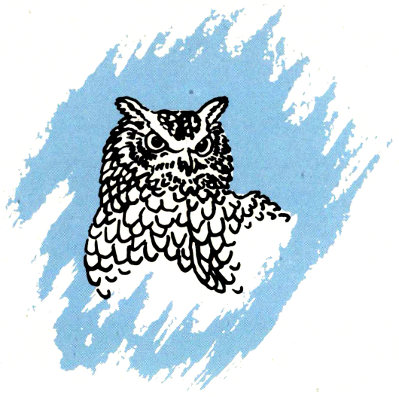
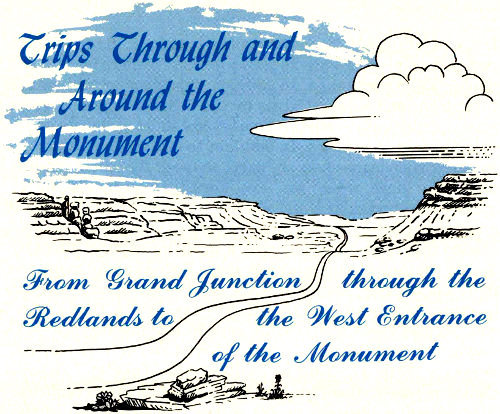
1
We will begin our trip in the southwestern part of Grand Junction at the intersection of First Street and Grand Avenue, (this is also the intersection of U.S. Highways 6 and 50 and Colorado Highway 340), by following a sign on Highway 340 pointing westward toward the Monument. After crossing a viaduct over the railroad yards and a bridge across the Colorado River, we come to a traffic light and a sign pointing left toward the Monument. The road to the left connects with Monument Road which leads up No Thoroughfare Canyon to the East Entrance. However, we will continue westward toward The Redlands.
2
Just beyond the stoplight we cross a bridge over the Redlands Power Canal which carries 675 cubic feet per second (cfs, or ft³s⁻¹)[35] from the Redlands Diversion Dam on the Gunnison River about 2½ miles south of Grand Junction. A quarter of a mile northwest of the bridge, most of the water falls to a lower powerplant that generates electricity for pumping the remaining 50 cfs to three lift canals, which are used mainly for irrigating peach orchards in the eastern part of The Redlands.
3
After Colorado Highway 340 curves right it is known as Broadway—a paved road serving much of The Redlands and connecting with the West Entrance of the Monument. We will follow Broadway about 3 miles, passing low outcrops and roadcuts of the Dakota Sandstone, some of which contain coal beds and some of which are covered by a veneer of gravel laid down by the river when the channel was higher. Then, at the first store and filling station we turn southwest on another paved road known as South Broadway.
4
Just around the curve to the right is a T-intersection from which paved South Camp Road leads south to a growing suburban area; and 2½ miles to the southeast it connects with Monument Road at a point only half a mile north of the East Entrance of the Monument.
Excellent views of the cliffs of dark Proterozoic rocks, the overlying cliffs of the Wingate Sandstone, and the Redlands fault along the northeastern border of the Monument are seen all along South Broadway, but views from South Camp Road and several connecting roads to the southwest are especially good. (See figs. 37 and 38.) As noted earlier, the Redlands fault has a maximum vertical displacement of 700 or 800 feet, but dies out in scissors fashion at each end.
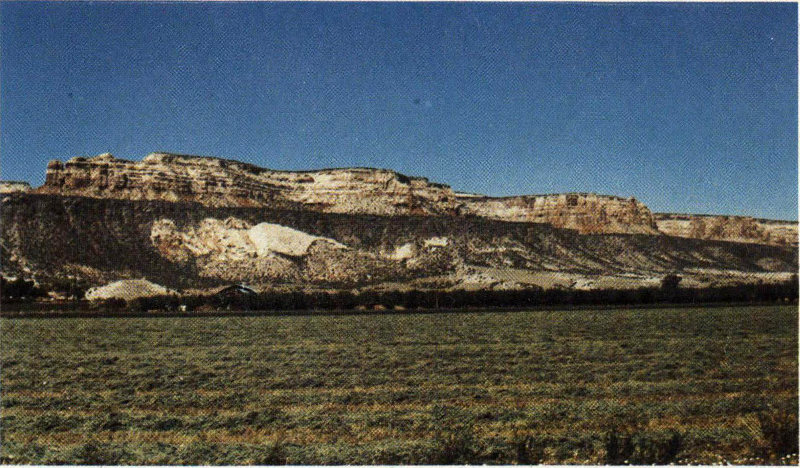
REDLANDS FAULT, looking west from South Camp Road about one mile south of South Broadway. Fault here is nearly vertical and normal, and lies between updragged Wingate Sandstone and dark Proterozoic schist, gneiss, and granite. All or most of the soft Chinle Formation has been squeezed out along the fault. Note smooth erosion surface atop hard, dark rocks surmounted by slope of red Chinle Formation and cliffs of Wingate Sandstone capped by lowermost resistant beds of Kayenta Formation. (Fig. 37)
5
As we continue westward on South Broadway, note on the right the brightly colored mudstone and siltstone of the Brushy Basin Member of the Morrison Formation strewn with large blocks of rusty-looking sandstone from the Burro Canyon Formation, which caps the high ridge on the right. Just above the deep cut on the right four-tenths of a mile west of the intersection with South Camp Road is a bronze plaque set in a masonry monument, whose lettering is easily readable in figure 39. Many years after the excavation in 1900 (fig. 22), Elmer Riggs contacted Al Look, of Grand Junction, in regard to the casting and erection of this plaque. Al, Elmer, Ed Faber, and a few other citizens put up the necessary funds and personally erected the plaque and monument. Somehow or other, Brachiosaurus was misspelled Brachyosaurus, as shown in figure 39, but the intentions were good. Later I will call attention to another similar monument commemorating the finding by Riggs of another dinosaur skeleton.

CLOSEUP OF UPDRAGGED WINGATE SANDSTONE ALONG REDLANDS FAULT, looking northwest from side road 1½ miles southwest of intersection of South Camp Road and South Broadway. White “pimple” atop cliff near left skyline is Liberty Cap, an erosional remnant of the Wingate Sandstone, reachable via the Liberty Cap Trail (fig. 3; and p. 108). Chinle Formation here was largely squeezed out along the fault. (Fig. 38)
After a sharp turn to the north and another to the west, South Broadway reaches the top of a hill just above the Elk’s Club and curves gently to the right past sandstone lenses in the Salt Wash Member of the Morrison Formation. A 610-foot-deep 91 well at the house on the left formerly flowed about 1½ gallons a minute from the Entrada and Wingate Sandstones.

BRONZE PLAQUE AND MONUMENT MARKING THE DISCOVERY OF BRACHIOSAURUS ALTITHORAX RIGGS, above roadcut on South Broadway four-tenths of a mile west of South Camp Road. See also figure 22. For discrepancy in spelling text. (Fig. 39)
6
Half a mile to the north, South Broadway turns sharply to the left even though another paved road continues northward. Three-fourths of a mile to the west, we turn northwestward parallel to the Monument boundary fence for seven-tenths of a mile before turning north again. The 7-foot chain-link fence just to the left of the road is the northeastern boundary of the Monument and encloses the herd of buffalo. In the late forties or early fifties a young bull challenged the older leader for possession of the herd and gored and pounded the old bull so badly he had to be shot by a ranger. During the furious battle 125 feet of this strong steel fence was utterly demolished. It is reported that sometimes an old bull simply takes one look at the young challenger and retreats without a battle, but other lone or rogue bulls may temporarily or permanently leave the herd for other reasons. Such outcasts are dangerous and unpredictable. One bull kept a ranger “treed” for 4 hours on a steep rock ledge in the broiling sun before moving on to a patch 92 of grass. Four of these critters delayed by one week my walking out a stretch of the Redlands fault on their side of the fence. I decided that a live geologist had advantages over a dead hero.
7
Throughout most of its 6-mile length the Redlands fault is a vertical or nearly vertical normal fault, but along and near this 0.7-mile stretch it is a reverse fault that dips from 45° to 60° to the southwest, as shown in figure 40 and in the cross section of figure 8. Good views of the fault are seen all along the fence, but especially at points one-tenth and four-tenths of a mile northwest of the first turn, the second of which is shown in figure 40. Just after turning north on South Broadway, let us turn west a few hundred feet on paved Wingate Drive to see the northwest end of the Redlands fault, which passes through a col to the left of updragged remnants of the thinned red Chinle Formation and the Wingate Sandstone, as shown in figure 41.
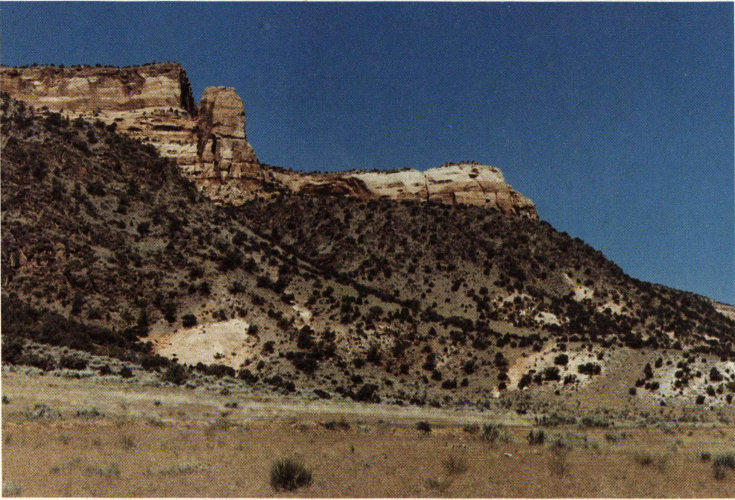
REVERSE PART OF REDLANDS FAULT, looking N. 65° W. from point on South Broadway along boundary fence. Most of Chinle Formation has been squeezed out, but lower part of Wingate Sandstone may be seen dipping about 45° southwestward beneath dark Proterozoic rocks. Next pink band to right is Entrada Sandstone. Jumbled mass of white sandstone slabs at right of photograph is part of Salt Wash Member of Morrison Formation and is known locally as “White Rock”. (Fig. 40)
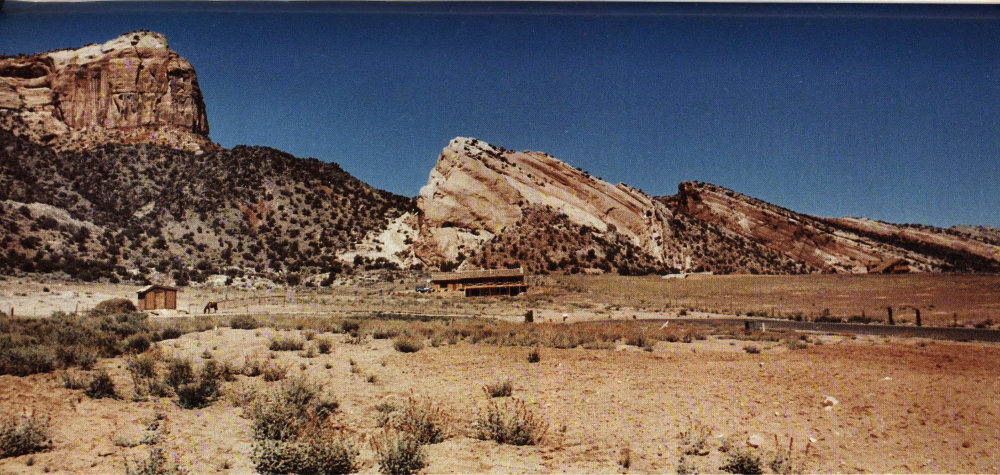
NORTHWEST END OF REDLANDS FAULT, passing through col to left of updragged remnants of Chinle Formation and Wingate Sandstone. Fault, which here is normal, ends against unbroken Lizard Canyon monocline in next canyon to northwest. Looking west from point just south of Wingate Drive a few hundred feet west of South Broadway. (Fig. 41)
About half a mile north of the last turn, South Broadway rejoins Broadway (Colo. Highway 340) at a stop sign. After we turn left on Broadway and reach the first curve, we get a nice view westward into Monument Canyon, as shown in figure 42. The Park Service hopes to establish a new trailhead at the bridge one-tenth of a mile west of the curve, from which a new section of trail will follow the normally dry wash southwestward to join the old Monument Canyon Trail. After we cross the creek leaving the canyon, we pass a low hill of the Salt Wash Member of the Morrison Formation on the left. Just beyond the hill, the dirt road leading southwest to a farmhouse formerly was the beginning of the Monument Canyon Trail (fig. 3). There is a new temporary trailhead a quarter of a mile north, but it is hoped that a permanent one can be built at the bridge about a quarter of a mile to the southeast, as noted above. Hikers may see buffalo along this trail and should watch out for outcast bulls.
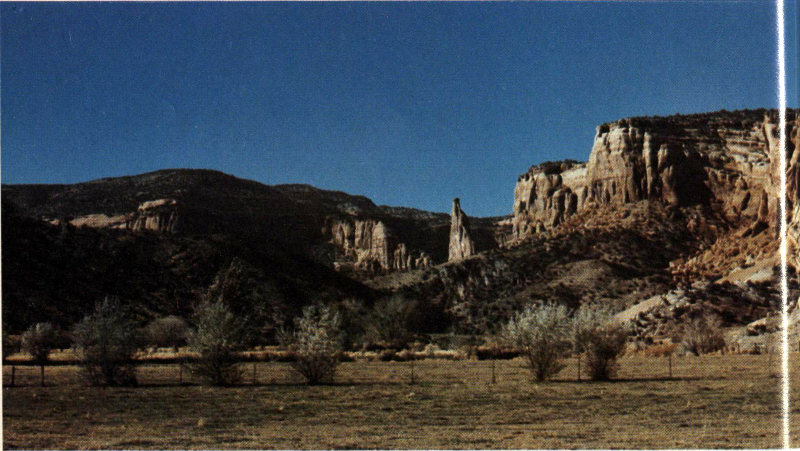
LOOKING WEST INTO MONUMENT CANYON, from curve on Broadway just northwest of end of South Broadway, showing Independence Monument. This monument was seen in figure 6 and will be seen again in figure 51. Redlands fault ends in this canyon; Lizard Canyon monocline can be seen on extreme right. (Fig. 42)
8
About half a mile north of the farm road we reach the highest point on Broadway (Colo. 340) at a drainage divide. Inasmuch as the three Redlands Lift Canals end east of the divide, there is quite a contrast between the lush irrigated lands east of the divide and the nearly barren desert to the west, a view of which 95 is shown in figure 43. To the southwest of the divide is an excellent view of the northeastward-dipping beds on the Lizard Canyon monocline. On the left about a mile northwest of the divide we pass the other entrance of Monument Canyon, then Lizard Canyon, and a switchback on Rim Rock Drive ascending the ridge between Lizard and Fruita Canyons. The water well beneath elevated tank on left is 650 feet deep and formerly flowed at about half a gallon a minute from the Wingate Sandstone. Household needs are obtained by pumping.
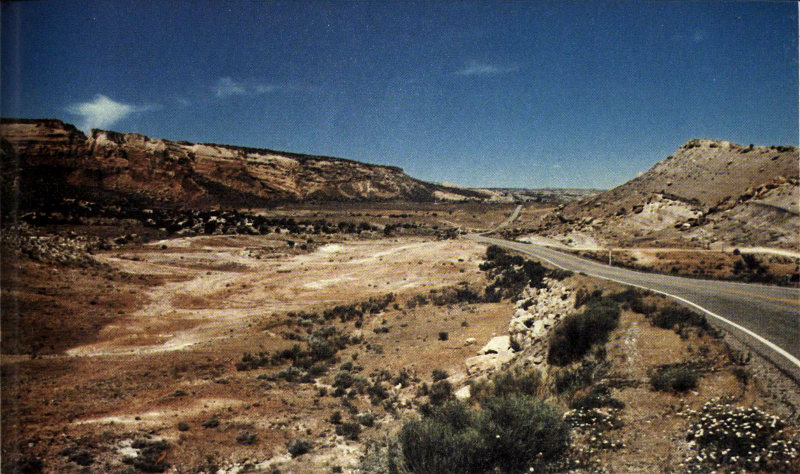
LOOKING WEST FROM DIVIDE ON BROADWAY 2 MILES EAST OF WEST ENTRANCE TO MONUMENT. Monoclinal hill on right is Brushy Basin Member of Morrison Formation capped by basal beds of Burro Canyon Formation. Rocks at left middle are blocks of sandstone in the Salt Wash Member of the Morrison. (Fig. 43)
At the next intersection, Colorado Highway 340 turns right and continues about 2½ miles to Fruita; the highway to the left reaches the West Entrance of the Monument in a quarter of a mile. Before turning left into the Monument, however, we will interrupt our description of the trip by making a new start from Fruita for the benefit of people travelling from this direction.
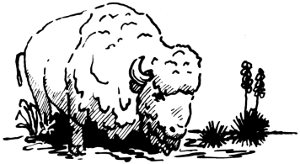

9
From the Fruita interchange on I-70, the overpass leads north into the town of Fruita, and Colorado Highway 340 leads south about 2½ miles to the West Entrance of Colorado National Monument. One mile south we cross the new bridge over the Colorado River; the old bridge formerly connecting Fruita with the Monument may be seen half a mile upstream. Just south of the new bridge we see sandstone on the left and green shale on the right, both part of the Burro Canyon Formation. The high hill on the left is made up of brightly colored siltstones and mudstones of the Brushy Basin Member of the Morrison Formation capped by the basal sandstone of the Burro Canyon Formation. On the southeast side of this hill is another bronze plaque set in a masonry monument, similar to the one at Riggs Hill (fig. 39), commemorating the discovery and removal in 1900 by Elmer S. Riggs of a skeleton of the immense dinosaur Apatosaurus excelcus Marsh. (See figure 23B). About 1¾ miles northwest of the new bridge is the Fruita Paleontological area discussed on page 50.
Just south of the hill, the highway curves gently to the left across a relatively flat surface of the Morrison Formation. To the right may be seen good exposures of the Entrada Sandstone, at the north end of which curbstones were quarried from thin beds of the white Moab Member for use in some of the parking areas along Rim Rock Drive. Some of the beds are ripple marked[36] from wave action along ancient beaches or within ancient lagoons. Some ripple-marked curbstones from this quarry may be seen in the parking area at Red Canyon Overlook, and elsewhere in the Monument.
As we approach the Monument we see that to the left the rock strata are bent downward toward us along what geologists call a monocline (see figs. 27 and 30), but to the right may be seen cliffs of dark Proterozoic rocks surmounted by slopes of the red Chinle Formation and cliffs of the buff Wingate Sandstone capped by the lowermost beds of the 97 resistant Kayenta Formation. The bent and broken rocks ahead are well shown in figure 33.
About 1½ miles south of the Colorado River we reach the T-intersection noted previously—at the end of the trip from Grand Junction through The Redlands to the West Entrance of the Monument—and we are ready for our trip through the Monument.
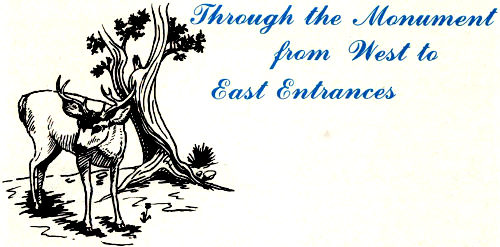
10
After turning south on Rim Rock Drive from the intersection with Colorado Highway 340 (Broadway), we cross the Monument’s northern boundary and reach the checking station at the West Entrance, where a small entry fee is charged during the summer. At the first left turn we are in red beds of the Chinle Formation, then in sheared and broken beds of the Wingate Sandstone along the Kodels Canyon fault. At the easternmost loop of the road we may look southeastward across Lizard Canyon to the Lizard Canyon monocline (fig. 30), and if we look down the slope to the east we will see one of John Otto’s well-built trails that formerly ascended the west side of Lizard Canyon to what is now the campground, long before Rim Rock Drive was built. Do not try to stop at the curve, however; play it safe, drive on, and park at Redlands View a quarter of a mile west.
By walking about 50 feet north of the turnout, we get an excellent view to the west of the Kodels Canyon fault, as shown in figure 31. Just to the north of the fault are the sheared and broken beds of the Wingate Sandstone along the east end of this fault.
Just beyond the turnout the road curves left through a cut in the Wingate Sandstone and ascends the east side of Fruita Canyon. About a quarter of a mile from the parking area we get a good view (fig. 44) to the west of the new earthfill on Rim Rock Drive between the two tunnels. The original fill was washed out in a few minutes on August 8, 1968, by a cloudburst that dumped an estimated 4 inches of rain on the mesa west of Fruita Canyon. A culvert beneath the road just north of the north tunnel was wholly unable to cope with the resulting flood, part of which plunged over the cliff but most of which roared southward through the tunnel. According to the only known eyewitnesses—a couple from Ohio whose car was stalled in 18 inches of swift water in the lower tunnel—an estimated 4 feet of water flowing through the north tunnel soon separated the two tunnels by a gaping chasm and flowed down where the fill had been but moments earlier. They jockeyed their car back and forth in the south tunnel and retraced the route back toward Fruita. Later I viewed the chasm from the portal of the north tunnel and found it awesome indeed.
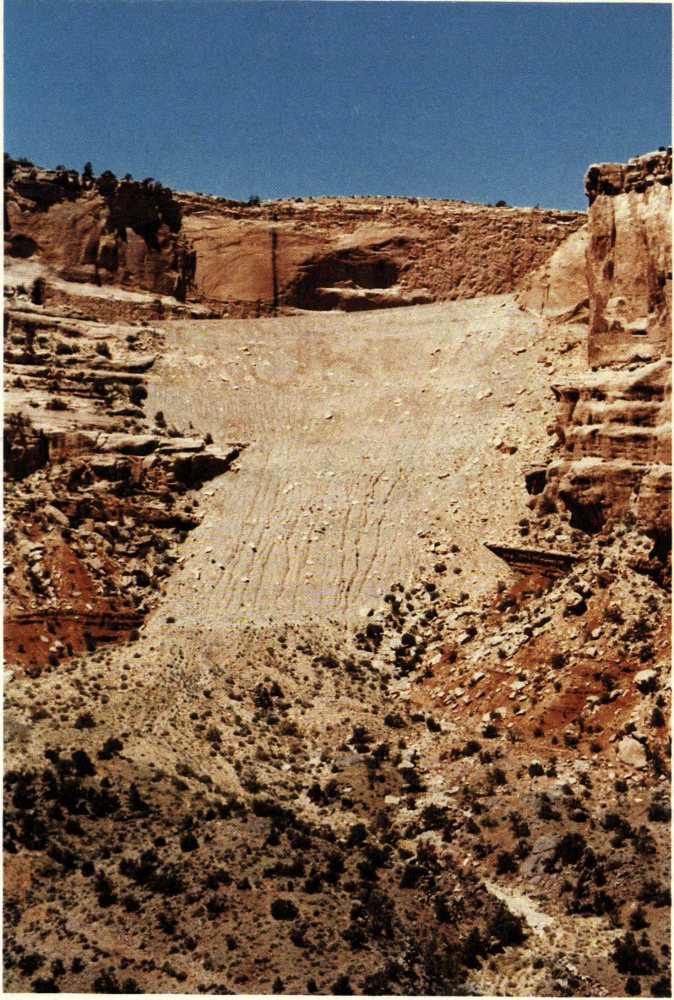
NEW FILL ON RIM ROCK DRIVE BETWEEN TWO TUNNELS ON WEST SIDE OF FRUITA CANYON, looking west from east side of canyon. Previous fill was washed out by flash flood, as described in text. (Fig. 44)

The road remained closed for 1½ years until December 20, 1969, much to the annoyance and discomfort of both visitors and Monument personnel—particularly the latter. During the summer, the usual 16-mile daily round trip to the post office in Fruita via the West Entrance was increased to about 80 miles by way of the East Entrance. During the school season, wives of Monument personnel took turns driving a station wagon full of children on two daily round trips to the schools and post office in Fruita. Note in figure 44, taken only 6½ years after the road was reopened, that small gullies already have been cut in the lower half of the new fill. Another local cloudburst could remove the new fill, but let us hope this does not happen!
On the next curve to the east the road cuts entirely through the red Chinle Formation, which here has a measured thickness of 103 feet.[37] From the base of the Chinle to about the creek crossing the road cuts expose the old Proterozoic metamorphic rocks, which here have a purple hue.
11
At the southernmost loop of the road is a parking area for viewing Balanced Rock. The photograph for the frontispiece was taken from the hillside near the foot of the monolith.
12
After the road turns north, we again cross the entire Chinle Formation, then penetrate the Wingate Sandstone through the two tunnels (turn on your lights) shown on all the maps and in figures 33 and 44. Just beyond the highest tunnel (turn off your lights) we reach Historic Trails View, with a sign noting the early expeditions that traversed the area. West from the parking area, but better yet by walking to the westernmost curve, may be seen the northern part of the Black Ridge Trail.

FRUITA CANYON, looking northeast from point on Rim Rock Drive above head of canyon. Dark Proterozoic rocks floor the canyon, above which are the slopes of the red Chinle Formation and the cliffs of Wingate Sandstone capped by the lower resistant beds of the Kayenta Formation. Beyond the Grand Valley are the dark Book Cliffs and the more distant, light-colored Roan Cliffs, which are shown more clearly in figure 48. (Fig. 45)
13
This foot trail is part of the old stock trail over which sheep and cattle once were driven down to the Grand Valley from Glade Park and Piñon Mesa. The road then winds upward through a series of switchbacks cut into the Kayenta Formation to Distant View and then to a parking spot at the relatively new Fruita Canyon View, which affords a splendid view of Fruita Canyon. Figure 45 was taken from a point about a tenth of a mile to the east. On the right are housing facilities for Monument personnel.
14
At the top of the hill just beyond the head of Fruita Canyon, two roads turn left; the first makes several loops through the modern campground and picnic area then returns to Rim Rock Drive; the second enters a large parking lot at the Visitor Center. Let us take the first road, then turn sharp to the left again just west of the Saddlehorn and explore the camp and picnic areas, which are on a gently sloping mesa of the Kayenta Formation dotted with piñon and juniper trees and bushes of many kinds. The Saddlehorn is an erosional remnant of the Entrada Sandstone. (See fig. 50.) The deluxe campground has both drive-through and back-in campsites, modern restrooms, tables, piped water, and grills. Two of the drive-through sites on the northernmost loop are shown in figure 46.
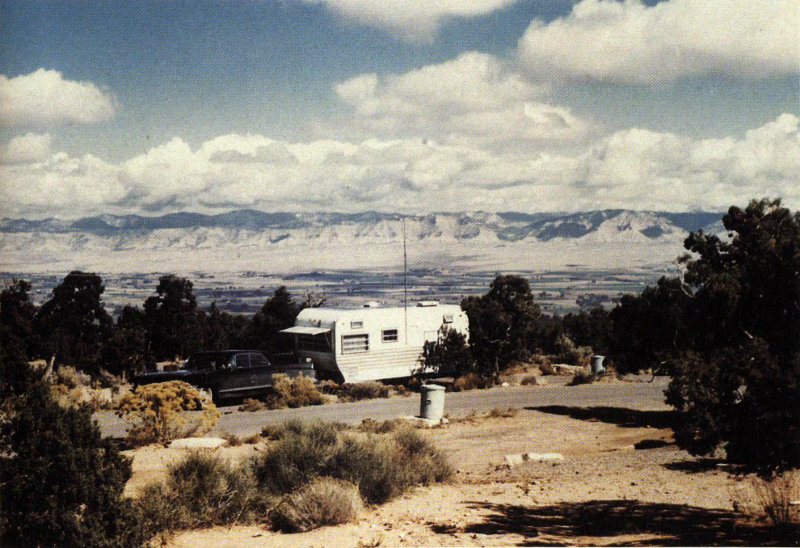
CAMPSITES AT NORTH END OF CAMPGROUND, Grand Valley and Book Cliffs beyond. (Fig. 46)
A view of the picnic area and parking lot is shown in figure 47. During the summer, evening slide talks are given by rangers at a small amphitheater just north of the Saddlehorn and to the left of the view shown in figure 47.
An interesting quarter-of-a-mile self-guiding Window Rock Nature Trail leads from the northeast corner of the campground to Window Rock and loops back past Book Cliffs View, which contains a table beneath a ramada. Window Rock Trail connects with the scenic Canyon Rim Trail, which leads southwestward to the Visitor Center. Views of Window Rock and Monument Canyon from Canyon Rim Trail are shown in figures 48 and 49.

PICNIC AREA AND PARKING LOT, looking northeast from top of the Saddlehorn. Large groups can be accommodated by making advance reservations. Cliff of Wingate Sandstone on right across Monument Canyon is part of Lizard Canyon monocline. (See fig. 29.) (Fig. 47)
After we return to Rim Rock Drive, a double left turn brings us to a large parking lot. We are now at the Visitor Center and Monument Headquarters, which is well worth a visit. In the front of the building are modern restrooms and a drinking fountain. Inside the lobby may be purchased film, slides, post cards, maps, booklets, and reports. A narrated slide show and museum help materially in conveying just what the Monument has to offer. I was pleased at being asked to contribute several of the geologic exhibits, partly with the aid of former Survey artist John R. Stacy. From the back door a path leads to a fenced overlook for viewing an arm of Monument Canyon. The overlook also is the beginning of Canyon Rim Trail which connects about half a mile to the northeast with Window Rock Trail at Book Cliff View.
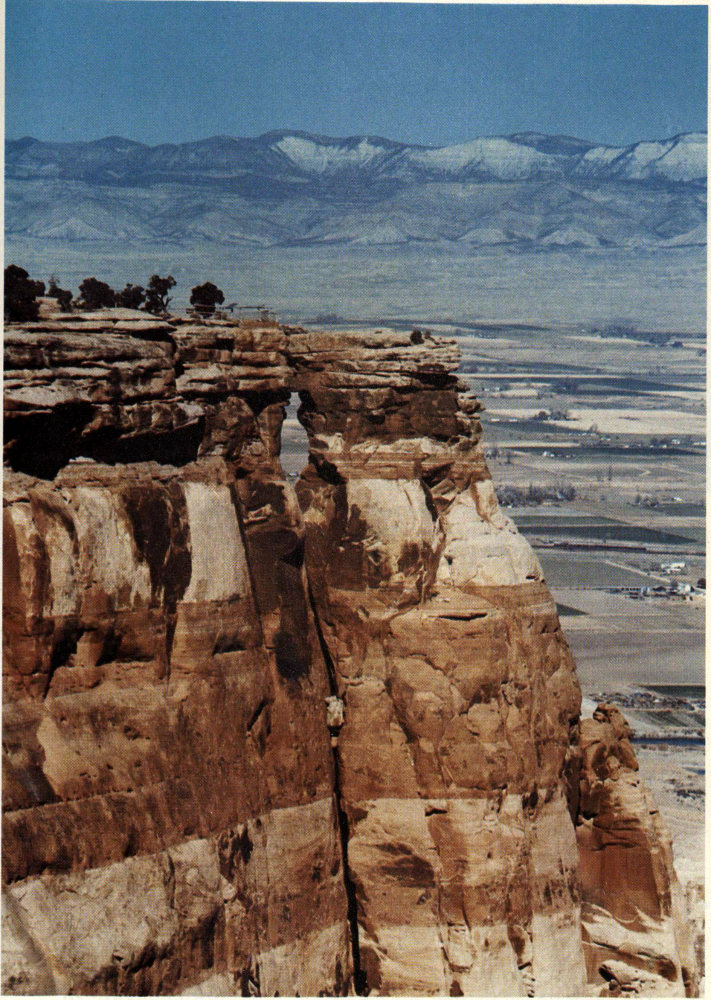
WINDOW ROCK, a window eroded along a vertical joint near the top of the Wingate Sandstone. Telephoto view looking northeast from Canyon Rim Trail. Note fenced overlook on Kayenta Formation to left of window to keep people from crossing joint above window, for someday the monolith to the right will fall, as did Fallen Rock (fig. 35). Note light-colored Roan Cliffs of Green River Formation beyond Book Cliffs. (Fig. 48)
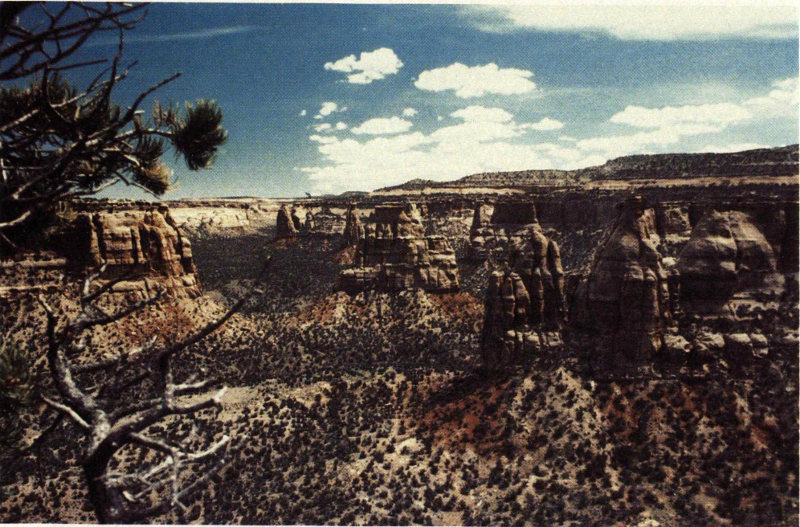
PIPE ORGAN, looking southeast across Monument Canyon from Canyon Rim Trail, and Independence Monument to left beyond. Photograph by Darrell Arnold, Grand Junction. (Fig. 49)
15
Half a mile southwest of the parking lot is one of the narrowest stretches of Rim Rock Drive at the edge of a Wingate cliff that actually overhangs. But do not worry, it is well protected by a rock wall. At the head of the canyon is a large jumbled landslide of the Morrison Formation that has covered the cliff of Entrada Sandstone. Along the narrow stretch and just beyond the landslide are excellent views on the right of the erosional unconformity between the eroded surface of the Kayenta Formation and the overlying Slick Rock Member of the Entrada Sandstone, a view of which is shown in figure 15 and a discussion of which is given on pages 35 to 39.
16
From the next parking area to the northeast at Pipe Organ Overlook we may hike half a mile over Otto’s Trail to an overlook of the Pipe Organ; a view of the Pipe Organ from the 105 northwest is shown in figure 49. From about the middle of this trail we may look to the northwest across the canyon to the Visitor Center and the Saddlehorn (fig. 50).
17
At the next parking area at Independence View we see Independence Monument (fig. 51) from quite a different angle than the photograph shown in figure 6. This view clearly shows it to be a thin erosional remnant of a narrow wall that once connected mesas to the northeast and southwest and which separated the two entrances of Monument Canyon.
18
Grand View, six-tenths of a mile farther southeast, affords excellent views of several features in and near Monument Canyon. A short improved trail to the northeast leads to a sandstone ledge from which the infrared photograph for the front cover was taken. The trail then veers eastward to a fenced cliff-top viewpoint from which one may look nearly straight down to a stretch of Monument Canyon Trail. You may see hikers on the trail or buffalo in the canyon. The photograph for figure 6 was taken from a point just north of the north end of the parking area.
19
Another 1⅓ miles takes us to the next parking area at Monument Canyon View, from which one may walk a short distance to the northeast. The photograph shown in figure 13 was taken from a point northeast of the parking area.
From the head of Fruita Canyon to Monument Canyon View, Rim Rock Drive is on a bench of the Kayenta Formation that separates the two lines of cliffs. We must now leave this bench, however, because from near Coke Ovens Overlook to beyond Artists Point the bench ceases to exist, and the Entrada, Kayenta, and Wingate form virtually a single cliff. Moreover, we must get up into the Morrison Formation in order to cross the divide between Monument and Ute Canyons. For these reasons, in the next three-quarters of a mile south of Monument Canyon View the road cuts upward through the entire Entrada Sandstone. Just beyond the first curve are quarries on the right from which curb and building stones were cut by the Civilian Conservation Corps in the 1930’s for protecting overlooks and narrow stretches of road. At the southwest end of this stretch is another parking area at Coke Ovens Overlook, which provides good views of the north side of the Coke Ovens.
20
The next parking area a quarter of a mile to the southwest is the Monument Canyon Trailhead of the long trail to the mouth of Monument Canyon and of a short trail to the Coke Ovens.
21
Half a mile to the southeast takes us to a large parking area at Artists Point, which offers a wide variety of scenic views. The best exposure of the Summerville Formation in the entire area that I mapped[38] is on the west side of the road, as shown in figure 20. A short trail leads down to a fenced overlook for viewing the Coke Ovens to the north (fig. 11) and Monument Canyon to the northeast.
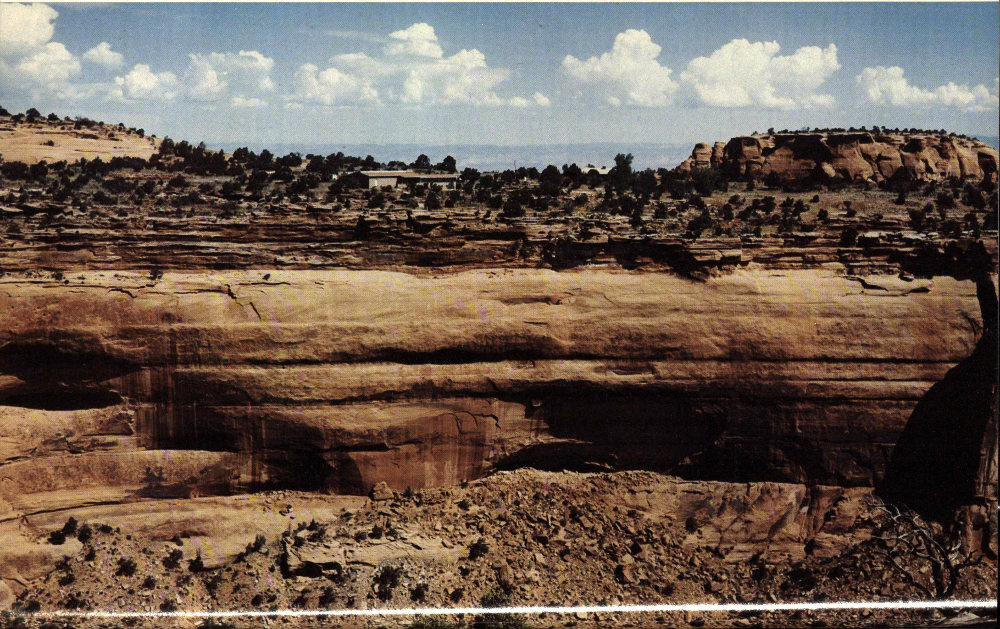
VISITOR CENTER AND THE SADDLEHORN, looking northwest across canyon from Otto’s Trail. Note thin-bedded bench of the Kayenta Formation separating cliffs of the Entrada Sandstone above the Wingate Sandstone below. The Saddlehorn is the remnant of the Entrada at the extreme right. (Fig. 50)
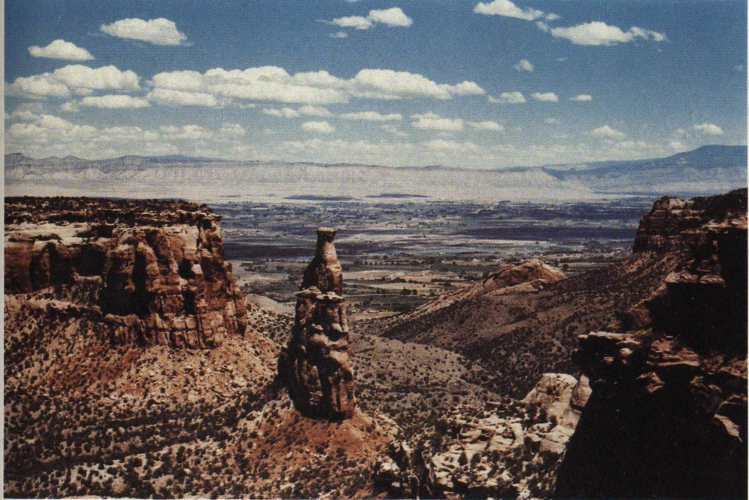
INDEPENDENCE MONUMENT, looking northeast from Independence View. Note updragged block of Wingate Sandstone at northwestern end of Redlands fault, just to the right of center. The other side of this block is shown in figure 41. Grand Mesa forms right skyline. (Fig. 51)
22
The Summerville Formation is exposed on the right for about the next half a mile. In the next three-quarters of a mile to Highland View the roadcuts are in the sandstone ledges of the Salt Wash Member of the Morrison Formation. Another half a mile through massive Salt Wash sandstones takes us to the second highest point on Rim Rock Drive—the divide between Monument and Ute Canyons, altitude 6,593 feet. From here we may look far to the south across Glade Park to high Piñon Mesa—the highest part of the Uncompahgre Plateau 108 northwest of Unaweep Canyon, where the altitude is about 9,500 feet.
23
Halfway down the hill to the south is a parking area on the left at the head of Liberty Cap Trail, which goes eastward about 6 miles to Liberty Cap—a prominent conical point atop the Wingate cliff just west of the mouth of Ute Canyon, which appears on the left skyline of figure 38. From there, the trail descends about 2 miles to a gate in the boundary fence at the mouth of Ute Canyon. The roads connecting the gate with South Camp Road (fig. 3) were reported (1979) to be closed to foot travel by private landowners, so hikers reaching this point must either retrace their steps to the parking area at the head of the Liberty Cap trail, or return by a primitive trail up main Ute Canyon, turn right up the west arm of the canyon, and regain Rim Rock Drive by a short switchback trail noted on page 109. However, the Park Service hopes that in the future some sort of corridor can be established to connect the trailhead with the nearby roads. Most of the “trail” up Ute Canyon is the normally dry channel of the creek, so hikers should watch out for flash floods. The round trip by Liberty Cap Trail alone is about 16 miles, and if the return trip is made by Ute Canyon the total distance is about 13 miles. Accordingly, hikers should allow a full day and carry food and water.
A quarter of a mile west of the Liberty Cap parking area in the west arm of Ute Canyon is a junction with a gravel road that leads 5 miles south to the Glade Park General Store and Post Office, where groceries, beer, gasoline, and fishing and camping supplies are available. Glade Park connects with scenic roads leading east, west, and south. Later, we will cover in more detail a round trip from the intersection in Ute Canyon to one near Cold Shivers Point, and another round trip from Glade Park around the head of No Thoroughfare Canyon and back to Grand Junction via the Little Park Road.
But to continue with the trip through the Monument—from the intersection with the gravel road to Glade Park, Rim Rock Drive turns abruptly to the southeast and follows the west arm of Ute Canyon for some 3 or 4 miles, past many interesting points. For the next 1⅓ miles to the first culvert, which crosses a large tributary, the roadcuts are in the Summerville Formation and Entrada Sandstone. The photographs in figures 16 and 17 were taken looking north from the culvert and from just northwest of the culvert, respectively.
24
One day when my family and I were approaching the culvert from the west, we heard a roar like an express train. Looking to the south we saw that a severe thundershower was occurring 109 on the headwaters in Glade Park, so we raced ahead and parked east of the culvert just in time to see and hear a 4-foot wall of red water come roaring down the tributary, rolling boulders along as if they were basketballs. Unfortunately, we had no time to ready or use a camera, so we simply raced down the road embankment and through the trees and brush to the north in time to see the flood plunge eastward over a 350-foot cliff of the Wingate Sandstone to the canyon below. This illustrates the need for caution when following or crossing “dry” washes in the desert in stormy weather or when there are storms in the distance.
25
About two-tenths of a mile northeast of the culvert is Upper Ute Canyon View, which affords good views of the northeast cliff face of the west arm of Ute Canyon.
26
For the next 7½ miles Rim Rock Drive is once again on a bench of the Kayenta Formation between cliffs of the Entrada and Wingate Sandstones. From Upper Ute Canyon View the road goes southeastward along the canyon rim about three-tenths of a mile to a parking area. A short trail leads down from the parking area to fenced Fallen Rock Overlook; the view shown in figure 35 is from this point. As noted in the caption of figure 35, and on page 108, the Ute Canyon Trail zigzags down the slope from the road a quarter of a mile southeast of the parking area, but there is no parking area at the trailhead, so it is safer to park at Fallen Rock Overlook and walk to the trailhead. The connection with this trail and the Liberty Cap Trail also is discussed on page 108. On one hike down this trail we saw two elk, which is a rare sight at such a low altitude, for they generally stay on or near Piñon Mesa.
27
About a mile to the southeast, just beyond the steep dropoff on the left, there is room to park, walk a short distance through the trees to the east, and observe a fine view of main Ute Canyon, as shown in figure 52. Just beyond on our right are the cliffs of the mottled salmon-and-white Slick Rock Member overlain by the all white Moab Member, as shown in figure 18 and described in the accompanying text.
Half a mile southeast, where the road makes a gentle U-turn and continues northeastward, we reach the highest point on Rim Rock Drive at an altitude of about 6,640 feet. Note that the piñon and juniper are larger, and the bushes are larger and greener at this altitude, for the average precipitation increases as we go higher.
28
About a mile northeast of the highest point on the road is a large parking area on the left, from which a short, shaded trail leads to a fenced overlook called Lower Ute Canyon View, which faces the northwest arm of Ute Canyon across the main canyon.

UTE CANYON, looking northeast from point described in text. Note grass-covered alluvium in distant part of canyon floor. (Fig. 52)
29
About half a mile beyond this parking area, we reach a small parking area at Red Canyon Overlook, from which the photograph shown in figure 12 was taken. The dark green bush of Mormon Tea in the right foreground of figure 12 is one of the largest I have seen in the Monument. The reasons for the differences between the left and right walls of the canyon are discussed on pages 79 and 80. The ripple-marked curbstones of white sandstone in the parking area were quarried from the Moab Member of the Entrada Sandstone northwest of Fruita Canyon, as noted on page 96.
30
Another 2½ miles around the south rim of Red Canyon and the head of Columbus Canyon takes us to the junction with the paved county road known as the DS Road, which leads south and southwest to Glade Park and to the head of No Thoroughfare Canyon. This important intersection will be included in trips through Glade Park and around the head of No Thoroughfare Canyon, so it will be discussed later. Meanwhile, we will continue our trip eastward from this intersection. About a third of a mile to the northeast is a large parking area, with a path leading to a fenced overlook at the rim of Columbus Canyon for viewing Cold Shivers Point—perhaps the most aptly titled feature in the Monument (fig. 53). A primitive path leads from the overlook to the toadstool-shaped platform at upper right, on which some visitors dare to stand, but not me. When the old, steep Serpents Trail was the only route for autos to ascend from the East Entrance, barrels of water were kept at this parking area to quench the thirst of boiling radiators.
31
After leaving the parking area, the downgrade on the Kayenta Formation begins to steepen to the northeast until it becomes advisable to shift into second gear. In about half a mile we descend a series of steep switchbacks cut into the Wingate Sandstone on the steepening Ladder Creek monocline (figs. 8, 29), and we reach the present upper end of the old Serpents Trail (fig. 54), which is now an interesting foot trail. As noted earlier, it is convenient to hike down this steep 2½-mile trail and to have one member of the party drive ahead and await the hikers at the parking area in the Devils Kitchen Picnic Area, near the foot of the trail. One of many rewarding views seen during the hike is shown in figure 55, another was seen in figure 10.
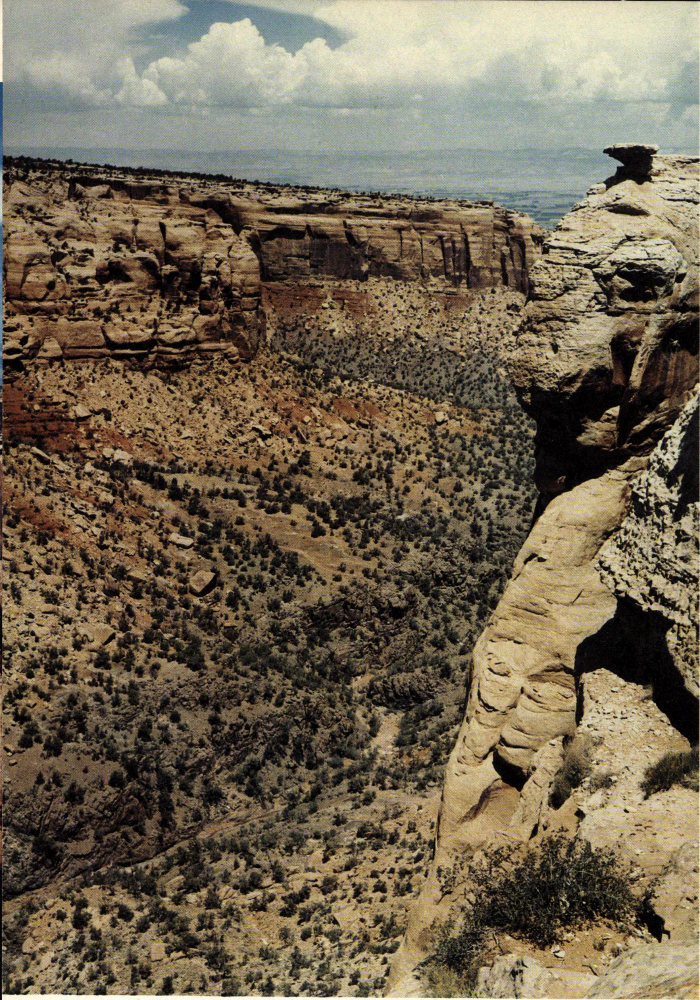
COLD SHIVERS POINT, looking north from fenced overlook on east edge of Columbus Canyon. Named feature is toadstool-shaped rock at upper right. Note dark Proterozoic rocks in canyon bottom. (Fig. 53)
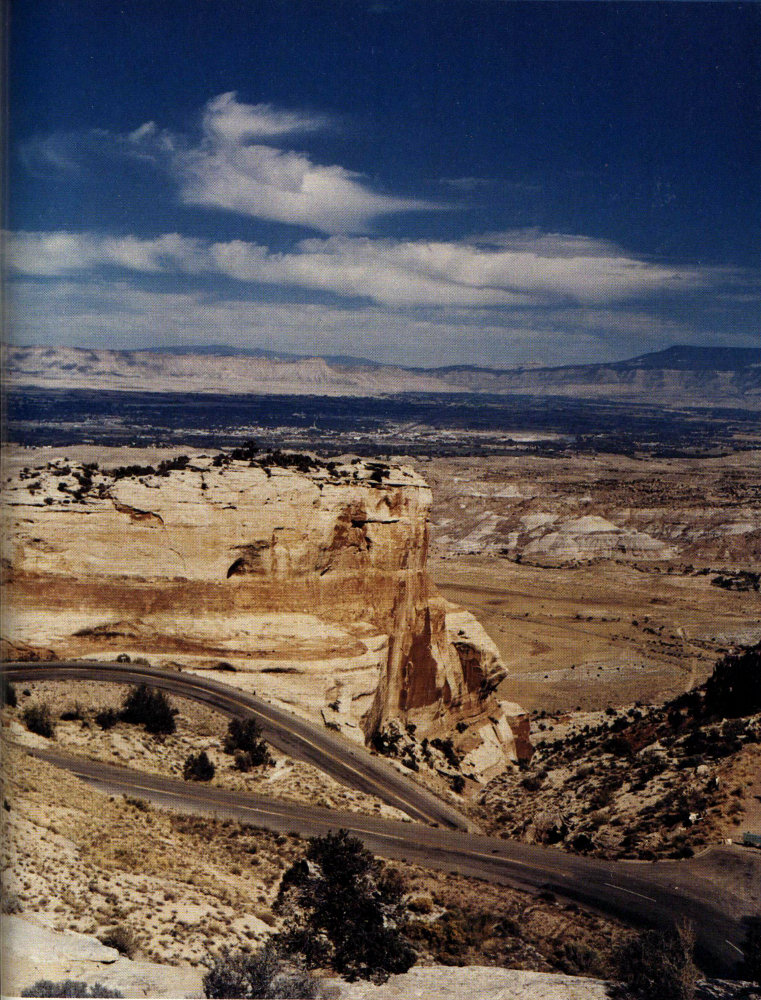
TOP OF OLD SERPENTS TRAIL, looking northeast from switchbacks above tunnel. Top of trail is seen at sign on lower right. Grand Mesa forms right skyline. (Fig. 54)

LOOKING NORTHEAST FROM OLD SERPENTS TRAIL, before 1950 when the trail was still used by autos and trucks. One of John Otto’s old foot trails joins the old road at lower middle. Although no thick lenses of sandstone appear in the Salt Wash Member of the Morrison Formation in figure 21, in this view a lens about 50 feet thick begins just around the corner near the base of the high bluff across No Thoroughfare Canyon and is seen extending as far to the left as the normally dry wash that drains the canyon. When water flows down the wash after thundershowers (see p. 118) or from melting snow, the sandstone lens takes in water (recharge) which moves slowly down the dip of the lens to the northeast and supplies several artesian wells. In turn, the light band of the Entrada Sandstone beneath the cottonwood trees at the right middle and the dark patch of Wingate Sandstone at the extreme lower right are recharged in like manner, and they supply water to artesian wells to the northeast. As the older and deeper sandstones on the right take in water at higher altitudes, the water in them is under greater artesian head when tapped by wells. If you think you see covered wagons near the middle of the photograph arranged in a circle for defense against attack by Indians, you are correct—a Western movie was about to be filmed. (Fig. 55)
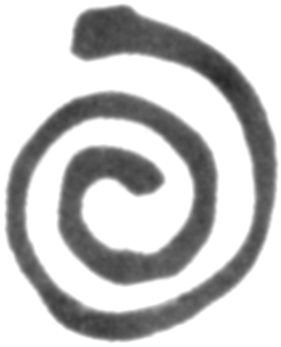
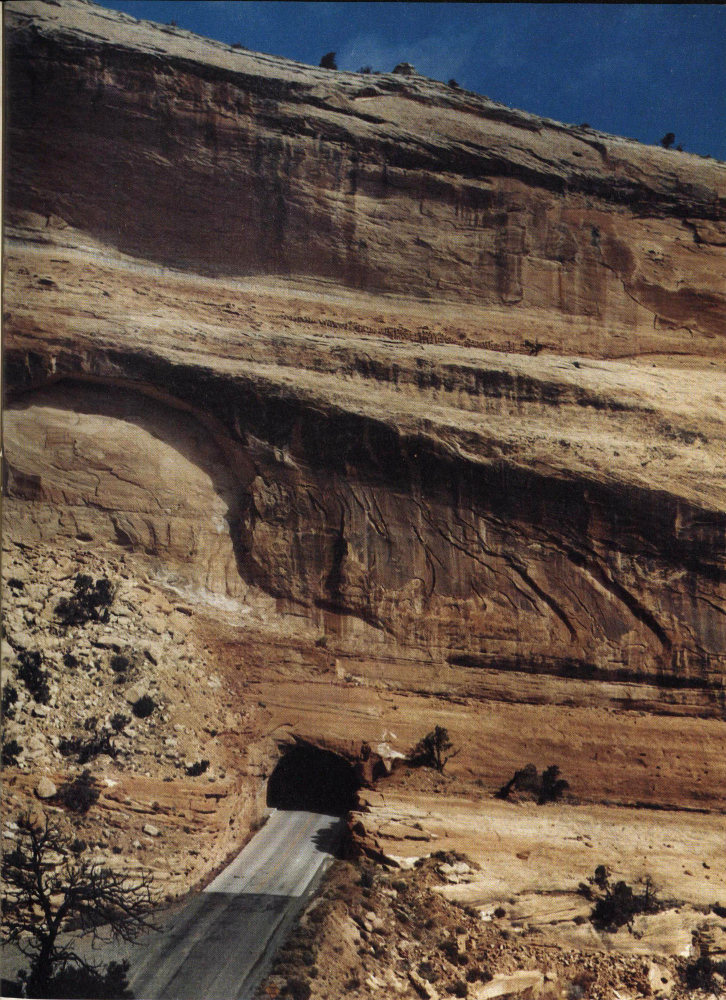
SOUTH PORTAL OF TUNNEL THROUGH WINGATE SANDSTONE, on west side of No Thoroughfare Canyon above East Entrance. (Fig. 56)
Just beyond the lowest switchback shown in figure 54, we penetrate the Wingate Sandstone through a tunnel, the south portal of which is shown in figure 56. After we drive through a deep cut in the Wingate Sandstone just south of the tunnel, we cross the entire red Chinle Formation, then descend a series of switchbacks in old Proterozoic rocks. The Chinle Formation is crossed again near the foot of the hill, where it is about 80 feet thick,[39] then we recross the Wingate Sandstone and Kayenta Formation to the parking area in the Devils Kitchen Picnic Area, near the foot of the old Serpents Trail.
32
An improved marked trail leads southward from parking area at the foot of the Serpents Trail, crosses No Thoroughfare Canyon, and continues as an unimproved trail to the Devils Kitchen, a view of which is shown in figure 57. The petroglyphs shown in figure 4 are northeast of this parking area. Those interested in seeing them should inquire at the ranger station or checking station at the East Entrance.
Just beyond the parking area, near the foot of the old Serpents Trail, a road turns left to a larger parking area for the Devils Kitchen Picnic Area, where covered tables, grills, and water are available. Just beyond we pass the checking station and housing facilities for Monument personnel at the East Entrance of the Monument. During the summer, fees are collected at this checking station from persons entering the Monument. A well just east of the housing area obtains water from the Entrada Sandstone to supply the houses and picnic area.
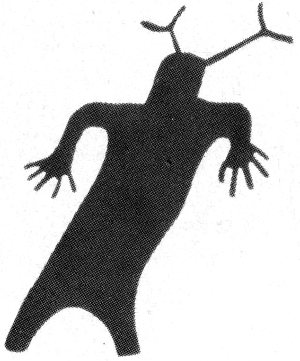

DEVILS KITCHEN, looking north from ridge in middle of No Thoroughfare Canyon. An erosional remnant of the Wingate Sandstone capped by the lowermost sandstone of the Kayenta Formation. Photograph by T. F. Giles, U.S. Geological Survey. (Fig. 57)

Three fourths of a mile beyond the checking station, South Camp Road turns left and joins South Broadway 2½ miles to the northwest. This provides a fine shortcut for persons desirous of travelling back northwestward through The Redlands to regain the West Entrance of the Monument. The intersection of South Camp Road and South Broadway, a key point on the trip “From Grand Junction through The Redlands to the West Entrance of the Monument,” is noted on page 89.
But let us continue our 3-mile return trip to Grand Junction, in order to point out several things of interest along Monument Road in the lower part of No Thoroughfare Canyon. As the canyon narrows just beyond the road intersection, we see on both sides colorful badlands of the Morrison Formation capped by the rusty looking basal sandstones of the Burro Canyon Formation. Behind the building on the right just before the road curves to the left is an artesian well 575 feet deep that taps both the Entrada Sandstone and a sandstone lens in the Morrison Formation[40].
33
About 2½ miles below the checking station, we pass on the left the basal sandstone of the Burro Canyon Formation resting on the Morrison Formation, as shown in the lower left of figure 24. Just beyond we may look up the hill to the left and see the 40-foot basal conglomerate of the Dakota Sandstone resting unconformably on an old erosion surface atop the Burro Canyon Formation.
Just before we reach the T-intersection with the eastern segment of South Broadway we may still see on the right some of the destruction caused by a devastating flood that roared down No Thoroughfare and other canyons on September 7, 1978, as a result of what was termed the worst cloudburst to hit Glade Park, the Monument, and the Grand Valley since 1958. A house on the flood plain just above the bridge was badly damaged and was filled with 4 feet of mud, and the Monument Road bridge across No Thoroughfare Canyon nearest the intersection was washed out, necessitating the rerouting of traffic to and from the East Entrance of the 119 Monument. Moral—never build a house or even pitch a tent in a dry wash or arroyo in desert regions! Incidentally, indirect measurements by engineers of the U.S. Geological Survey indicated a discharge of 9,290 cfs just above the washed out bridge in No Thoroughfare Canyon, and 2,980 cfs in Red Canyon beneath the Broadway bridge.
Inasmuch as the bridge on Monument Road has long since been rebuilt, we will cross it, turn right on South Broadway at the T-intersection, cross the Redlands Power Canal (p. 88), and join Colorado Highway 340 at the traffic light; thus, we complete a round trip “From Grand Junction through The Redlands to the West Entrance of the Monument,” “Through the Monument from West to East Entrances,” and “From the East Entrance to Grand Junction.”

34
A very pleasant 11-mile drive through Glade Park may be made from the intersection where Rim Rock Drive crosses the northwest arm of Ute Canyon (p. 108) to the intersection with the same drive on the rim of Columbus Canyon a quarter of a mile southwest of Cold Shivers Point (p. 120). The name Glade Park refers not only to the Store and Post Office mentioned earlier, but also to a nearly flat farming and ranching area south of the Monument—an area entirely different from the Monument or The Redlands. Most of the cultivated part of Glade Park is underlain by nearly flat lying Entrada Sandstone which was weathered to a sandy soil, but a few areas are underlain by the Morrison Formation. This drive should appeal particularly to people spending from a few days to a week or more in the campground. For the more adventuresome, other interesting roads join Glade Park from several directions, as noted below.
After leaving Rim Rock Drive at Ute Canyon, on a good 120 gravelled road, we traverse attractive, hilly, wooded country generally southward for about a mile and climb some 300 feet to a flat area covered mainly by sagebrush and grass. About 3 miles south of the intersection, we see on the left the leached white outcrops of the Entrada Sandstone shown in figure 19.
35
Another 2 miles takes us to the Glade Park Store and Post Office at a four-way intersection.
An improved, gravelled road leads westward through pleasant country some 20 miles to the Utah State line, beyond which an unimproved road leads either to the Colorado or the Dolores Rivers. Future planning calls for improving the Utah stretch of this road and for building a bridge across either the Colorado or Dolores Rivers to connect with scenic Utah Highway 128. If and when completed, this would afford a very scenic shortcut from Moab, Utah, to Grand Junction via the Little Park Road (to be described).
South from the four-way intersection an improved gravelled road takes us through wooded country, past lakes and campgrounds, to the summit of Piñon Mesa, as noted earlier.
36
Also, from the intersection a paved county road known as DS (south) Road leads eastward then northeastward through farming and ranching country 6 miles to the intersection with Rim Rock Drive near Cold Shivers Point. Three-fourths of a mile east of the Glade Park Store and Post Office the road crosses the Glade Park fault (fig. 8) along which the Morrison and Summerville Formations on the right have dropped down with respect to the Entrada Sandstone on the left. Here, the Entrada also has been leached to white.
37
At 1½ miles east of the Glade Park Store and Post Office is the intersection with the improved gravelled Little Park Road, which will be described later. At 2¾ miles beyond this intersection, the DS Road leaves the Entrada Sandstone and is on a wooded stretch of the Kayenta Formation the remaining 2 miles to Rim Rock Drive. The last one-tenth of a mile is crooked and steep, so please slow down before reaching the stop sign at the intersection. Some years ago the brakes on a pickup truck failed as the driver approached the stop sign, but he was lucky enough to jump out at the top of the cliff just before the truck plunged to the bottom of Columbus Canyon.

38
From the intersection 1½ miles east of the Glade Park Store and Post Office, let us turn southeast on the recently improved and gravelled Little Park Road around the head of No Thoroughfare Canyon, which was added to the Monument in 1978 (fig. 3). From the intersection it is about 14 miles to Grand Junction by this route. In half a mile we reach the new boundary of the Monument at a minor drainage divide, and as we start down a steep hill beyond we may park on the right and look southeastward across No Thoroughfare Canyon along the Glade Park fault (fig. 58) which has produced the fishtail shape of the head of the canyon, as shown in figures 8 and 59. A different view of the fault and canyon head is shown by the stereoscopic pair of aerial photographs in figure 59.
The Little Park Road closely follows the new Monument boundary around the south end of No Thoroughfare Canyon, either on the Kayenta Formation or Entrada Sandstone, and affords good views into the canyon from several places. East of the southeast arm of the canyon, the road leaves the boundary and goes northeastward about 4 miles to the end of the improved part of the road, but the unimproved part is good, and the lower 5 miles is paved. On my geologic maps[41] of the area, I called this road by its older name—the Jacobs Ladder Road.
39
About a quarter of a mile from the end of the improved stretch, one may turn right on two tire tracks, travel about a quarter of a mile farther, and park near the junction of Rough and Ladder Canyons, where interesting geology is reachable by short walks up Ladder Canyon or down Rough Canyon. 122 About a mile up Ladder Canyon is an interesting abandoned mica mine.[42]

GLADE PARK FAULT VIEWED FROM THE GROUND, crossing head of No Thoroughfare Canyon. Looking southeast from Little Park Road just southeast of new Monument boundary. Fault passes just to right of white cliff of Wingate Sandstone near bottom of photograph through notch in east wall of canyon. Note that surface to right (south) of fault has dropped about 50 feet below left side. Grand Mesa forms skyline. (Fig. 58)
From the left side of the road, about 9 miles northeast of our starting point, we see the view shown in figure 60. About 2 miles farther north, Little Park Road is paved through a suburban housing development all the way to The Redlands; there, we may turn right, cross the Gunnison River, and reach U.S. Highway 50; or we may turn left through Rosevale and reach Colorado Highway 340.
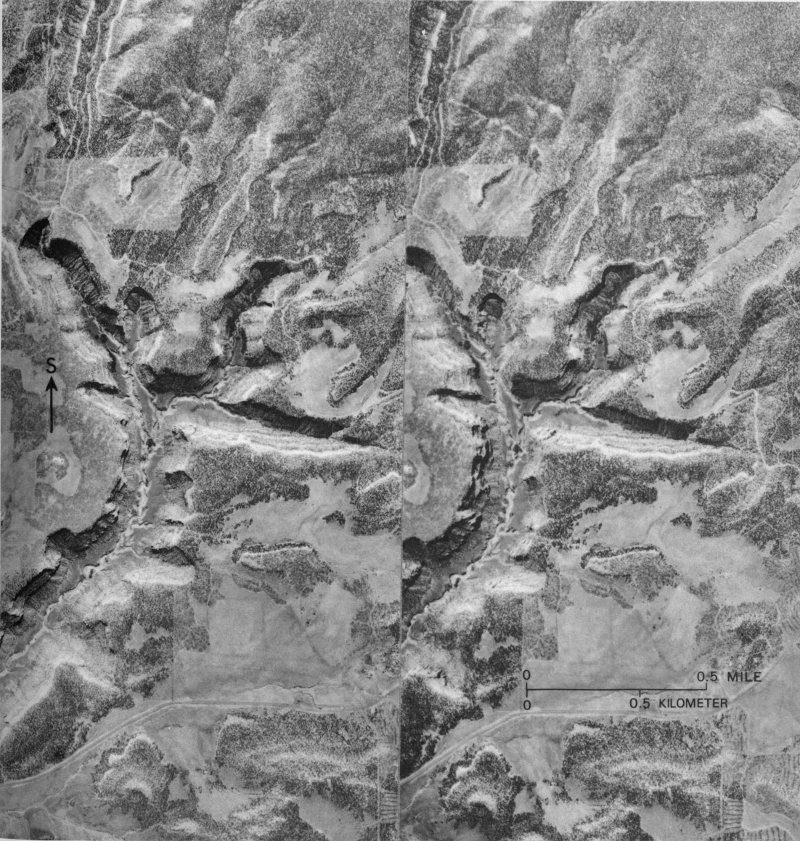
GLADE PARK FAULT VIEWED FROM THE AIR, crossing head of No Thoroughfare Canyon from left to right. Land south of the fault was dropped some 50 feet below that on the north side. Primitive road around head of canyon has been improved and realined since photographs were taken. The stereoscopic pair of aerial photographs may be viewed without optical aids by those accustomed to this procedure or by use of a simple double lens stereoscope, such as the folding ones used by the armed forces during and after World War II. Compare with the geologic map, figure 8. Photographs taken in 1937 by U.S. Soil Conservation Service. (Fig. 59)
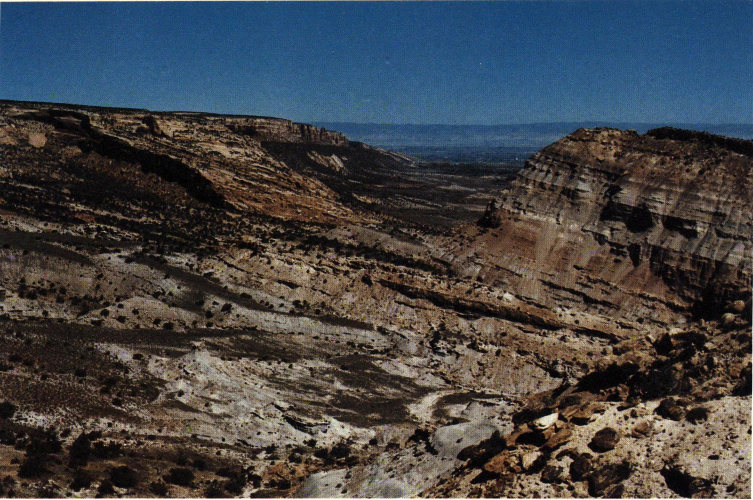
LADDER CREEK MONOCLINE AND REDLANDS FAULT, looking northwest from lookout point near Little Park Road. Telephoto view of left half of this scene is shown in figure 29; photograph of Morrison Formation shown in figure 21 was taken from point about a mile farther north. (Fig. 60)
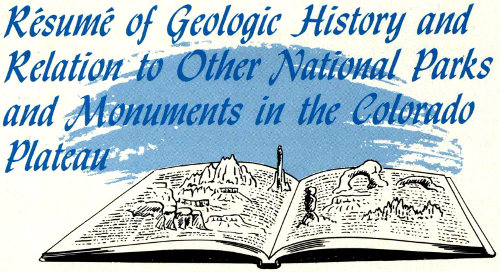
In the geologic story of the Monument discussed on pages 17 to 94, the geologic processes and events leading to the Monument of today were told in the order in which they occurred; therefore, the details of the geologic history have already been covered. Having finished this story and the trips through and around the Monument, let us see how the colorful canyons, cliffs, and other erosion forms fit into the bigger scheme of things—the geologic age and events of the Earth as a whole, as depicted in figure 61. As shown in figure 7, the rock strata still preserved in the Monument range in age from Proterozoic to Cretaceous, or from about 1,500 million to 100 million years old—a span of about 1,400 million years. This seems an incredibly long time, until one compares figures 7 and 61, and notes that the Earth is some 4,500 million years old, and that the rock pile in the Monument is only about a third the age of the Earth as a whole.

GEOLOGIC TIME SPIRAL, showing the sequence, names, and ages of the geologic periods and epochs, and the evolution of plant and animal life on land and in the sea. The primitive animals that evolved in the sea during the vast Archean and Proterozoic Eons left few traces in the rocks because they had not developed hard parts, such as shells, but hard-shell or skeletal parts became abundant during and after the Cambrian Period. This drawing was made when the Geological Survey and most others used the term Precambrian to embrace what is now included in the Archean and Proterozoic Eons. The end of the Archean Eon and beginning of the Proterozoic Eon has been placed at about 2,500 million years ago. Also, because of more recent radiometric dating, the ages of the boundaries between some of the geologic periods and epochs have been changed slightly. Of most concern to this report, the boundary between the Pliocene and Pleistocene Epochs has been changed from 3 million to 2 million years. Drawn by John R. Stacy originally for inclusion in a report by Newman (1976). (Fig. 61)
The Age of the Earth
The Earth is very old—4.5 billion years or more according to recent estimates. Most of the evidence for an ancient Earth is contained in the rocks that form the Earth’s crust. The rock layers themselves—like pages in a long and complicated history—record the surface-shaping events of the past, and buried within them are traces of life—the plants and animals that evolved from organic structures that existed perhaps 3 billion years ago.
Also contained in rocks once molten are radioactive elements whose isotopes provide Earth scientists with an atomic clock. Within these rocks, “parent” isotopes decay at a predictable rate to form “daughter” isotopes. By determining the relative amounts of parent and daughter isotopes, the age of these rocks can be calculated.
Thus, the results of studies of rock layers (stratigraphy), and of fossils (paleontology), coupled with the ages of certain rocks as measured by atomic clocks (geochronology), attest to a very old Earth!
But this is not the whole story. As indicated earlier, younger Mesozoic and Tertiary rocks more than 1 mile thick that once covered the area have been carried away by erosion, and, if we include these, the span is increased by another 50 million years or so.
If we consider the geologic formations that make up the national parks (N.P.), national monuments (N.M.) (excluding small historical or archaeological ones), Monument Valley, San Rafael Swell, and Glen Canyon National Recreation Area, all in the Colorado Plateau, it becomes apparent that certain formations or groups of formations play starring roles in some parks or monuments, some play supporting roles, and in a few places the entire cast of rocks gets about equal billing. Let us compare them and see how and where they fit into the “Geologic Time Spiral” (fig. 61).
Dinosaur N.M. and Colorado N.M., with exposed rocks ranging in age from Proterozoic to Cretaceous, cover the greatest time spans (nearly 2 billion years), but most of the rocks are missing at Colorado N.M., as noted below. Dinosaur N.M. has one unit—the Jurassic Morrison Formation—in the starring role, for this unit contains the many dinosaur fossils that give the monument its name and fame, although there are several older units in supporting roles. Grand Canyon N.P. is next, with rocks ranging in age from Proterozoic through Permian (excluding the Quaternary lava flows), but here is truly a team effort, for the entire cast gets about equal billing. Canyonlands N.P. stands third in this category, with rocks ranging from Pennsylvanian to Jurassic, but we would have to give top billing to the Permian Cedar Mesa Sandstone Member of the Cutler Formation, from which The Needles, The Grabens, and most of the arches were sculptured. The Triassic Wingate Sandstone and the Triassic(?) Kayenta Formation get second billing for their roles in forming and preserving Island in the Sky and other high mesas. Now let us consider other areas with only one or few players in the cast, beginning at the bottom of the time spiral. Black Canyon of the Gunnison N.M., cut entirely in rocks of early Proterozoic age with only a veneer of much younger rocks, obviously has but one star in its cast. Colorado N.M. contains rocks ranging from Proterozoic to Cretaceous (equal to Dinosaur in this respect), but Colorado is unique in that all rocks of the long Paleozoic Era and some others are missing from the cast. Of those that remain, the Triassic Wingate and the Triassic(?) Kayenta are the stars, 129 with strong support from the Jurassic Entrada Sandstone and from the Proterozoic rocks, which floor the U-shaped canyons.
All the bridges in Natural Bridges N.M. were carved from the Permian Cedar Mesa Sandstone Member of the Cutler Formation, also one of the stars in Canyonlands N.P. In Canyon de Chelly (pronounced dee shay) N.M. and Monument Valley (neither a national park nor a national monument, as it is owned and administered by the Navajo Tribe), the De Chelly Sandstone Member of the Cutler Formation—a Permian member younger than the Cedar Mesa—plays the starring role.
Wupatki N.M. near Flagstaff, Ariz., stars the Triassic Moenkopi Formation. Petrified Forest N.P. (which now includes part of the Painted Desert) has but one star—the Triassic Chinle Formation, in which are found many petrified logs and stumps of ancient trees. The Triassic-Jurassic Glen Canyon Group, which includes the Triassic Wingate Sandstone, the Triassic(?) Kayenta Formation, and the Triassic(?)-Jurassic Navajo Sandstone, receives top billing in recently enlarged Capitol Reef N.P., but the Triassic Moenkopi and Chinle Formations enjoy supporting roles.
The Triassic(?)-Jurassic Navajo Sandstone, which has a supporting role in Arches N.P., is the undisputed star of Zion N.P., Rainbow Bridge N.M., and Glen Canyon National Recreation Area. The Navajo also forms the impressive reef at the east edge of the beautiful San Rafael Swell, a dome, or closed anticline, now crossed by Highway I-70 between Green River and Fremont Junction, Utah.
As we journey upward in the time spiral (fig. 61), we come to the Jurassic Entrada Sandstone, which stars in Arches N.P., with help from the underlying Navajo Sandstone, and a supporting cast of both older and younger rocks. The Entrada also forms the grotesque erosion forms called “hoodoos and goblins” in Goblin Valley State Park, north of Hanksville, Utah.
Moving ever upward in the spiral, we come to the Cretaceous—the age of the starring Mesaverde Group, in which the caves of Mesaverde N.P. were formed, and which now house beautifully preserved ruins once occupied by the Anasazi (the ancient people who once dwelt in many parts of the Plateau).
This brings us up to the Tertiary Period, during the early part of which the pink limestones and shales of the Paleocene and Eocene Wasatch Formation were laid down in inland 130 basins. Beautifully sculptured cliffs, pinnacles, and caves of the Wasatch star in Bryce Canyon N.P. and in nearby Cedar Breaks N.M. This concludes our climb up the time spiral, except for Quaternary volcanos and some older volcanic features at Sunset Crater N.M., near Flagstaff, Ariz.
Thus, one way or another, many rock units formed during the last couple of billion years have performed on the stage of the Colorado Plateau and, hamlike, still lurk in the wings eagerly awaiting your applause to recall them to the footlights. Do not let them down—visit and enjoy the national parks and monuments of the Plateau, for they probably are the greatest collection of scenic wonderlands in the world.

I am grateful to many friends and colleagues not only for help on the present report, but also for help on the two preceding reports which made this one possible. I refer to my Professional Paper 451,[43] which supplied the detailed geologic data and to the first popular-style booklet.[44] First of all, I must acknowledge the great help rendered by members of my family—my eldest son Bill for serving as my unpaid field assistant for most of the detailed mapping of the Grand Junction area, and my two younger sons Terry and Bob for similar services during the last phases of the fieldwork. I am especially indebted to my wife Ruth for material assistance in all the fieldwork, including the road logging and the color photography for the present report.
I am grateful to several colleagues of the Geological Survey and National Park Service for help, data, or reviews of all three reports noted, and to members of my family for reviewing both popular-style reports.
For reviewing the present report I am especially indebted to David V. Harris, Emeritus Professor of Geology, Colorado State University; Harry A. Tourtelot, Geologist, U.S. Geological Survey, for reviewing both popular-style reports 131 and contributing petrographic studies to the detailed report; and to my wife, Ruth.
The comments and criticisms of all reviewers were carefully considered and most were adopted, but in some places I have preferred to state things in my own way, and have included topics that seemingly were of more interest to me than to some of the reviewers. The responsibility for the form and content of this report thus remains mine.

Listed below in alphabetical order are the reports referred to in this report. In the next section are listed reports for additional reading, which I hope will be of general interest to most readers of this report.

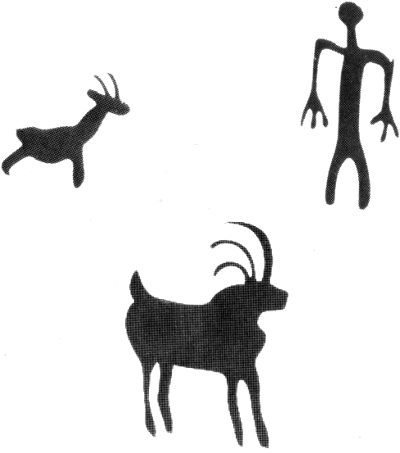
Italic page numbers indicate major references or pre-eminent views
A B C D E F G H I J K L M N O P Q R S T U V W X Y Z
Page
★ U.S. GOVERNMENT PRINTING OFFICE: 1981—778-836
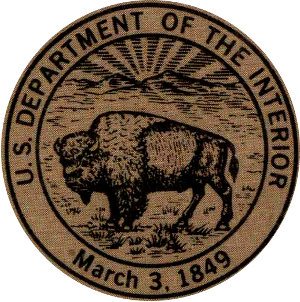
This eBook contains “relative” links to other Project Gutenberg eBooks. These links function correctly whether the books are read online, or installed on a local drive or a website.
To install these books in another file system, create a subdirectory for each eBook, as in this outline:
Each eBook is in a separate directory; its directory name is the Project Gutenberg number for the eBook.
Each eBook directory may contain files in various formats; only the HTML files are relevant here; other files are optional.
HTML files are in a subdirectory consisting of the Gutenberg number followed by “-h”.
The HTML file itself has a name consisting of the Gutenberg number followed by “-h”, with a file extension of “.htm”.
Associated media files (such as images, MIDI files, etc.) are contained in a further subdirectory “images”
To view these files, open any of the “*-h.htm” files in a web browser.